 | ÐлекÑÑоннÑй компоненÑ: AD6634PCB | СкаÑаÑÑ:  PDF PDF  ZIP ZIP |
Äîêóìåíòàöèÿ è îïèñàíèÿ www.docs.chipfind.ru
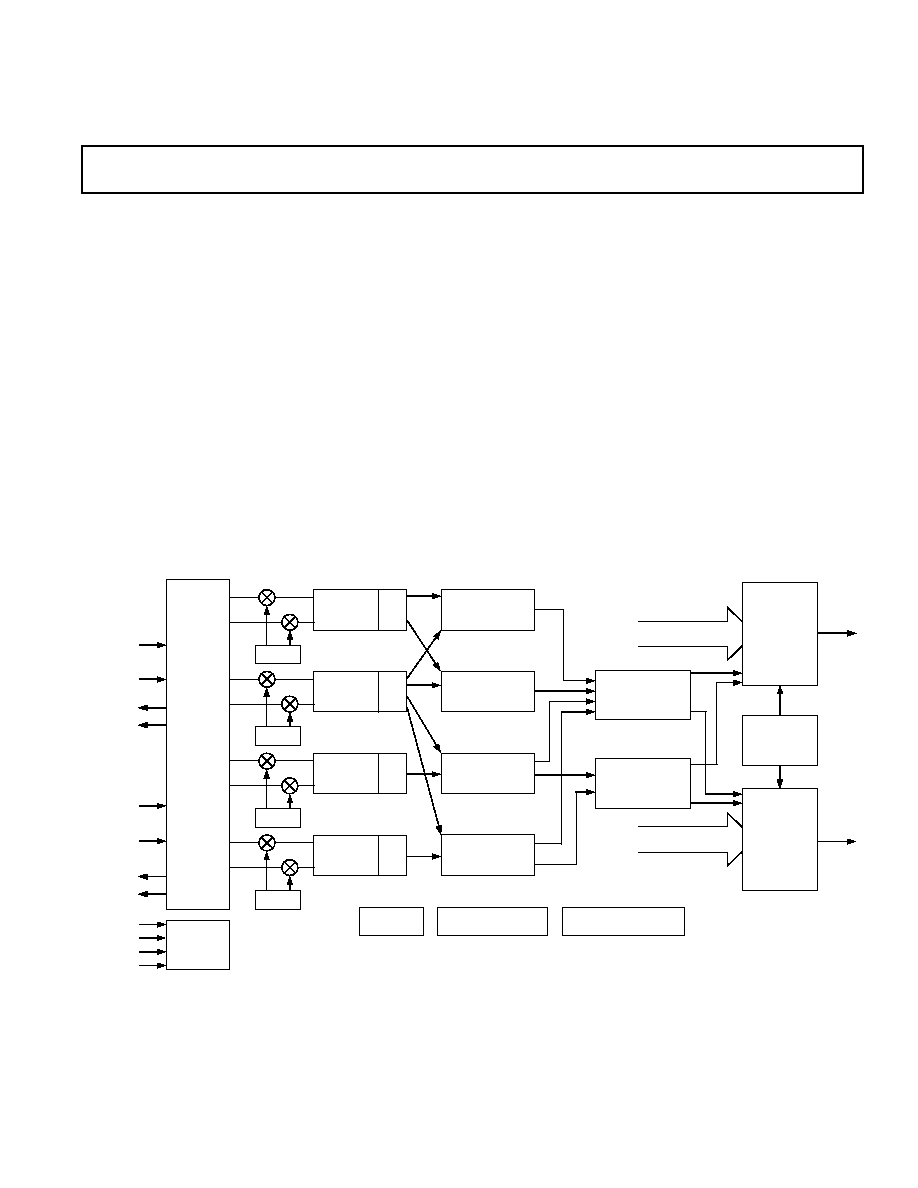
REV. 0
a
Information furnished by Analog Devices is believed to be accurate and
reliable. However, no responsibility is assumed by Analog Devices for its
use, nor for any infringements of patents or other rights of third parties that
may result from its use. No license is granted by implication or otherwise
under any patent or patent rights of Analog Devices.
One Technology Way, P.O. Box 9106, Norwood, MA 02062-9106, U.S.A.
Tel: 781/329-4700
www.analog.com
Fax: 781/326-8703
© Analog Devices, Inc., 2002
AD6634
80 MSPS, Dual-Channel WCDMA
Receive Signal Processor (RSP)
FEATURES
80 MSPS Wideband Inputs (14 Linear Bits Plus Three
RSSI)
Processes Two WCDMA Channels (UMTS or CDMA2000
1 ) or Four GSM/EDGE, IS136 Channels
Four Independent Digital Receivers in a Single Package
Dual 16-Bit Parallel Output Ports
Dual 8-Bit Link Ports
Programmable Digital AGC Loops with 96 dB Range
Digital Resampling for Noninteger Decimation Rates
Programmable Decimating FIR Filters
Interpolating Half-Band Filters
Programmable Attenuator Control for Clip Prevention
and External Gain Ranging via Level Indicator
Flexible Control for Multicarrier and Phased Array
3.3 V I/O, 2.5 V CMOS Core
User Configurable Built-In Self-Test (BIST) Capability
JTAG Boundary Scan
FUNCTIONAL BLOCK DIAGRAM
I
N
P
U
T
M
A
T
R
I
X
rCIC2
RESAMPLER
CIC5
RAM
COEFFICIENT
FILTER
CHANNEL 0
NCO
RCF OUTPUTS
CHANNELS 0, 1, 2, 3
PORT B
LINK PORT
OR
PARALLEL
PORT
INA[13:0]
EXPA[2:0]
IENA
LIA-A
LIA-B
INB[13:0]
EXPB[2:0]
LIB-A
LIB-B
IENB
SYNCA
SYNCB
SYNCC
SYNCD
EXTERNAL
SYNC.
CIRCUIT
rCIC2
RESAMPLER
CIC5
RAM
COEFFICIENT
FILTER
CHANNEL 1
NCO
rCIC2
RESAMPLER
CIC5
RAM
COEFFICIENT
FILTER
CHANNEL 2
NCO
rCIC2
RESAMPLER
CIC5
RAM
COEFFICIENT
FILTER
CHANNEL 3
NCO
JTAG
BUILT-IN (BIST)
SELF-TEST CIRCUITRY
MICROPORT OR SERIAL
PORT CONTROL
RCF OUTPUTS
CHANNELS 0, 1, 2, 3
PORT A
LINK PORT
OR
PARALLEL
PORT
OUTPUT
MUX
CIRCUITRY
INTERPOLATING
HALF-BAND FILTER
PLUS
DIGITAL AGC
INTERPOLATING
HALF-BAND FILTER
PLUS
DIGITAL AGC
APPLICATIONS
Multicarrier, Multimode Digital Receivers
GSM, IS136, EDGE, PHS, IS95, UMTS, CDMA2000
Micro and Pico Cell Systems, Software Radios
Wireless Local Loop
Smart Antenna Systems
In Building Wireless Telephony

REV. 0
2
AD6634
TABLE OF CONTENTS
USER CONFIGURABLE BUILT-IN SELF TEST (BIST) 31
RAM BIST . . . . . . . . . . . . . . . . . . . . . . . . . . . . . . . . . . . 31
Channel BIST . . . . . . . . . . . . . . . . . . . . . . . . . . . . . . . . . 31
CHIP SYNCHRONIZATION . . . . . . . . . . . . . . . . . . . . . . 32
Start . . . . . . . . . . . . . . . . . . . . . . . . . . . . . . . . . . . . . . . . . 32
Start with No Sync . . . . . . . . . . . . . . . . . . . . . . . . . . . . . . 32
Start with Soft Sync . . . . . . . . . . . . . . . . . . . . . . . . . . . . . 32
Start with Pin Sync . . . . . . . . . . . . . . . . . . . . . . . . . . . . . 32
Hop . . . . . . . . . . . . . . . . . . . . . . . . . . . . . . . . . . . . . . . . . 32
Set Freq No Hop . . . . . . . . . . . . . . . . . . . . . . . . . . . . . . . 33
Hop with Soft Sync . . . . . . . . . . . . . . . . . . . . . . . . . . . . . 33
Hop with Pin Sync . . . . . . . . . . . . . . . . . . . . . . . . . . . . . . 33
PARALLEL OUTPUT PORTS . . . . . . . . . . . . . . . . . . . . . 33
Channel Mode . . . . . . . . . . . . . . . . . . . . . . . . . . . . . . . . . 33
AGC Mode . . . . . . . . . . . . . . . . . . . . . . . . . . . . . . . . . . . 34
Master/Slave PCLK Modes . . . . . . . . . . . . . . . . . . . . . . . 35
Parallel Port Pin Functionality . . . . . . . . . . . . . . . . . . . . . 35
LINK PORT . . . . . . . . . . . . . . . . . . . . . . . . . . . . . . . . . . . . 35
Link Port Data Format . . . . . . . . . . . . . . . . . . . . . . . . . . 35
Link Port Timing . . . . . . . . . . . . . . . . . . . . . . . . . . . . . . . 36
TigerSHARC Configuration . . . . . . . . . . . . . . . . . . . . . . 36
MEMORY MAPS . . . . . . . . . . . . . . . . . . . . . . . . . . . . . . . . 36
0x000x7F: Coefficient Memory (CMEM) . . . . . . . . . . . 36
0x80: Channel Sleep Register . . . . . . . . . . . . . . . . . . . . . . 37
0x81: Soft_SYNC Register . . . . . . . . . . . . . . . . . . . . . . . . 37
0x82: Pin_SYNC Register . . . . . . . . . . . . . . . . . . . . . . . . 37
0x83: Start Hold-Off Counter . . . . . . . . . . . . . . . . . . . . . 37
0x84: NCO Frequency Hold-Off Counter . . . . . . . . . . . . 37
0x85: NCO Frequency Register 0 . . . . . . . . . . . . . . . . . . 37
0x86: NCO Frequency Register 1 . . . . . . . . . . . . . . . . . . 38
0x87: NCO Phase Offset Register . . . . . . . . . . . . . . . . . . 38
0x88: NCO Control Register . . . . . . . . . . . . . . . . . . . . . . 38
0x90: rCIC2 Decimation1 (M
rCIC2
1) . . . . . . . . . . . . . . 39
0x91: rCIC2 Interpolation1 (L
rCIC2
1) . . . . . . . . . . . . . . 39
0x92: rCIC2 Scale . . . . . . . . . . . . . . . . . . . . . . . . . . . . . . 39
0x93: . . . . . . . . . . . . . . . . . . . . . . . . . . . . . . . . . . . . . . . . 40
0x94: CIC5 Decimation1 (M
CIC5
1) . . . . . . . . . . . . . . . 40
0x95: CIC5 Scale . . . . . . . . . . . . . . . . . . . . . . . . . . . . . . . 40
0x96: . . . . . . . . . . . . . . . . . . . . . . . . . . . . . . . . . . . . . . . . 40
0xA0: RCF Decimation1 (M
RCF
1) . . . . . . . . . . . . . . . . 40
0xA1: RCF Decimation Phase (P
RCF
) . . . . . . . . . . . . . . . 40
0xA2: RCF Number of Taps Minus One (N
RCF
1) . . . . . 40
0xA3: RCF Coefficient Offset (CO
RCF
) . . . . . . . . . . . . . . 40
0xA4: RCF Control Register . . . . . . . . . . . . . . . . . . . . . . 40
0xA5: BIST Register for I . . . . . . . . . . . . . . . . . . . . . . . . 40
0xA6: BIST Register for Q . . . . . . . . . . . . . . . . . . . . . . . . 40
0xA7: BIST Control Register . . . . . . . . . . . . . . . . . . . . . . 41
0xA8: RAM BIST Control Register . . . . . . . . . . . . . . . . . 41
0xA9: Output Control Register . . . . . . . . . . . . . . . . . . . . 41
Memory Map for Input Port Control Registers . . . . . . . . . . 41
Input Port Control Registers . . . . . . . . . . . . . . . . . . . . . . 41
0x00 Lower Threshold A . . . . . . . . . . . . . . . . . . . . . . . . . 41
0x01 Upper Threshold A . . . . . . . . . . . . . . . . . . . . . . . . . 41
0x02 Dwell Time A . . . . . . . . . . . . . . . . . . . . . . . . . . . . . 41
0x03 Gain Range A Control Register . . . . . . . . . . . . . . . . 41
0x04 Lower Threshold B . . . . . . . . . . . . . . . . . . . . . . . . . 42
0x05 Upper Threshold B . . . . . . . . . . . . . . . . . . . . . . . . . 42
0x06 Dwell Time B . . . . . . . . . . . . . . . . . . . . . . . . . . . . . 42
0x07 Gain Range B Control Register . . . . . . . . . . . . . . . . 42
FEATURES . . . . . . . . . . . . . . . . . . . . . . . . . . . . . . . . . . . . . 1
APPLICATIONS . . . . . . . . . . . . . . . . . . . . . . . . . . . . . . . . . 1
GENERAL DESCRIPTION . . . . . . . . . . . . . . . . . . . . . . . . . 4
ARCHITECTURE . . . . . . . . . . . . . . . . . . . . . . . . . . . . . . . . 4
ABSOLUTE MAXIMUM RATINGS . . . . . . . . . . . . . . . . . 6
THERMAL CHARACTERISTICS . . . . . . . . . . . . . . . . . . . 6
EXPLANATION OF TEST LEVELS . . . . . . . . . . . . . . . . . 6
ORDERING GUIDE . . . . . . . . . . . . . . . . . . . . . . . . . . . . . . 6
RECOMMENDED OPERATING CONDITIONS . . . . . . . 7
ELECTRICAL CHARACTERISTICS . . . . . . . . . . . . . . . . . 7
GENERAL TIMING CHARACTERISTICS . . . . . . . . . . . . 8
MICROPROCESSOR PORT TIMING CHARACTERISTICS 9
TIMING DIAGRAMS . . . . . . . . . . . . . . . . . . . . . . . . . . . . 10
PIN CONFIGURATION . . . . . . . . . . . . . . . . . . . . . . . . . . 17
PIN FUNCTION DESCRIPTIONS . . . . . . . . . . . . . . . . . 18
EXAMPLE FILTER RESPONSE . . . . . . . . . . . . . . . . . . . 19
INPUT DATA PORTS . . . . . . . . . . . . . . . . . . . . . . . . . . . . 20
Input Data Format . . . . . . . . . . . . . . . . . . . . . . . . . . . . . . 20
Input Timing . . . . . . . . . . . . . . . . . . . . . . . . . . . . . . . . . . 20
Input Enable Control . . . . . . . . . . . . . . . . . . . . . . . . . . . . 20
Gain Switching . . . . . . . . . . . . . . . . . . . . . . . . . . . . . . . . . 21
Input Data Scaling . . . . . . . . . . . . . . . . . . . . . . . . . . . . . . 21
Scaling with Fixed-Point ADCs . . . . . . . . . . . . . . . . . . . . 21
Scaling with Floating-Point or Gain-Ranging ADCs . . . . 22
NUMERICALLY CONTROLLED OSCILLATOR . . . . . 22
Frequency Translation . . . . . . . . . . . . . . . . . . . . . . . . . . . 22
NCO Frequency Hold-Off Register . . . . . . . . . . . . . . . . . 23
Phase Offset . . . . . . . . . . . . . . . . . . . . . . . . . . . . . . . . . . . 23
NCO Control Register . . . . . . . . . . . . . . . . . . . . . . . . . . . 23
Bypass . . . . . . . . . . . . . . . . . . . . . . . . . . . . . . . . . . . . . . . 23
Phase Dither . . . . . . . . . . . . . . . . . . . . . . . . . . . . . . . . . . 23
Amplitude Dither . . . . . . . . . . . . . . . . . . . . . . . . . . . . . . . 23
Clear Phase Accumulator on HOP . . . . . . . . . . . . . . . . . . 23
Input Enable Control . . . . . . . . . . . . . . . . . . . . . . . . . . . . 23
Mode 00: Blank on IEN Low . . . . . . . . . . . . . . . . . . . . . . 23
Mode 01: Clock on IEN High . . . . . . . . . . . . . . . . . . . . . 23
Mode 10: Clock on IEN Transition to High . . . . . . . . . . 24
Mode 11: Clock on IEN Transition to Low . . . . . . . . . . . 24
WB Input Select . . . . . . . . . . . . . . . . . . . . . . . . . . . . . . . . 24
Sync Select . . . . . . . . . . . . . . . . . . . . . . . . . . . . . . . . . . . . 24
SECOND ORDER rCIC FILTER . . . . . . . . . . . . . . . . . . . 24
rCIC2 Rejection . . . . . . . . . . . . . . . . . . . . . . . . . . . . . . . . 25
Example Calculations . . . . . . . . . . . . . . . . . . . . . . . . . . . . 25
Decimation and Interpolation Registers . . . . . . . . . . . . . . 25
rCIC2 Scale . . . . . . . . . . . . . . . . . . . . . . . . . . . . . . . . . . . 25
FIFTH ORDER CIC FILTER . . . . . . . . . . . . . . . . . . . . . . 25
CIC5 Rejection . . . . . . . . . . . . . . . . . . . . . . . . . . . . . . . . 26
RAM COEFFICIENT FILTER . . . . . . . . . . . . . . . . . . . . . 27
RCF Decimation Register . . . . . . . . . . . . . . . . . . . . . . . . 27
RCF Decimation Phase . . . . . . . . . . . . . . . . . . . . . . . . . . 27
RCF Filter Length . . . . . . . . . . . . . . . . . . . . . . . . . . . . . . 27
RCF Output Scale Factor and Control Register . . . . . . . . 27
INTERPOLATING HALF-BAND FILTERS . . . . . . . . . . 28
AUTOMATIC GAIN CONTROL . . . . . . . . . . . . . . . . . . . 28
The AGC Loop . . . . . . . . . . . . . . . . . . . . . . . . . . . . . . . . 29
Desired Signal Level Mode . . . . . . . . . . . . . . . . . . . . . . . 29
Desired Clipping Level Mode . . . . . . . . . . . . . . . . . . . . . 31
Synchronization . . . . . . . . . . . . . . . . . . . . . . . . . . . . . . . . 31

REV. 0
AD6634
3
Memory Map for Output Port Control Registers . . . . . . . . . 45
0x08 Port A Control Register . . . . . . . . . . . . . . . . . . . . . . 45
0x09 Port B Control Register . . . . . . . . . . . . . . . . . . . . . . 45
0x0A AGC A Control Register . . . . . . . . . . . . . . . . . . . . . 45
0x0B AGC A Hold-Off Counter . . . . . . . . . . . . . . . . . . . 45
0x0C AGC A Desired Level . . . . . . . . . . . . . . . . . . . . . . . 45
0x0D AGC A Signal Gain . . . . . . . . . . . . . . . . . . . . . . . . 45
0x0E AGC A Loop Gain . . . . . . . . . . . . . . . . . . . . . . . . . 45
0x0F AGC A Pole Location . . . . . . . . . . . . . . . . . . . . . . . 45
0x10 AGC A Average Samples . . . . . . . . . . . . . . . . . . . . . 45
0x11 AGC A Update Decimation . . . . . . . . . . . . . . . . . . 46
0x12 AGC B Control Register . . . . . . . . . . . . . . . . . . . . . 46
0x13 AGC B Hold-Off Counter . . . . . . . . . . . . . . . . . . . . 46
0x14 AGC B Desired Level . . . . . . . . . . . . . . . . . . . . . . . 46
0x15 AGC B Signal Gain . . . . . . . . . . . . . . . . . . . . . . . . . 46
0x16 AGC B Loop Gain . . . . . . . . . . . . . . . . . . . . . . . . . 46
0x17 AGC B Pole Location . . . . . . . . . . . . . . . . . . . . . . . 46
0x18 AGC B Average Samples . . . . . . . . . . . . . . . . . . . . . 46
0x19 AGC B Update Decimation . . . . . . . . . . . . . . . . . . 46
0x1A Parallel Port Control A . . . . . . . . . . . . . . . . . . . . . . 46
0x1B Link Port Control A . . . . . . . . . . . . . . . . . . . . . . . . 47
0x1C Parallel Port Control B . . . . . . . . . . . . . . . . . . . . . . 47
0x1D Link Port Control B . . . . . . . . . . . . . . . . . . . . . . . . 47
0x1E Port Clock Control . . . . . . . . . . . . . . . . . . . . . . . . . 47
MICROPORT CONTROL . . . . . . . . . . . . . . . . . . . . . . . . 48
External Memory Map . . . . . . . . . . . . . . . . . . . . . . . . . . . 48
Access Control Register (ACR) . . . . . . . . . . . . . . . . . . . . 48
Microport Instructions . . . . . . . . . . . . . . . . . . . . . . . . . . . 48
Channel Address Register (CAR) . . . . . . . . . . . . . . . . . . . 49
SOFT_SYNC Control Register . . . . . . . . . . . . . . . . . . . . 49
PIN_SYNC Control Register . . . . . . . . . . . . . . . . . . . . . . 49
SLEEP Control Register . . . . . . . . . . . . . . . . . . . . . . . . . 49
Data Address Registers . . . . . . . . . . . . . . . . . . . . . . . . . . 49
Write Sequencing . . . . . . . . . . . . . . . . . . . . . . . . . . . . . . . 50
Read Sequencing . . . . . . . . . . . . . . . . . . . . . . . . . . . . . . . 50
Read/Write Chaining . . . . . . . . . . . . . . . . . . . . . . . . . . . . 50
Intel Nonmultiplexed Mode (INM) . . . . . . . . . . . . . . . . . 50
Motorola Nonmultiplexed Mode (MNM) . . . . . . . . . . . . 50
SERIAL PORT CONTROL . . . . . . . . . . . . . . . . . . . . . . . . 50
Serial Port Timing Specifications . . . . . . . . . . . . . . . . . . . 50
SDI . . . . . . . . . . . . . . . . . . . . . . . . . . . . . . . . . . . . . . . . . 50
SCLK . . . . . . . . . . . . . . . . . . . . . . . . . . . . . . . . . . . . . . . 50
JTAG BOUNDARY SCAN . . . . . . . . . . . . . . . . . . . . . . . . 51
INTERNAL WRITE ACCESS . . . . . . . . . . . . . . . . . . . . . . 51
Write Pseudocode . . . . . . . . . . . . . . . . . . . . . . . . . . . . . . 51
INTERNAL READ ACCESS . . . . . . . . . . . . . . . . . . . . . . . 52
Read Pseudocode . . . . . . . . . . . . . . . . . . . . . . . . . . . . . . . 52
OUTLINE DIMENSIONS . . . . . . . . . . . . . . . . . . . . . . . . . 52
TABLE OF CONTENTS (continued)

REV. 0
4
AD6634
GENERAL DESCRIPTION
The AD6634 is a multimode 4-channel digital receive signal pro-
cessor (RSP) capable of processing up to two WCDMA channels.
Each channel consists of four cascaded signal processing elements:
a frequency translator, two fixed coefficient decimating filters,
and a programmable coefficient decimating filter. Each input port
has input level threshold detection circuitry and an AGC con-
troller for accommodating large dynamic ranges or situations
where gain ranging converters are used. Dual 16-bit parallel output
ports accommodate high data rate WBCDMA applications. On-chip
interpolating half-band can also be used to further increase the
output rate. In addition, each parallel output port has a digital
AGC for output data scaling. Link port outputs are provided to
enable glueless interfaces to ADI's TigerSHARC
®
DSP core.
The AD6634 is part of Analog Devices' SoftCell
®
Multicarrier
transceiver chipset designed for compatibility with Analog Devices'
family of high sample rate IF sampling ADCs (AD9238/AD6645
12- and 14-bit). The SoftCell receiver comprises a digital receiver
capable of digitizing an entire spectrum of carriers and digitally
selecting the carrier of interest for tuning and channel selection.
This architecture eliminates redundant radios in wireless base
station applications.
High dynamic range decimation filters offer a wide range of
decimation rates. The RAM-based architecture allows easy
reconfiguration for multimode applications.
The decimating filters remove unwanted signals and noise from
the channel of interest. When the channel of interest occupies less
bandwidth than the input signal, this rejection of out-of-band
noise is called processing gain. By using large decimation factors,
this processing gain can improve the SNR of the ADC by 30 dB
or more. In addition, the programmable RAM coefficient filter
allows antialiasing, matched filtering, and static equalization func-
tions to be combined in a single, cost-effective filter. Half-band
interpolating filters at the output are used in WCDMA applications
to increase the output rate from 2
× to 4× of the chip rate. The
AD6634 is also equipped with two independent automatic gain
control (AGC) loops for direct interface to a RAKE receiver.
The AD6634 is compatible with standard ADC converters such
as the AD664x, AD923x, AD943x, and the AD922x families of
data converters. The AD6634 is also compatible with the AD6600
diversity ADC, providing a cost and size reduction path.
*TigerSHARC and SoftCell are registered trademarks of Analog Devices, Inc.
ARCHITECTURE
The AD6634 has four signal processing stages: a frequency
translator, second order resampling cascaded integrator comb
FIR filters (rCIC2), a fifth order cascaded integrator comb FIR
filter (CIC5), and a RAM coefficient FIR filter (RCF). Multiple
modes are supported for clocking data into and out of the chip
and provide flexibility for interfacing to a wide variety of digitizers.
Programming and control are accomplished via serial and/or
microprocessor interfaces.
Frequency translation is accomplished with a 32-bit, complex,
numerically controlled oscillator (NCO). Real data entering this
stage is separated into inphase (I) and quadrature (Q) components.
This stage translates the input signal from a digital intermediate
frequency (IF) to digital baseband. Phase and amplitude dither
may be enabled on-chip to improve spurious performance of the
NCO. A phase-offset word is available to create a known phase
relationship among multiple AD6634s or between channels.
Following frequency translation is a resampling, fixed coefficient,
high speed, second order, resampling cascade integrator comb
(rCIC2) filter that reduces the sample rate based on the ratio
between the decimation and interpolation registers.
The next stage is a fifth order cascaded integrator comb (CIC5)
filter whose response is defined by the decimation rate. The purpose
of this filter is to reduce the data rate to the final filter stage so
that it can calculate more taps per output.
The final stage is a sum-of-products FIR filter with program-
mable 20-bit coefficients, and decimation rates programmable
from 1 to 256 (132 in practice). The RAM coefficient FIR filter
(RCF in the Functional Block Diagram) can handle a maximum
of 160 taps.
The next stage is a fixed coefficient half-band interpolation filter
where data from different channels is combined together and
interpolated by a factor of 2. Next, an AGC section with a gain
range of 96.3 dB is available. This AGC section is completely
programmable in terms of its response. Two each of half-band
filters and AGCs are present in the AD6634, as shown in the
Functional Block Diagram. These half-band filters and AGC
sections can be bypassed independent of each other.
The overall filter response for the AD6634 is the composite of all
decimating and interpolating stages. Each successive filter stage is
capable of narrower transition bandwidths but requires a greater
number of CLK cycles to calculate the output. More decimation
in the first filter stage will minimize overall power consumption.
Data from the chip is interfaced to the DSP via either a high
speed parallel port or a TigerSHARC compatible link port.
Figure 1a illustrates the basic function of the AD6634: to select and
filter a single channel from a wide input spectrum. The frequency
translator tunes the desired carrier to baseband. Figure 1b shows
the combined filter response of the rCIC2, CIC5, and RCF.

REV. 0
AD6634
5
f
S
/2
3
f
S
/8
5
f
S
/16
f
S
/4
3
f
S
/16
f
S
/8
f
S
/16
dc
f
S
/16
f
S
/8
3f
S
/16
f
S
/4
5f
S
/16
3f
S
/8
f
S
/2
FREQUENCY TRANSLATION (e.g., SINGLE 1MHz CHANNEL TUNED TO BASEBAND)
AFTER FREQUENCY TRANSLATION
NCO "TUNES" SIGNAL TO BASEBAND
f
S
/2
3
f
S
/8
5
f
S
/16
f
S
/4
3
f
S
/16
f
S
/8
f
S
/16
dc
f
S
/16
f
S
/8
3f
S
/16
f
S
/4
5f
S
/16
3f
S
/8
f
S
/2
SIGNAL OF INTEREST "IMAGE"
SIGNAL OF INTEREST
WIDEBAND INPUT SPECTRUM
(
f
SAMPLE
/2 TO
f
SAMPLE
/2)
WIDEBAND INPUT SPECTRUM (e.g., 30MHz FROM HIGH SPEED ADC)
Figure 1a. Frequency Translation of Wideband Input Spectrum
1.5 10
4
kHz
20
dBc
0
20
40
60
80
100
120
1.0 10
4
5000
0
5000
1.0 10
4
1.5 10
4
Figure 1b. Composite Filter Response of rCIC2, CIC5, and RCF

REV. 0
6
AD6634
CAUTION
ESD (electrostatic discharge) sensitive device. Electrostatic charges as high as 4000 V readily
accumulate on the human body and test equipment and can discharge without detection. Although the
AD6634 features proprietary ESD protection circuitry, permanent damage may occur on devices
subjected to high energy electrostatic discharges. Therefore, proper ESD precautions are recommended
to avoid performance degradation or loss of functionality.
WARNING!
ESD SENSITIVE DEVICE
ABSOLUTE MAXIMUM RATINGS
*
Supply Voltage . . . . . . . . . . . . . . . . . . . . . . . . . . . . . . . . . 3.6 V
Input Voltage . . . . . . . . . . . . 0.3 V to +5.3 V (5 V Tolerant)
Output Voltage Swing . . . . . . . . . . 0.3 V to VDDIO +0.3 V
Load Capacitance . . . . . . . . . . . . . . . . . . . . . . . . . . . . 200 pF
Junction Temperature Under Bias . . . . . . . . . . . . . . . . . 125
°C
Storage Temperature Range . . . . . . . . . . . . 65
°C to +150°C
Lead Temperature (5 sec) . . . . . . . . . . . . . . . . . . . . . . 280
°C
*Stresses greater than those listed under Absolute Maximum Ratings may cause
permanent damage to the device. These are stress ratings only; functional
operation of the devices at these or any other conditions greater than those
indicated in the operational sections of this specification is not implied. Exposure
to absolute maximum rating conditions for extended periods may affect device
reliability.
ORDERING GUIDE
Model
Temperature Range
Package Description
Package Option
AD6634BBC
40
°C to +85°C (Ambient)
196-Lead CSPBGA (Ball Grid Array)
BC-196
AD6634BC/PCB
Evaluation Board with AD6634 and Software
THERMAL CHARACTERISTICS
196-Lead BGA:
JA
= 41
°C/W, No Airflow
JA
= 39
°C/W, 200-lfpm Airflow
JA
= 37
°C/W, 400-lfpm Airflow
Thermal measurements made in the horizontal position on a
4-layer board.
EXPLANATION OF TEST LEVELS
I.
100% Production Tested.
II.
100% Production Tested at 25
°C, and Sampled Tested at
Specified Temperatures.
III. Sample Tested Only
IV.
Parameter Guaranteed by Design and Analysis
V.
Parameter is Typical Value Only
VI.
100% Production Tested at 25
°C, and Sampled Tested at
Temperature Extremes

REV. 0
AD6634
7
SPECIFICATIONS
RECOMMENDED OPERATING CONDITIONS
Test
AD6634BBC
Parameter
Temp
Level
Min
Typ
Max
Unit
VDD
IV
2.25
2.5
2.75
V
VDDIO
IV
3.0
3.3
3.6
V
T
AMBIENT
IV
40
+25
+85
°C
ELECTRICAL CHARACTERISTICS
Test
AD6634BBC
Parameter (Conditions)
Temp
Level
Min
Typ
Max
Unit
LOGIC INPUTS (5 V Tolerant)
Logic Compatibility
Full
IV
3.3 CMOS
V
Logic "1" Voltage
Full
IV
2.0
5.0
V
Logic "0" Voltage
Full
IV
0.3
+0.8
V
Logic "1" Current
Full
IV
1
10
µA
Logic "0" Current
Full
IV
1
10
µA
Logic "1" Current (Inputs with Pull-Down)
Full
IV
Logic "0" Current (Inputs with Pull-Up)
Full
IV
Input Capacitance
25
°C
V
4
pF
LOGIC OUTPUTS
Logic Compatibility
Full
IV
3.3 CMOS/TTL
V
Logic "1" Voltage (I
OH
= 0.25 mA)
Full
IV
2.4
VDD0.2
V
Logic "0" Voltage (I
OL
= 0.25 mA)
Full
IV
0.2
0.4
V
IDD SUPPLY CURRENT
CLK = 80 MHz, (VDD = 2.75 V, VDDIO = 3.6 V) Full
IV
I
VDD
397
443
mA
I
VDDIO
50
58
mA
CLK = GSM Example (65 MSPS, VDD = 2.5 V,
VDDIO = 3.3 V, Dec = 2/10/6 120 Taps
Four Channels)
25
°C
V
I
VDD
TBD
mA
I
VDDIO
TBD
mA
CLK = WBCDMA Example (76.8 MSPS,
VDD = 2.5 V, VDDIO = 3.3 V, Dec = 2/10/6
120 Taps Four Channels)
25
°C
V
I
VDD
TBD
mA
I
VDDIO
TBD
mA
POWER DISSIPATION
CLK = 80 MHz
Full
IV
1.05
1.45
W
CLK = 65 MHz GSM/EDGE Example
V
840
mW
CLK = 76.8 MHz WBCDMA Example
V
1.2
W
Sleep Mode
Full
IV
287
µW
Specifications subject to change without notice.

REV. 0
8
AD6634
GENERAL TIMING CHARACTERISTICS
1, 2
Test
AD6634BBC
Parameter (Conditions)
Temp
Level
Min
Typ
Max
Unit
CLK TIMING REQUIREMENTS
t
CLK
CLK Period
Full
I
12.5
ns
t
CLKL
CLK Width Low
Full
IV
5.6
0.5
× t
CLK
ns
t
CLKH
CLK Width High
Full
IV
5.6
0.5
× t
CLK
ns
RESET TIMING REQUIREMENTS
t
RESL
RESET Width Low
Full
I
30.0
ns
INPUT WIDEBAND DATA TIMING REQUIREMENTS
t
SI
Input to
CLK Setup Time
Full
IV
2.0
ns
t
HI
Input to
CLK Hold Time
Full
IV
1.0
ns
LEVEL INDICATOR OUTPUT SWITCHING CHARACTERISTICS
t
DLI
CLK to LI (AA, B; BA, B) Output Delay Time
Full
IV
3.3
10.0
ns
SYNC TIMING REQUIREMENTS
t
SS
SYNC (A, B, C, D) to
CLK Setup Time
Full
IV
2.0
ns
t
HS
SYNC (A, B, C, D) to
CLK Hold Time
Full
IV
1.0
ns
SERIAL PORT CONTROL TIMING REQUIREMENTS
SWITCHING CHARACTERISTICS
2
t
SCLK
SCLK Period
Full
IV
16
ns
t
SCLKL
SCLK Low Time
Full
IV
3.0
ns
t
SCLKH
SCLK High Time
Full
IV
3.0
ns
INPUT CHARACTERISTICS
t
SSI
SDI to
SCLK Setup Time
Full
IV
1.0
ns
t
HSI
SDI to
SCLK Hold Time
Full
IV
1.0
ns
PARALLEL PORT TIMING REQUIREMENTS (MASTER MODE)
SWITCHING CHARACTERISTICS
3
t
DPOCLKL
CLK to PCLK Delay (Divide by 1)
Full
IV
6.5
10.5
ns
t
DPOCLKLL
CLK to PCLK Delay (Divide by 2, 4, or 8)
Full
IV
8.3
14.6
ns
t
DPREQ
CLK to PxREQ Delay
1.0
ns
t
DPP
CLK to Px[15:0] Delay
0.0
ns
INPUT CHARACTERISTICS
t
SPA
PxACK to
PCLK Setup Time
+7.0
ns
t
HPA
PxACK to
PCLK Hold Time
3.0
ns
PARALLEL PORT TIMING REQUIREMENTS (SLAVE MODE)
SWITCHING CHARACTERISTICS
3
t
POCLK
PCLK Period
Full
I
12.5
ns
t
POCLKL
PCLK Low Period (when PCLK Divisor = 1)
Full
IV
2.0
0.5
× t
POCLK
ns
t
POCLKH
PCLK High Period (when PCLK Divisor = 1)
Full
IV
2.0
0.5
× t
POCLK
ns
t
DPREQ
CLK to PxREQ Delay
10.0
ns
t
DPP
CLK to Px[15:0] Delay
11.0
ns
INPUT CHARACTERISTICS
t
SPA
PxACK to
PCLK Setup Time
1.0
ns
t
HPA
PxACK to
PCLK Hold Time
1.0
ns
LINK PORT TIMING REQUIREMENTS
SWITCHING CHARACTERISTICS
3
t
RDLCLK
PCLK to LxCLKOUT Delay
Full
IV
2.5
ns
t
FDLCLK
PCLK to LxCLKOUT Delay
Full
IV
0
ns
t
RLCLKDAT
LCLKOUT to Lx[7:0] Delay
Full
IV
0
2.9
ns
t
FLCLKDAT
LCLKOUT to Lx[7:0] Delay
Full
IV
0
2.2
ns
NOTES
1
All Timing Specifications valid over VDD range of 2.25 V to 2.75 V and VDDIO range of 3.0 V to 3.6 V.
2
C
LOAD
= 40 pF on all outputs unless otherwise specified
3
The timing parameters for Px[15:0], PxREQ, PxACK, LxCLKOUT, Lx[7:0] apply for port A and B (x stands for A or B).
Specifications subject to change without notice.

REV. 0
AD6634
9
MICROPROCESSOR PORT TIMING CHARACTERISTICS
1, 2
Test
AD6634BBC
Parameter (Conditions)
Temp
Level
Min
Typ
Max
Unit
MICROPROCESSOR PORT, MODE INM (MODE = 0)
MODE INM WRITE TIMING
t
SC
Control
3
to
CLK Setup Time
Full
IV
2.0
ns
t
HC
Control
3
to
CLK Hold Time
Full
IV
2.5
ns
t
HWR
WR(RW) to RDY(DTACK) Hold Time
Full
IV
7.0
ns
t
SAM
Address/Data to
WR(RW) Setup Time
Full
IV
3.0
ns
t
HAM
Address/Data to RDY(
DTACK) Hold Time
Full
IV
5.0
ns
t
DRDY
WR(RW) to RDY(DTACK) Delay
Full
IV
8.0
ns
t
ACC
WR(RW) to RDY(DTACK) High Delay
Full
IV
4
× t
CLK
5
× t
CLK
9
× t
CLK
ns
MODE INM READ TIMING
t
SC
Control
3
to
CLK Setup Time
Full
IV
5.0
ns
t
HC
Control
3
to
CLK Hold Time
Full
IV
2.0
ns
t
SAM
Address to
RD(DS) Setup Time
Full
IV
0.0
ns
t
HAM
Address to Data Hold Time
Full
IV
5.0
ns
t
DRDY
RD(DS) to RDY(DTACK) Delay
Full
IV
8.0
ns
t
ACC
RD(DS) to RDY(DTACK) High Delay
Full
IV
8
× t
CLK
10
× t
CLK
13
× t
CLK
ns
MICROPROCESSOR PORT, MODE MNM (MODE = 1)
MODE MNM WRITE TIMING
t
SC
Control
3
to
CLK Setup Time
Full
IV
2.0
ns
t
HC
Control
3
to
CLK Hold Time
Full
IV
2.5
ns
t
HDS
DS(RD) to DTACK(RDY) Hold Time
Full
IV
8.0
ns
t
HRW
RW(
WR) to DTACK(RDY) Hold Time
Full
IV
7.0
ns
t
SAM
Address/Data to RW(
WR) Setup Time
Full
IV
3.0
ns
t
HAM
Address/Data to RW(
WR) Hold Time
Full
IV
5.0
ns
t
DDTACK
DS(RD) to DTACK(RDY) Delay
Full
IV
8.0
ns
t
ACC
RW(
WR) to DTACK(RDY) Low Delay
Full
IV
4
× t
CLK
5
× t
CLK
9
× t
CLK
ns
MODE MNM READ TIMING
t
SC
Control
3
to
CLK Setup Time
Full
IV
5.0
ns
t
HC
Control
3
to
CLK Hold Time
Full
IV
2.0
ns
t
HDS
DS(RD) to DTACK(RDY) Hold Time
Full
IV
8.0
ns
t
SAM
Address to
DS(RD) Setup Time
Full
IV
0.0
ns
t
HAM
Address to Data Hold Time
Full
IV
5.0
ns
t
DDTACK
DS(RD) to DTACK(RDY) Delay
Full
IV
8.0
ns
t
ACC
DS(RD) to DTACK(RDY) Low Delay
Full
IV
8
× t
CLK
10
× t
CLK
13
× t
CLK
ns
NOTES
1
All Timing Specifications valid over VDD range of 2.25 V to 2.75 V and VDDIO range of 3.0 V to 3.6 V.
2
C
LOAD
= 40 pF on all outputs, unless otherwise specified.
3
Specification pertains to control signals: R/W, (
WR), DS (RD), CS.
Specifications subject to change without notice.
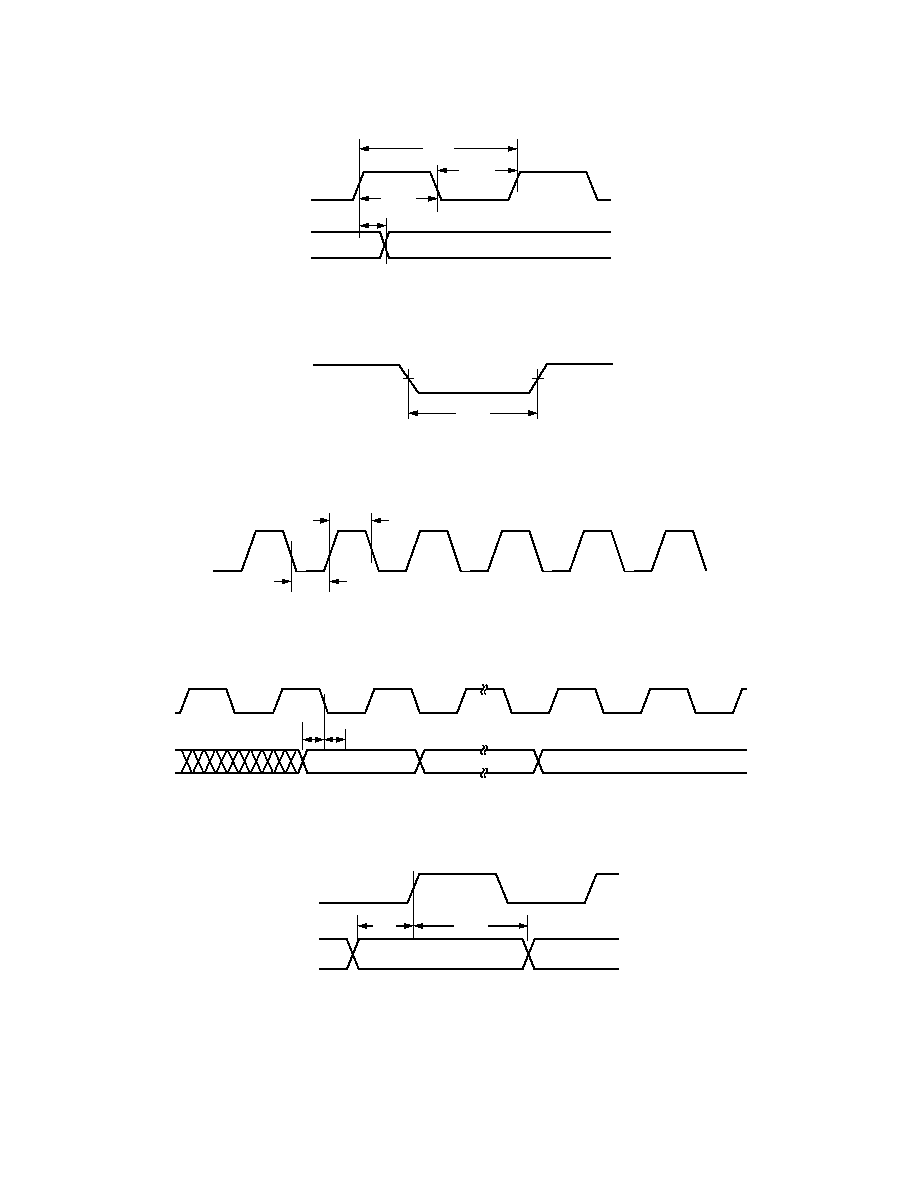
REV. 0
10
AD6634
TIMING DIAGRAMS
CLK
t
DLI
t
CLKL
t
CLK
t
CLKH
LIAA
LIAB
LIBA
LIBB
Figure 2. Level Indicator Output Switching Characteristics
RESET
t
RESL
Figure 3.
RESET Timing Requirements
t
SCLKH
t
SCLKL
SCLK
Figure 4. SCLK Switching Characteristics
SCLK
SDI
DATAn
t
SSI
t
HSI
Figure 5. Serial Port Input Timing Characteristics
CLK
INx[13:0]
EXPx[2:0]
IENx
t
HI
t
SI
Figure 6. Input Timing for A and B Channels
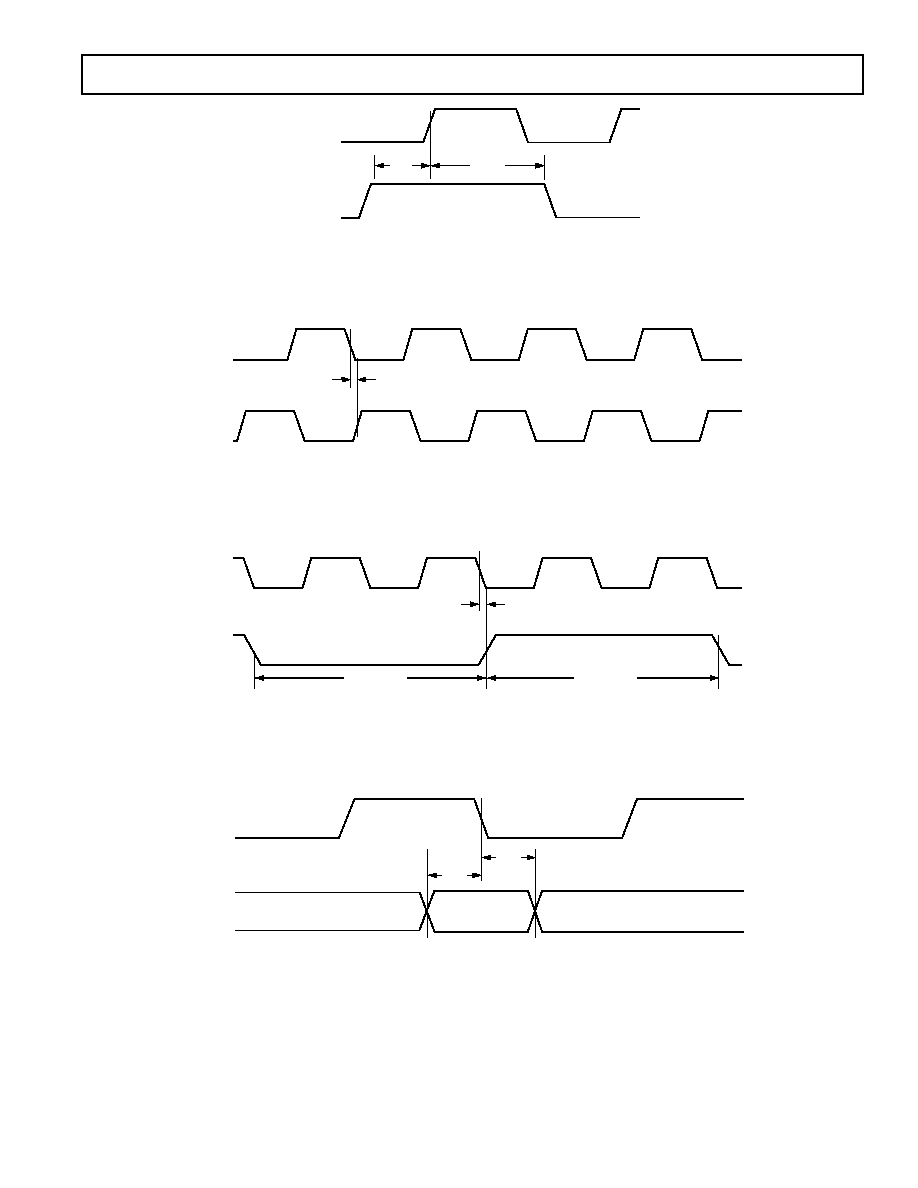
REV. 0
AD6634
11
t
HS
t
SS
CLK
SYNCA
SYNCB
SYNCC
CYNCD
Figure 7. SYNC Timing Inputs
CLK
PCLK
t
DPOCLKL
Figure 8. PCLK to CLK Switching Characteristics Divide by 1
CLK
PCLK
t
DPOCLKLL
t
POCLKL
t
POCLKH
Figure 9. PCLK to CLK Switching Characteristics Divide by 2, 4, or 8
PCLK
PxACK
t
SPA
t
HPA
Figure 10. Master Mode PxACK to PCLK Setup and Hold Characteristics
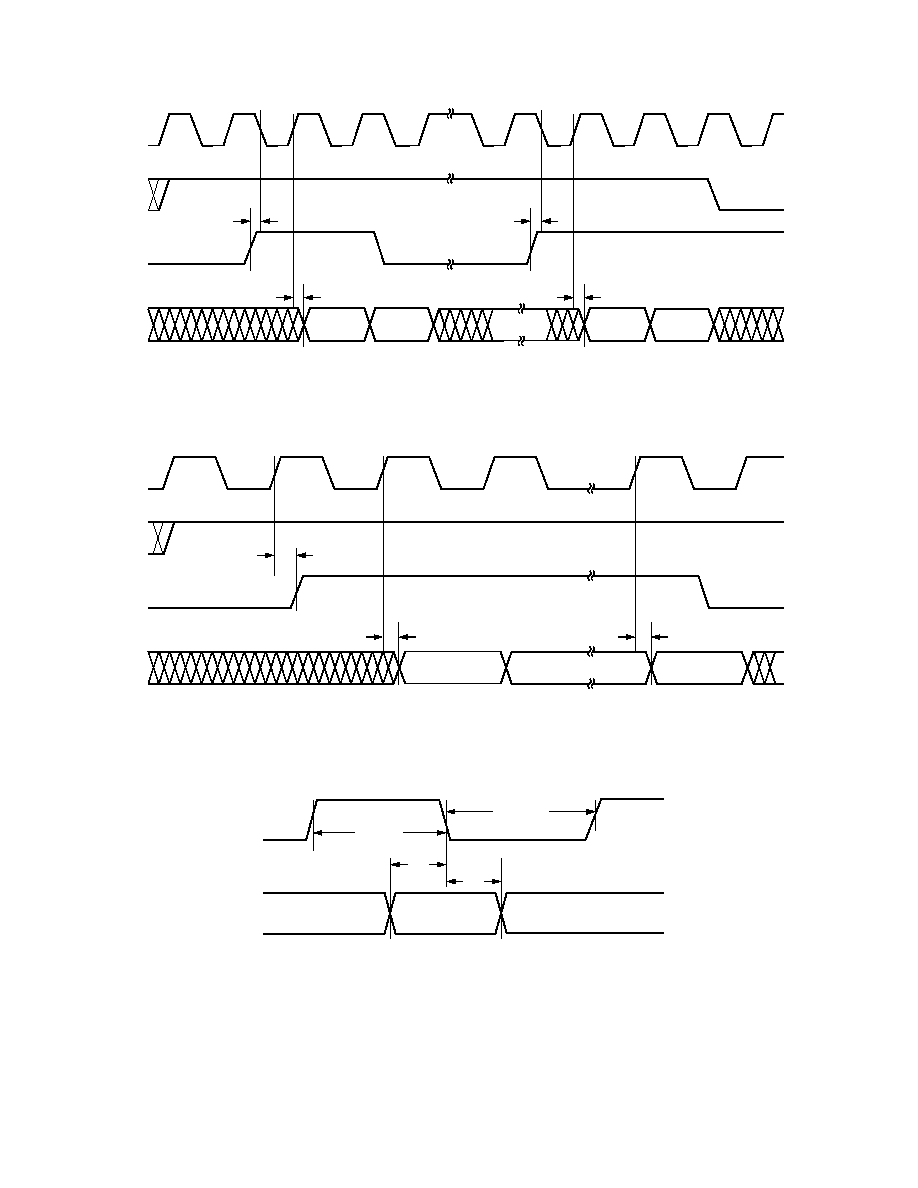
REV. 0
12
AD6634
DATA 1
DATA 2
DATA N1
DATA N
PCLK
PxREQ
PxACK
Px[15:0]
t
SPA
t
DPP
t
SPA
t
DPP
Figure 11. Master Mode PxACK to PCLK Switching Characteristics
PCLK
DATA 1
DATA N
t
DPP
t
DPP
t
DPREQ
PxACK
PxREQ
Px[15:0]
Figure 12. Master Mode PxREQ to PCLK Switching Characteristics
t
SPA
t
HPA
t
POCLKL
t
POCLKH
PCLK
PxACK
Figure 13. Slave Mode PxACK to PCLK Setup and Hold Characteristics
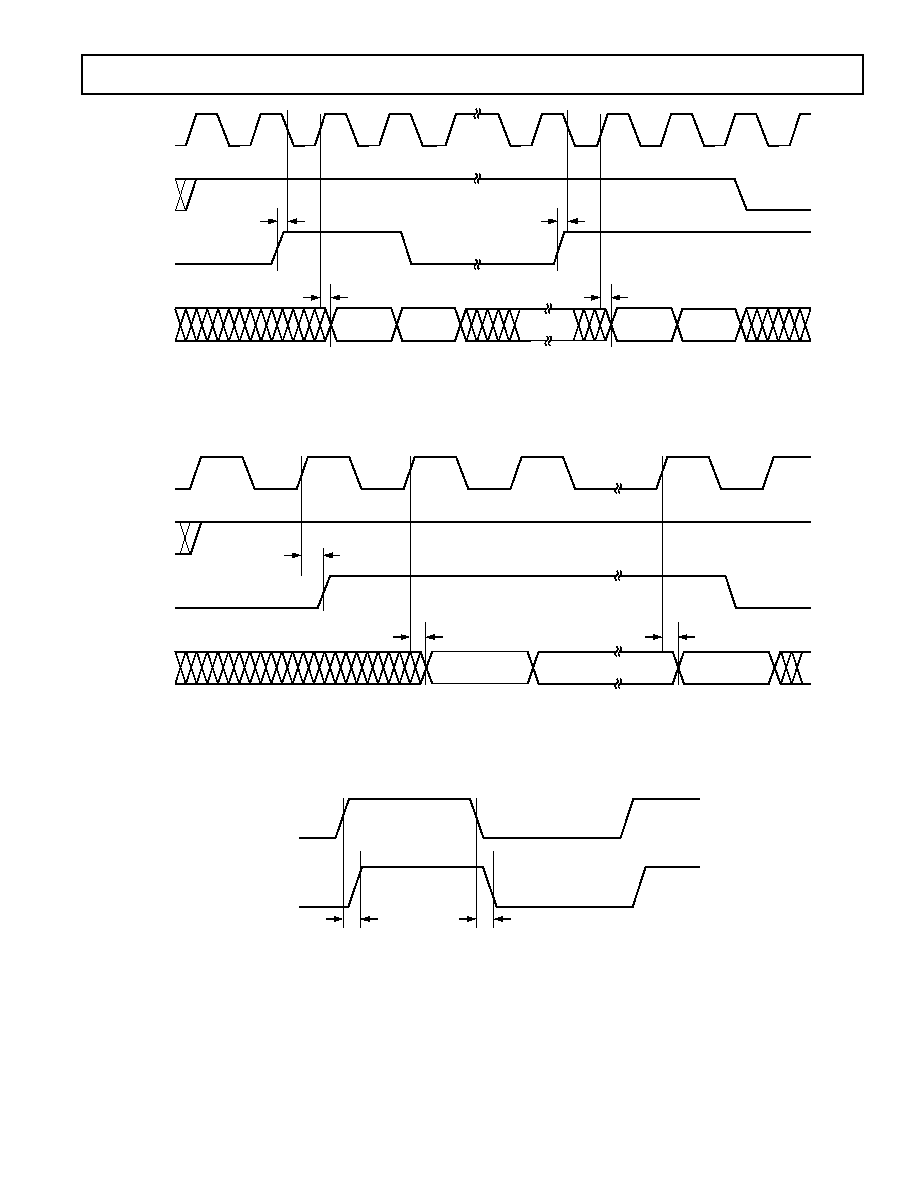
REV. 0
AD6634
13
DATA 1
DATA 2
DATA N1
DATA N
PCLK
PxREQ
PxACK
Px[15:0]
t
SPA
t
DPP
t
SPA
t
DPP
Figure 14. Slave Mode PxACK to PCLK Switching Characteristics
PCLK
DATA 1
DATA N
t
DPP
t
DPP
t
DPREQ
PxACK
PxREQ
Px[15:0]
Figure 15. Slave Mode PxREQ to PCLK Switching Characteristics
PCLK
LxCLKOUT
t
RDLCLK
t
FDLCL
Figure 16. LxCLKOUT to PCLK Switching Characteristics
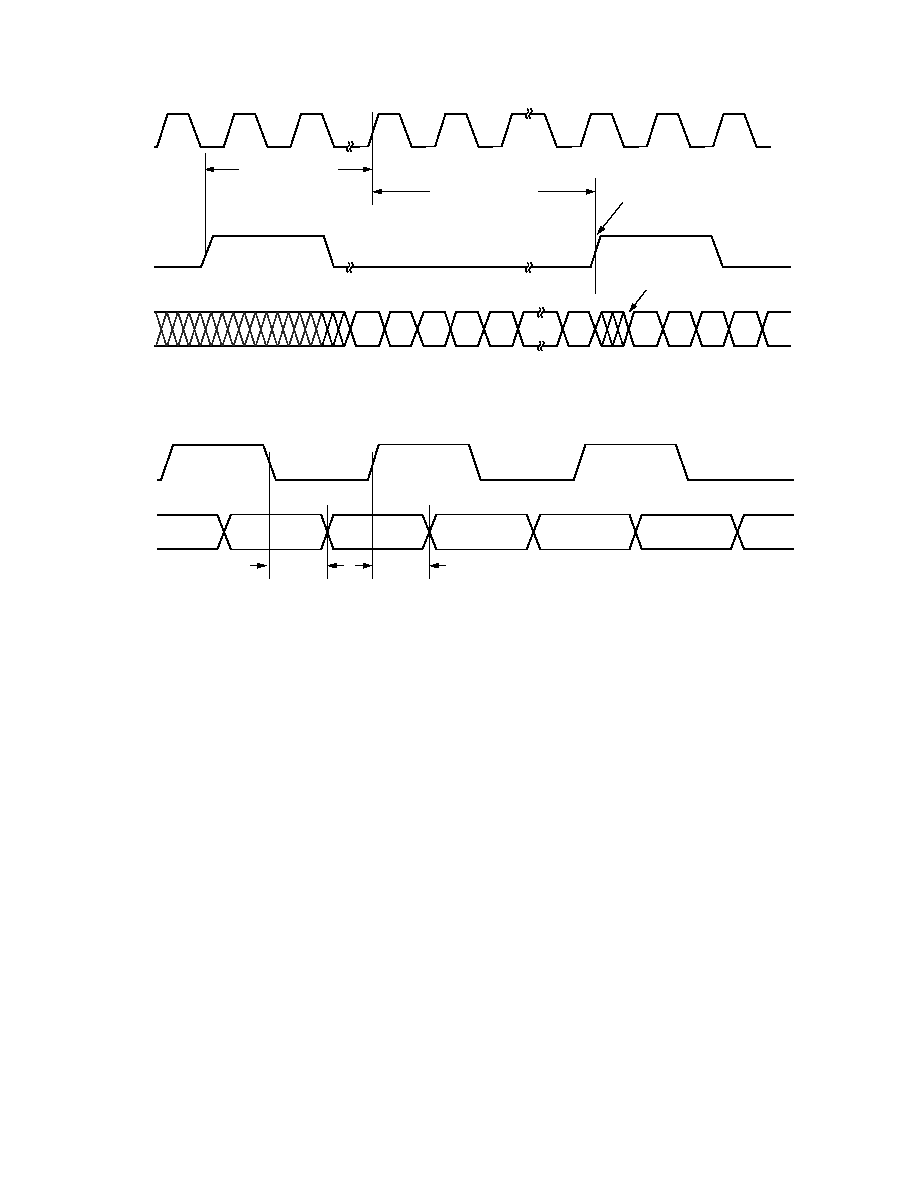
REV. 0
14
AD6634
LxCLKOUT
LxCLKIN
Lx[7:0]
WAIT > = 6 CYCLES
ONE TIME CONNECTIVITY CHECK
NEXT TRANSFER
ACKNOWLEDGE
NEXT TRANSFER
BEGINS
8 LxCLKOUT CYCLES
D0
D1
D2
D3
D4
D15
D0
D1
D2
D3
Figure 17. LxCLKIN to LxCLKOUT Data Switching Characteristics
LxCLKOUT
Lx[7:0]
t
FDLCLKDAT
t
RDLCLKDAT
Figure 18. LxCLKOUT to Lx[7:0] Data Switching Characteristics
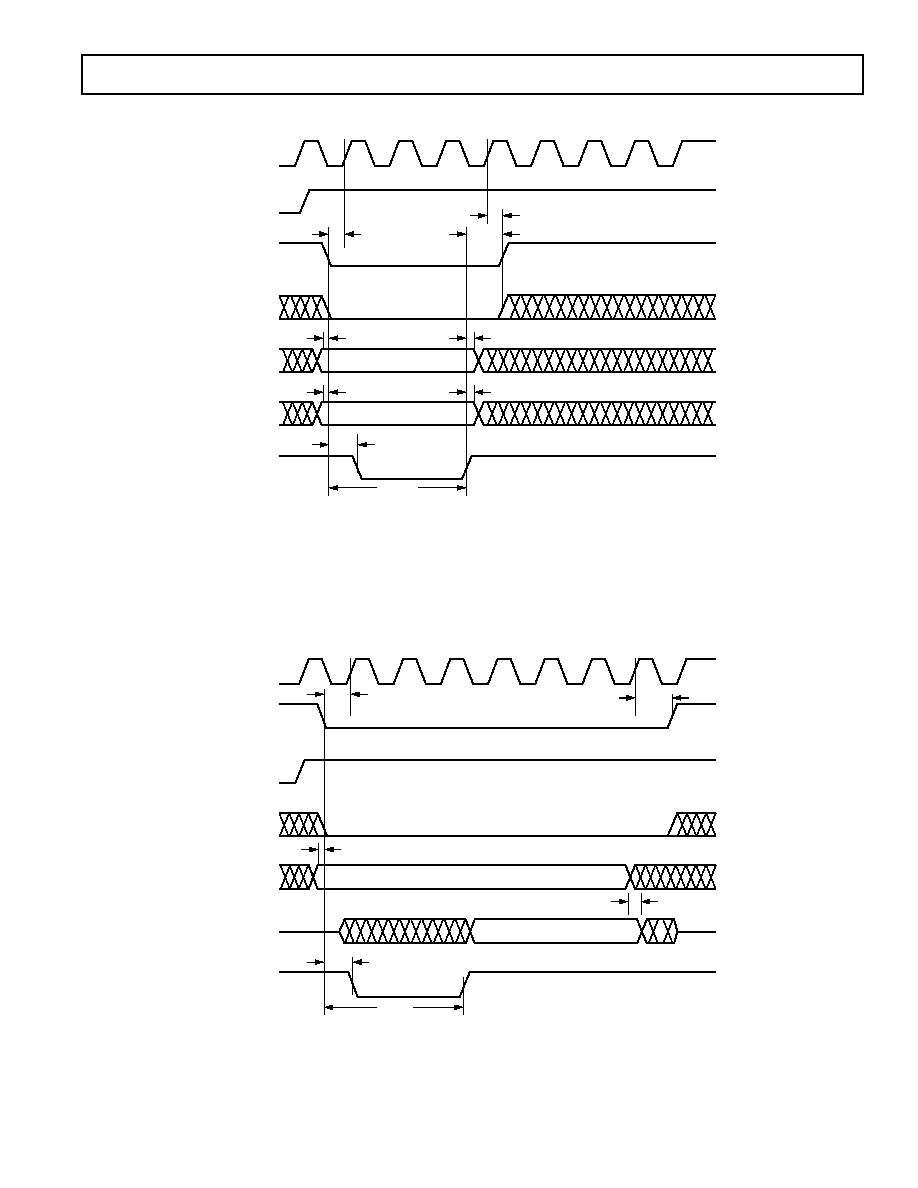
REV. 0
AD6634
15
TIMING DIAGRAMS--INM MICROPORT MODE
CLK
RD (DS)
WR (RW)
CS
A[2:0]
D[7:0]
RDY
(
DTACK)
VALID ADDRESS
VALID DATA
NOTES
1.
t
ACC
ACCESS TIME DEPENDS ON THE ADDRESS ACCESSED. ACCESS TIME IS MEASURED
FROM FE OF
WR TO RE OF RDY.
2.
t
ACC
REQUIRES A MAXIMUM OF 9 CLK PERIODS.
t
SC
t
HC
t
HWR
t
HAM
t
SAM
t
HAM
t
SAM
t
DRDY
t
ACC
Figure 19. INM Microport Write Timing Requirements
t
SC
CLK
RD (DS)
WR (RW)
A[2:0]
D[7:0]
RDY
(
DTACK)
CS
NOTES
1.
t
ACC
ACCESS TIME DEPENDS ON THE ADDRESS ACCESSED. ACCESS TIME IS MEASURED
FROM FE OF
WR TO RE OF RDY.
2.
t
ACC
REQUIRES A MAXIMUM OF 13 CLK PERIODS.
t
HC
t
SAM
t
HAM
VALID ADDRESS
VALID DATA
t
DRDY
t
ACC
Figure 20. INM Microport Read Timing Requirements
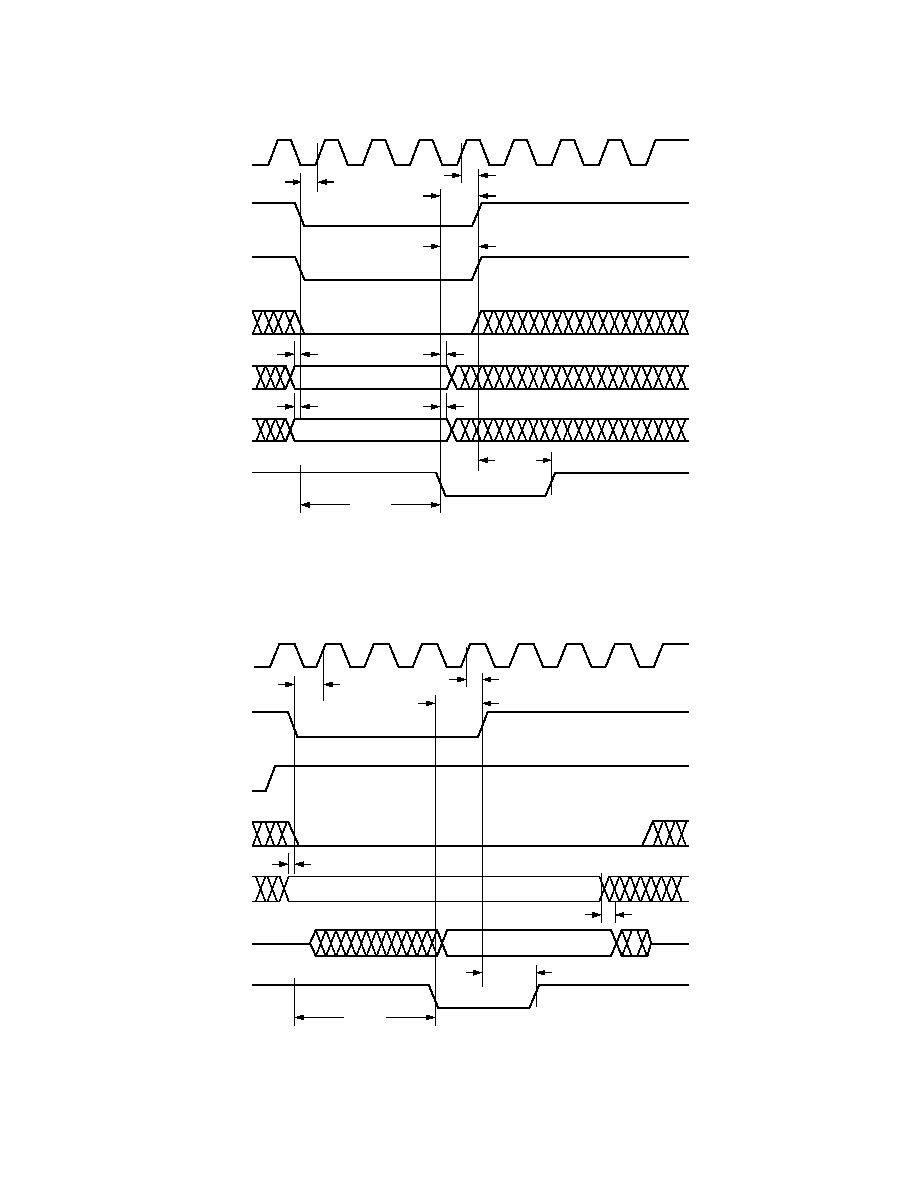
REV. 0
16
AD6634
TIMING DIAGRAMS--MNM MICROPORT MODE
VALID ADDRESS
VALID DATA
CLK
DS (RD)
RW (
WR)
CS
A[2:0]
D[7:0]
DTACK
(RDY)
NOTES
1.
t
ACC
ACCESS TIME DEPENDS ON THE ADDRESS ACCESSED. ACCESS TIME IS MEASURED
FROM FE OF
DS TO THE FE OF DTACK.
2.
t
ACC
REQUIRES A MAXIMUM OF 9 CLK PERIODS.
t
SC
t
HC
t
HDS
t
HRW
t
HAM
t
ACC
t
SAM
t
HAM
t
SAM
t
DDTACK
Figure 21. MNM Microport Write Timing Requirements
CLK
DS (RD)
RW (
WR)
A[2:0]
D[7:0]
DTACK
(RDY)
t
SC
t
ACC
t
DDTACK
NOTES
1.
t
ACC
ACCESS TIME DEPENDS ON THE ADDRESS ACCESSED. ACCESS TIME IS MEASURED
FROM THE FE OF
DS TO THE FE OF DTACK.
2.
t
ACC
REQUIRES A MAXIMUM OF 13 CLK PERIODS.
VALID ADDRESS
VALID DATA
t
SAM
t
HC
t
HDS
t
HAM
CS
Figure 22. MNM Microport Read Timing Requirements
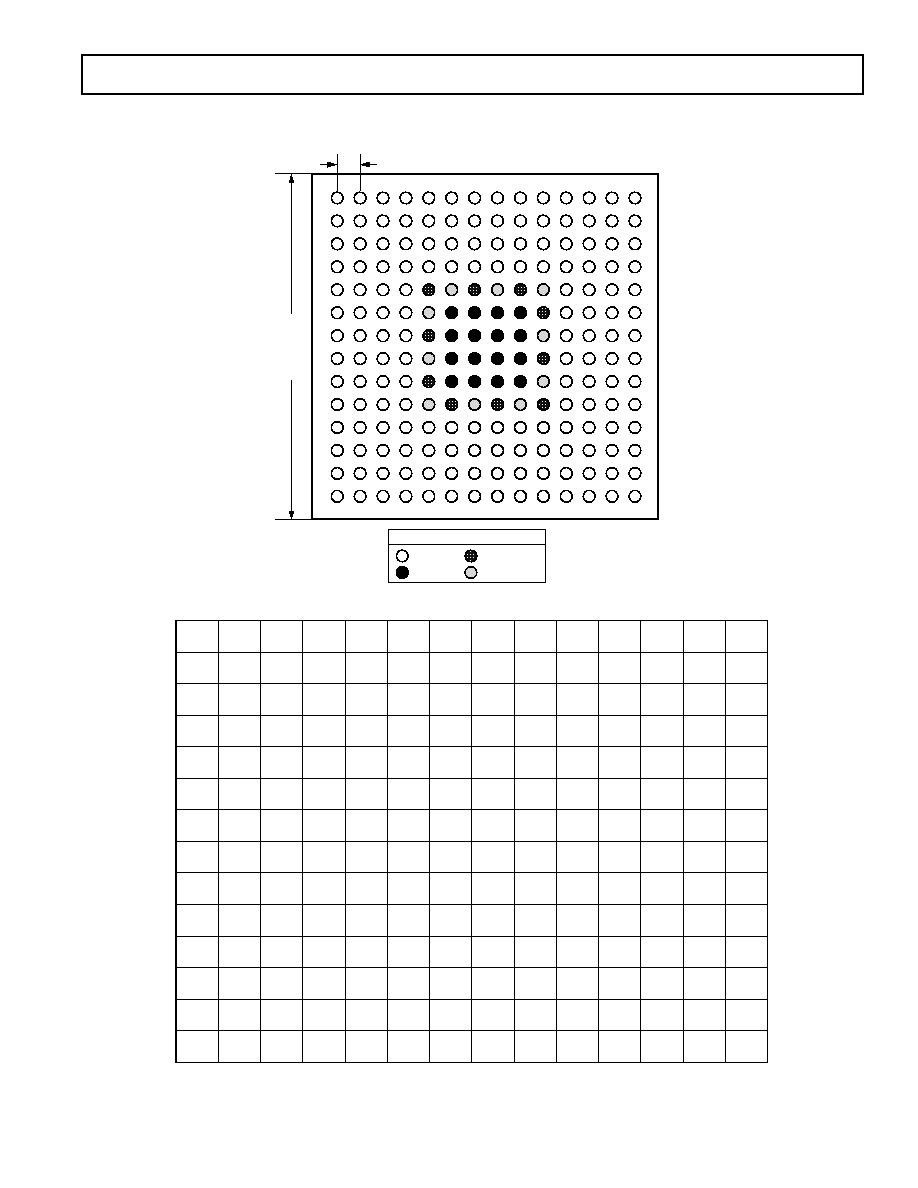
REV. 0
AD6634
17
PIN CONFIGURATION
1
2
3
4
5
6
7
8
9
10
11
12
13
14
1
2
3
4
5
6
7
8
9
10
11
12
13
14
A
B
C
D
E
F
G
H
J
K
L
M
N
P
A
B
C
D
E
F
G
H
J
K
L
M
N
P
1.0mm
15mm sq.
I/O
GROUND
BALL LEGEND
RING POWER
CORE POWER
196-LEAD BGA (15mm 15mm)
TOP VIEW
NO
CONNECT
INB2
INB0
LIB-B
CLK
EXPA1
INA12
INA11
INA8
INA5
INA3
INA2
INA0
NO
CONNECT
INB6
INB4
INB3
INB1
IENB
EXPA0
INA13
INA9
INA6
INA4
INA1
IENA
LIB-A
LIA-A
INB9
INB5
INB7
EXPA2
INA10
INA7
LIA-B
SYNCA
INB11
INB8
INB13
DTACK
(RDY)
SYNCB
SYNCC
EXPB1
INB12
INB10
VDDIO
VDD
VDDIO
VDD
VDDIO
VDD
MODE
SYNCD
RESET
VDDIO
(RESERVED)
EXPB0
EXPB2
VDD
GND
GND
GND
GND
VDDIO
CS
D7
D6
PB14
PB15
PBACK
VDDIO
GND
GND
GND
GND
VDD
RW
(
WR)
D5
D4
PB12
PB13
PBREQ
VDD
GND
GND
GND
GND
VDD
TRST
D3
D2
PB10
PB11
PB9
VDDIO
GND
GND
GND
GND
VDD
DS(RD)
D1
D0
PB1 | LB1
PB4 | LB4
PB8
VDD
VDDIO
VDD
VDDIO
VDD
VDDIO
A1
A2
PA6 | LA6
PB2 | LB2
PB0 | LB0
A0
PCHA1 |
LACLKIN
PCHA0 |
LACLKOUT
PB5 | LB5
PB3 | LB3
PBIQ
PAACK
SCLK
PAREQ
TDO
TCLK
PA4 | LA4
PA5 | LA5
PA7 | LA7
PBCH1 |
LBCLKIN
PBCH0 |
LBCLKOUT
PCLK
SDI
CHIP_ID2
CHIP_ID0
TDI
PA14
PA12
PA10
PA8
PA2 | LA2
PA3 | LA3
NO
CONNECT
PB7 | LB7
PB6 | LB6
PAIQ
CHIP_ID3
CHIP_ID1
TMS
PA15
PA13
PA11
PA9
PA0 | LA0
PA1 | LA1
NO
CONNECT
A
B
C
D
E
F
G
H
J
K
L
M
N
P
A
B
C
D
E
F
G
H
J
K
L
M
N
P
1
2
3
4
5
6
7
8
9
10
11
12
13
14
1
2
3
4
5
6
7
8
9
10
11
12
13
14

REV. 0
18
AD6634
PIN FUNCTION DESCRIPTIONS
Mnemonic
Type
Function
POWER SUPPLY
VDD
P
2.5 V Supply
VDDIO
P
3.3 V IO Supply
GND
G
Ground
INPUTS
INA[13:0]
1
I
A Input Data (Mantissa)
EXPA[2:0]
1
I
A Input Data (Exponent)
IENA
2
I
Input Enable--Input A
INB[13:0]
1
I
B Input Data (Mantissa)
EXPB[2:0]
1
I
B Input Data (Exponent)
IENB
2
I
Input Enable--Input B
RESET
I
Active Low Reset Pin
CLK
I
Input Clock
PCLK
I/O
Link/Parallel Port Clock
LACLKIN
I
Link Port A Data Ready
LBCLKIN
I
Link Port B Data Ready
SYNCA
1
I
All Sync pins go to all four output channels.
SYNCB
1
I
All Sync pins go to all four output channels.
SYNCC
1
I
All Sync pins go to all four output channels.
SYNCD
1
I
All Sync pins go to all four output channels.
CS
1
I
Chip Select
CHIP_ID[3:0]
1
I
Chip ID Selector
CONTROL
PAACK
I
Parallel Port A Acknowledge
PAREQ
O
Parallel Port A Request
PBACK
I
Parallel Port B Acknowledge
PBREQ
O
Parallel Port B Request
MICROPORT CONTROL
D[7:0]
I/O/T
Bidirectional Microport Data
A[2:0]
I
Microport Address Bus
DS(RD)
I
Active Low Data Strobe (Active Low Read)
DTACK(RDY)
2
O/T
Active Low Data Acknowledge (Microport Status Bit)
R/W(
WR)
I
Read Write (Active Low Write)
MODE
I
Intel or Motorola Mode Select
SERIAL PORT CONTROL
SDI
1
I
Serial Port Control Data Input
SCLK
1
I
Serial Port Control Clock
OUTPUTS
LIAA
O
Level Indicator--Input A, InterleavedData A
LIAB
O
Level Indicator--Input A, InterleavedData B
LIBB
O
Level Indicator--Input B, InterleavedData B
LIBA
O
Level Indicator--Input B, InterleavedData A
LACLKOUT
O
Link Port A Clock Output
LBCLKOUT
O
Link Port B Clock Output
LA[7:0]
O
Link Port A Output Data
LB[7:0]
O
Link Port B Output Data
PA[15:0]
O
Parallel Output Data Port A
PB[15:0]
O
Parallel Output Data Port B
PACH[1:0]
O
Parallel Output Port A Channel Indicator
PBCH[1:0]
O
Parallel Output Port B Channel Indicator
PAIQ
O
Parallel Port A I/Q Data Indicator
PBIQ
O
Parallel Port B I/Q Data Indicator
JTAG AND BIST
TRST
2
I
Test Reset Pin
TCLK
1
I
Test Clock Input
TMS
2
I
Test Mode Select Input
TDO
O/T
Test Data Output
TDI
2
I
Test Data Input
NOTES
1
Pins with a pull-down resistor of nominal 70 k
.
2
Pins with a pull-up resistor of nominal 70 k
.
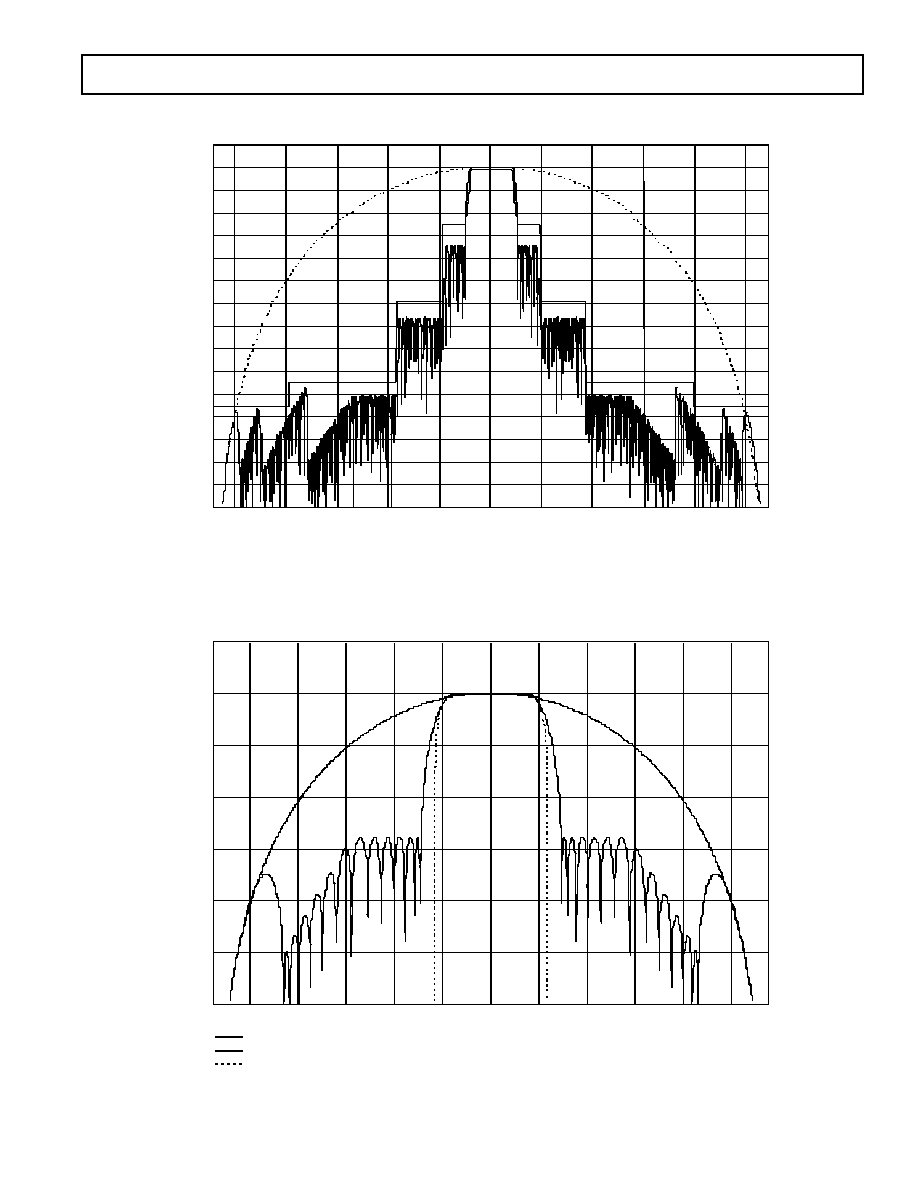
REV. 0
AD6634
19
EXAMPLE FILTER RESPONSE
1000
kHz
dBc
150
800
600
400
200
0
200
400
600
800
1000
140
130
120
110
100
90
80
70
60
50
40
30
20
10
0
10
Figure 23. The Filter Above Is Based on a 65 MSPS Input Data Rate and an Output Rate of 541.6666 kSPS
(Two Samples per Symbol for EDGE). Total decimation rate is 120, distributed between the rCIC2, CIC5, and RCF.
1.0 10
4
kHz
dBc
120
8000
6000
4000
2000
0
2000
4000
6000
8000
1.0 10
4
100
80
60
40
20
0
20
CIC RESPONSE
COMPOSITE RESPONSE
DESIRED RESPONSE
Figure 24. The Filter Above Is Designed to Meet UMTS Specifications. For this configuration, the clock is set to
76.8 MSPS with 20 chip rate (3.84 MCPS) and a 2 output data rate of 7.68 MCPS using two channels of the AD6634.
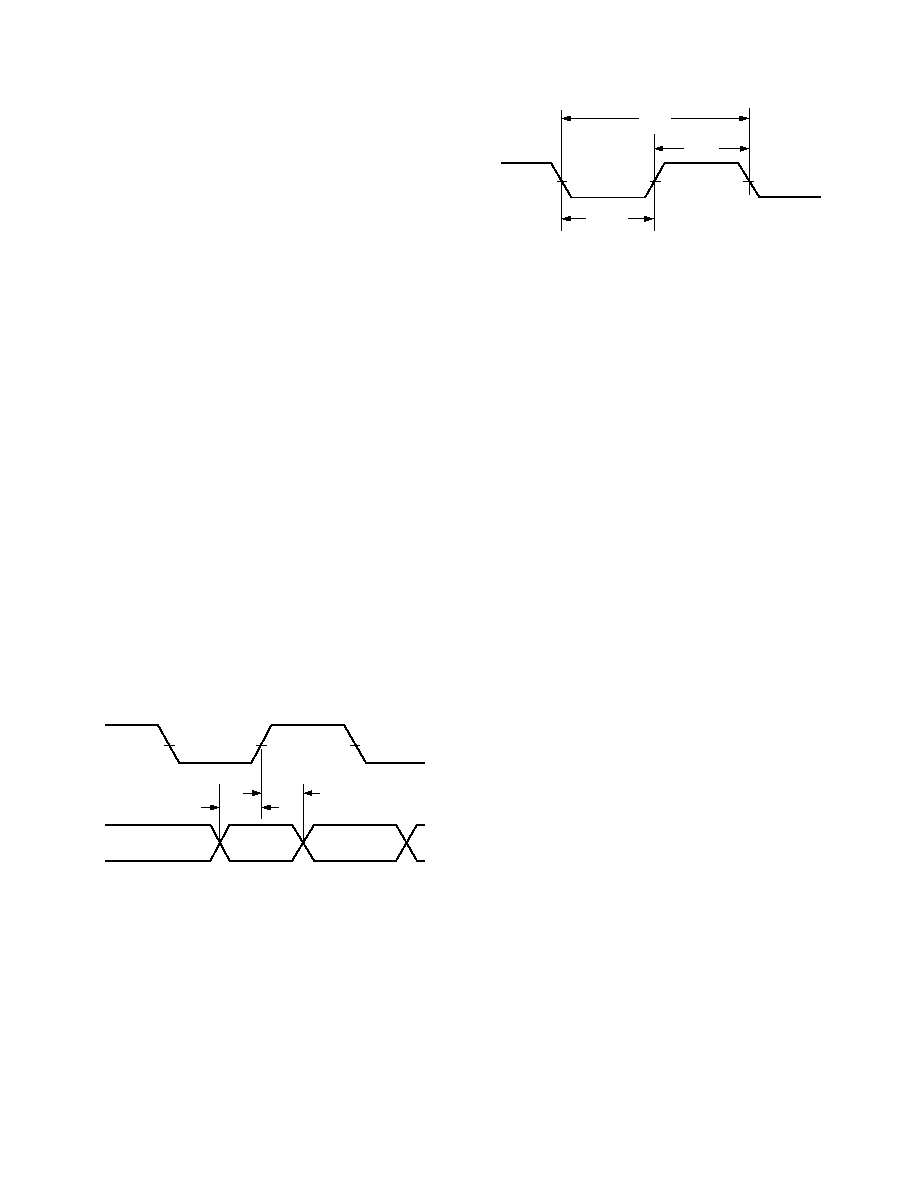
REV. 0
20
AD6634
INPUT DATA PORTS
The AD6634 features dual high speed ADC input ports, input
port A and input port B. The dual input ports allow for the
most flexibility with a single tuner chip. These can be diversity
inputs or truly independent inputs such as separate antenna
segments. Either ADC port can be routed to one of four tuner
channels. For added flexibility, each input port can be used to
support multiplexed inputs such as those found on the AD6600
or other ADCs with multiplexed outputs. This added flexibility
can allow for up to four different analog sources to be processed
simultaneously by the four internal channels.
In addition, the front end of the AD6634 contains circuitry that
enables high speed signal level detection and control. This is
accomplished with a unique high speed level detection circuit
that offers minimal latency and maximum flexibility to control
up to four analog signal paths. The overall signal path latency
from input to output on the AD6634 can be expressed in high
speed clock cycles. The following equation can be used to
calculate the latency.
T
M
M
N
LATENCY
rCIC
CIC
TAPS
=
+
(
)
+
+
2
5
7
26
M
rCIC2
and M
CIC5
are decimation values for the rCIC2 and CIC5
filters, respectively. N
TAPS
is the number RCF taps chosen.
Input Data Format
Each input port consists of a 14-bit mantissa and 3-bit exponent.
If interfacing to a standard ADC is required, the exponent bits can
be grounded. If connected to a floating point ADC such as the
AD6600, the exponent bits from that product can be connected
to the input exponent bits of the AD6634. The mantissa data
format is two's complement and the exponent is unsigned binary.
Input Timing
The data from each high speed input port is latched on the
rising edge of CLK. This clock signal is used to sample the
input port and clock the synchronous signal processing stages
that follow in the selected channels.
CLK
IN[13:0]
EXP[2:0]
DATA
t
SI
t
HI
Figure 25. Input Data Timing Requirements
The clock signals can operate up to 80 MHz and have a 50% duty
cycle. In applications using high speed ADCs, the ADC sample
clock or data valid strobe is typically used to clock the AD6634.
t
CLKL
t
CLK
t
CLKH
CLK
Figure 26. CLK Timing Requirements
Input Enable Control
There is an IENA and an IENB pin for Input Port A and Input
Port B, respectively. There are four modes of operation possible
while using each IEN pin. Using these modes, it is possible to
emulate operation of the other RSPs, such as the AD6620,
which offer dual channel modes normally associated with diver-
sity operations. These modes are: IEN transition to Low, IEN
transition to High, IEN High, and Blank on IEN low.
In the IEN High mode, the inputs and normal operations occur
when the input enable is high. In the IEN transition to Low mode,
normal operations occur on the first rising edge of the clock after
the IEN transitions to low. Likewise in the IEN transition to High
mode, operations occur on the rising edge of the clock after the
IEN transitions to High. (See the Numerically Controlled Oscil-
lator section for more details on configuring the Input Enable
Modes.) In Blank on IEN low mode, the input data is interpreted
as zero when IEN is low.
A typical application for this feature would be to take the data
from an AD6600 Diversity ADC to one of the inputs of the
AD6634. The A/B_OUT from that chip would be tied to the
IEN. Then one channel within the AD6634 would be set so that
IEN transition to Low is enabled. Another channel would be
configured so that IEN transition to High is enabled. This would
allow two of the AD6634 channels to be configured to emulate
that AD6620 in diversity mode. Of course the NCO frequencies
and other channel characteristics would need to be set similarly,
but this feature allows the AD6634 to handle interleaved data
streams such as those found on the AD6600.
The difference between the IEN transition to high and the IEN
high is found when a system clock is provided that is higher than
the data rate of the converter. It is often advantageous to supply
a clock that runs faster than the data rate so that additional filter
taps can be computed. This naturally provides better filtering.
In order to ensure that other parts of the circuit properly recog-
nize the faster clock in the simplest manner, the IEN transition
to low or high should be used. In this mode, only the first clock
edge that meets the setup and hold times will be used to latch
and process the input data. All other clock pulses are ignored by
front end processing. However, each clock cycle will still produce
a new filter computation pair.
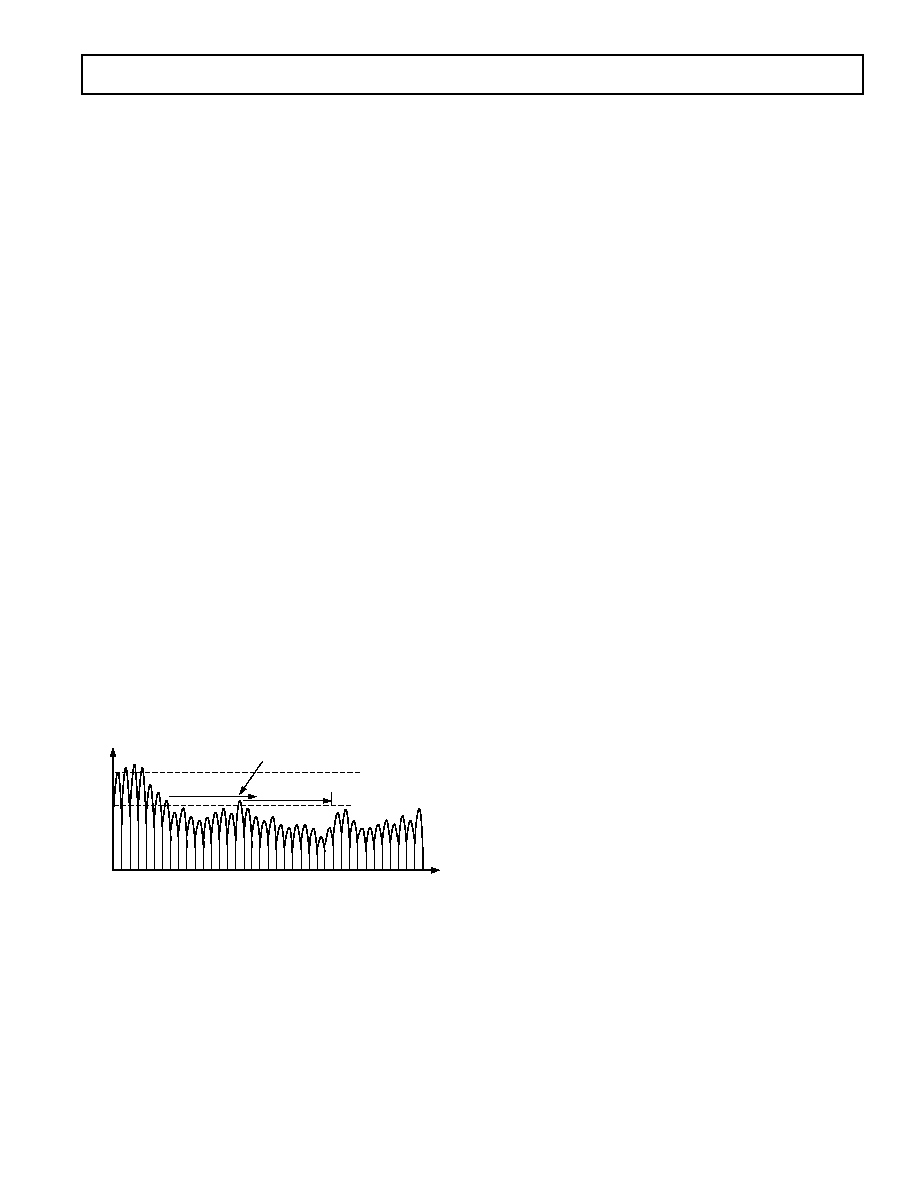
REV. 0
AD6634
21
Gain Switching
The AD6634 includes circuitry that is useful in applications where
either large dynamic ranges exist or where gain ranging convert-
ers are employed. This circuitry allows digital thresholds to be
set such that an upper and a lower threshold can be programmed.
One such use of this may be to detect when an ADC is about to
reach full scale with a particular input condition. The results
would be to provide a flag that could be used to quickly insert
an attenuator that would prevent ADC overdrive. If 18 dB (or
any arbitrary value) of attenuation (or gain) is switched in, the
signal dynamic range of the system will have been increased by
18 dB. The process begins when the input signal reaches the
upper programmed threshold. In a typical application, this may
be set 1 dB (user-definable) below full scale. When this input
condition is met, the appropriate LI (LIA-A, LIA-B, LIB-A, or
LIB-B) signal associated with either the A or B input port is
made active. This can be used to switch the gain or attenuation
of the external circuit. The LI line stays active until the input
condition falls below the lower programmed threshold. In order
to provide hysteresis, a dwell time register (see Memory Map for
Input Control Registers) is available to hold off switching of the
control line for a predetermined number of clocks. Once the
input condition is below the lower threshold, the programmable
counter begins counting high speed clocks. As long as the input
signal stays below the lower threshold for the number of high
speed clock cycles programmed, the attenuator will be removed
on the terminal count. However, if the input condition goes
above the lower threshold with the counter running, it will be
reset and must fall below the lower threshold again to initiate the
process. This will prevent unnecessary switching between states
and is illustrated in Figure 27.
When the input signal goes above the upper threshold, the
appropriate LI signal becomes active. Once the signal falls
below the lower threshold, the counter begins counting. If the
input condition goes above the lower threshold, the counter is
reset and starts again as shown in Figure 27. Once the counter
has terminated to 0, the LI line goes inactive.
"HIGH"
MANTISSA
DWELL TIME
"LOW"
UPPER
THRESHOLD
LOWER
THRESHOLD
COUNTER
RESTARTS
TIME
Figure 27. Threshold Settings for LI
The LI line can be used for a variety of functions. It can be used
to set the controls of an attenuator, DVGA, or integrated and used
with an analog VGA. To simplify the use of this feature, the
AD6634 includes two separate gain settings, one when this line is
inactive (rCIC2_QUIET[4:0] stored in bits 9:5 of 0x92 register)
and the other when active (rCIC2_LOUD[4:0] stored in bits
4:0 of 0x92 register). This allows the digital gain to be adjusted
to the external changes. In conjunction with the gain setting, a
variable hold-off is included to compensate for the pipeline delay
of the ADC and the switching time of the gain control element.
Together, these two features provide seamless gain switching.
Another use of this pin is to facilitate a gain range hold-off within a
gain ranging ADC. For converters that use gain ranging to increase
total signal dynamic range, it may be desirable to prohibit internal
gain ranging from occurring in some instances. For such converters,
the LI (A or B) line can be used to hold this off. For this applica-
tion, the upper threshold would be set based on similar criteria.
However, the lower threshold would be set to a level consistent
with the gain ranges of the specific converter. The hold-off delay
can then be set appropriately for any of a number of factors such
as fading profile, signal peak to average ratio, or any other time-
based characteristics that might cause unnecessary gain changes.
Since the AD6634 has a total of four gain control circuits that
can be used if both A and B input ports have interleaved data.
Each respective LI pin is independent and can be set to differ-
ent set points. It should be noted that the gain control circuits
are wideband and are implemented prior to any filtering elements
to minimize loop delay. Any of the four channels can be set to
monitor any of the possible four input channels (two in normal
mode and four when the inputs are time multiplexed).
The chip also provides appropriate scaling of the internal data
based on the attenuation associated with the LI signal. In this
manner, data to the DSP maintains a correct scale value through-
out the process, making it totally independent. Since there are
often finite delays associated with external gain switching com-
ponents, the AD6634 includes a variable pipeline delay that can
be used to compensate for external pipeline delays or gross
settling times associated with gain/attenuator devices. This delay
may be set up to seven high speed clocks. These features ensure
smooth switching between gain settings.
Input Data Scaling
The AD6634 has two data input ports, an A input port and a
B input port. Each accepts 14-bit mantissa (two's complement
integer) IN[13:0], a 3-bit exponent (unsigned integer) EXP[2:0]
and the Input Enable(IEN). Both inputs are clocked by CLK.
These pins allow direct interfacing to both standard fixed-point
ADCs such as the AD9238 and AD6645, as well as to gain-
ranging ADCs such as the AD6600. For normal operation with
ADCs having fewer than 14 bits, the active bits should be MSB
justified and the unused LSBs should be tied low.
The 3-bit exponent, EXP[2:0] is interpreted as an unsigned
integer. The exponent will subsequently be modified by either of
rCIC2_LOUD[4:0] or rCIC2_QUIET[4:0] depending on whether
LI line is active or not. These 5-bit scale values are stored in the
rCIC2 scale register (0x92) and the scaling is applied before the
data enters the rCIC2 resampling filter. These 5-bit registers
contain scale values to compensate for the rCIC2 gain, external
attenuator (if used) and the exponent offset (Expoff). If no external
attenuator is used, both the rCIC2_QUIET and rCIC2_LOUD
registers would contain the same value. A detailed explanation
and equation for setting the attenuating scale register is given in
the Scaling with Floating-Point or Gain-Ranging ADCs section.
Scaling with Fixed-Point ADCs
For fixed-point ADCs, the AD6634 exponent inputs EXP[2:0] are
typically not used and should be tied low. The ADC outputs are
tied directly to the AD6634 Inputs, MSB-justified. The ExpOff
bits in 0x92 should be programmed to 0. Likewise, the Exponent
Invert bit should be 0. Thus for fixed-point ADCs, the exponents
are typically static and no input scaling is used in the AD6634.
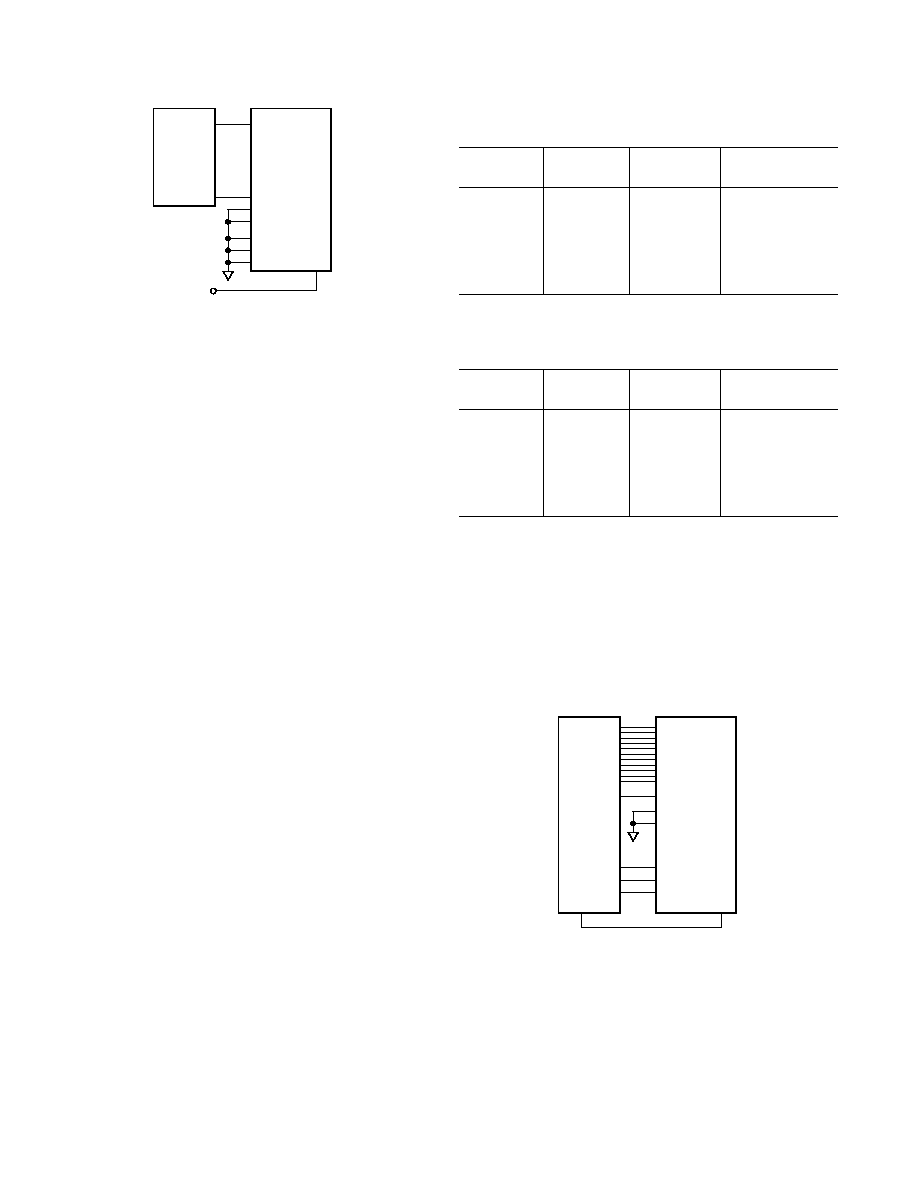
REV. 0
22
AD6634
Table I. AD6600 Transfer Function with AD6634
ExpInv = 1, and No ExpOff
ADC Input
AD6600
AD6634
Signal
Level
RSSI[2:0]
Data
Reduction (dB)
Largest
101 (5)
/4 (>> 2)
12
100 (4)
/8 (>>3)
18
011 (3)
/16 (>> 4)
24
010 (2)
/32 (>> 5)
30
001 (1)
/64 (>> 6)
36
Smallest
000 (0)
/128 (>> 7)
42
(ExpInv = 1, rCIC2 Scale = 0)
Table II. AD6600 Transfer Function with AD6620
ExpInv = 1, and ExpOff = 6
ADC Input
AD6600
AD6634
Signal
Level
RSSI[2:0]
Data
Reduction (dB)
Largest
101 (5)
/1 (>> 0)
0
100 (4)
/2 (>> 1)
6
011 (3)
/4 (>> 2)
12
010 (2)
/8 (>> 3)
18
001 (1)
/16 (>> 4)
24
Smallest
000 (0)
/32 (>> 5)
30
(ExpInv = 1, ExpOff = 30, ExpWeight = 0)
This flexibility in handling the exponent allows the AD6634 to
interface with gain-ranging ADCs other than the AD6600. The
Exponent Offset can be adjusted to allow up to seven RSSI(EXP)
ranges to be used as opposed to the AD6600's five. It also allows
the AD6634 to be tailored in a system that employs the AD6600
but does not utilize all of its signal range. For example, if only
the first four RSSI ranges are expected to occur, the ExpOff
could be adjusted to 29, which would then make RSSI = 4
correspond to the 0 dB point of the AD6634.
IN 13
IN 2
IN 1
IN 0
IEN
D10 (MSB)
D0 (LSB)
AD6600
AD6634
EXP 1
RSSI 1
EXP 2
RSSI 2
EXP 0
RSSI 0
AB_OUT
Figure 29. Typical Interconnection of the AD6600
Gain-Ranging ADC and the AD6634
NUMERICALLY CONTROLLED OSCILLATOR
Frequency Translation
This processing stage comprises a digital tuner consisting of two
multipliers and a 32-bit complex NCO. Each channel of the
AD6634 has an independent NCO. The NCO serves as a quadra-
ture local oscillator capable of producing an NCO frequency
between CLK/2 and +CLK/2 with a resolution of CLK/2
32
in
the complex mode. The worst-case spurious signal from the
NCO is better than 100 dBc for all output frequencies.
IN 13
IN 2
IN 1
IN 0
EXP 2
EXP 1
EXP 0
IEN
VDD
D11 (MSB)
D0 (LSB)
AD6640
AD6634
Figure 28. Typical Interconnection of the AD6640
Fixed Point ADC and the AD6634
Scaling with Floating-Point or Gain-Ranging ADCs
An example of the exponent control feature combines the AD6600
and the AD6634. The AD6600 is an 11-bit ADC with three bits
of gain ranging. In effect, the 11-bit ADC provides the mantissa,
and the three bits of relative signal strength indicator (RSSI) for
the exponent. Only five of the eight available steps are used by
the AD6600. See the AD6600 data sheet for additional details.
For gain-ranging ADCs such as the AD6600,
SCALED
INPUT
IN
EXPINV
EXPWEIGHT
MOD
EXP
rCIC
_
,
,
,
=
×
=
=
+
(
)
2
1
0
7
2 32
where, IN is the value of IN[13:0], EXP is the value of
EXP[2:0], and rCIC2 is the rCIC scale register value (0x92
Bits 95 and 40).
The RSSI output of the AD6600 numerically grows with increas-
ing signal strength of the analog input (RSSI = 5 for a large
signal, RSSI = 0 for a small signal). When the Exponent Invert
Bit (ExpInv) is set to zero, the AD6634 will consider the small-
est signal at the IN[13:0] to be the largest and as the EXP word
increases, it shifts the data down internally (EXP = 5 will shift a
14-bit word right by five internal bits before passing the data to
the rCIC2). In this example where ExpInv = 0, the AD6634
regards the largest signal possible on the AD6600 as the small-
est signal. Thus, we can use the Exponent Invert Bit to make
the AD6634 exponent agree with the AD6600 RSSI. By setting
ExpInv = 1, this forces the AD6634 to shift the data up (left)
for growing EXP instead of down. The exponent invert bit
should always be set high for use with the AD6600.
The exponent offset is used to shift the data up. For example,
Table I shows that with no rCIC2 scaling, 12 dB of range is lost
when the ADC input is at the largest level. This is undesirable
because it lowers the dynamic range and SNR of the system by reduc-
ing the signal of interest relative to the quantization noise floor.
To avoid this automatic attenuation of the full-scale ADC signal
the ExpOff is used to move the largest signal (RSSI = 5) up to
the point where there is no down shift. In other words, once the
Exponent Invert bit has been set, the exponent offset should be
adjusted so that mod(75 + ExpOff, 32) = 0. This is the case
when exponent offset is set to 30 since mod(32, 32) = 0.
Table II illustrates the use of ExpInv and ExpOff when used
with the AD6600 ADC.
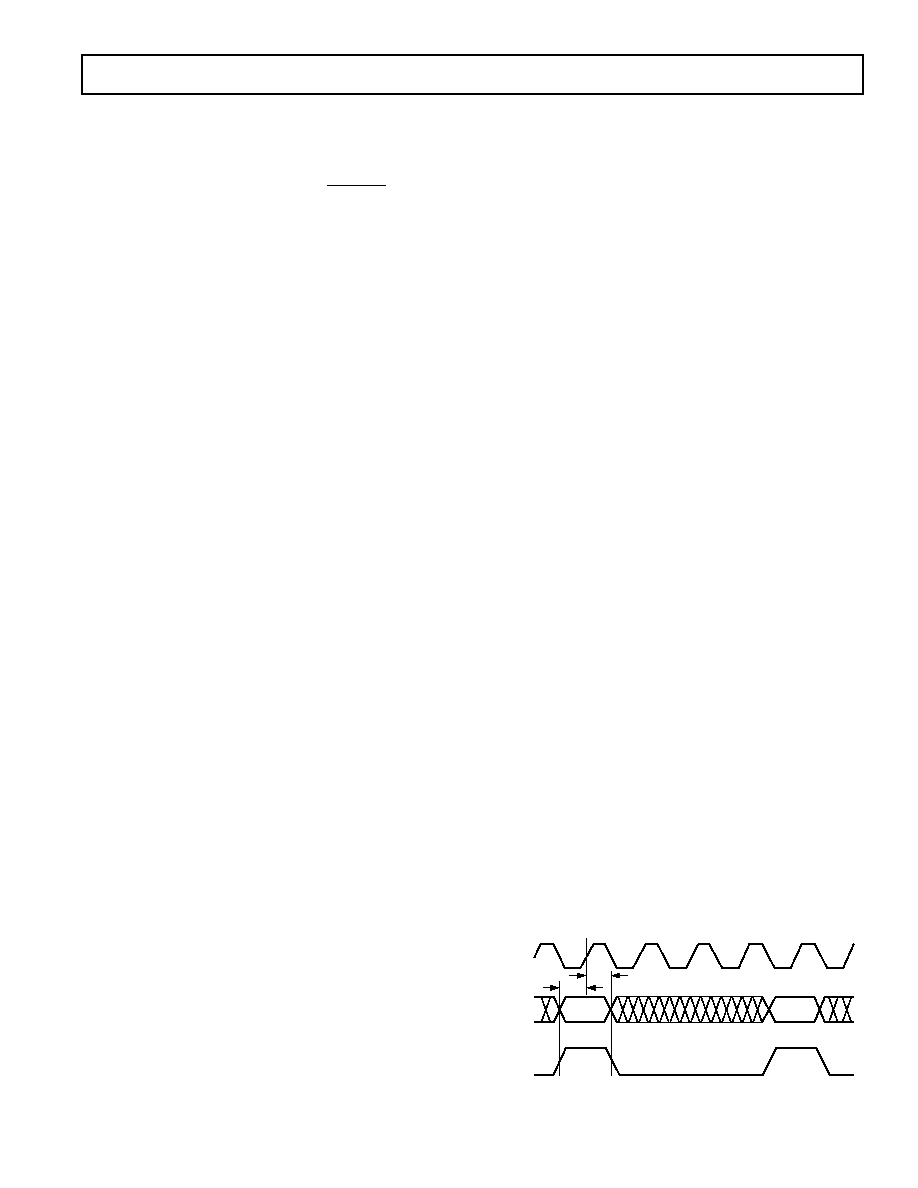
REV. 0
AD6634
23
The NCO frequency value in registers 0x85 and 0x86 is interpreted
as a 32-bit unsigned integer. The NCO frequency is calculated
using the equation below.
NCO
FREQ
MOD
f
CLK
CHANNEL
_
=
×
2
32
where, NCO_FREQ is the 32-bit integer (registers 0x85 and 0x86),
f
CHANNEL
is the desired channel frequency, and CLK is the AD6634
master clock rate or input data rate depending on the Input
Enable mode used. See Input Enable Control section.
NCO Frequency Hold-Off Register
When the NCO Frequency registers are written, data is actually
passed to a shadow register. Data may be moved to the main
registers by one of two methods: when the channel comes out of
sleep mode or when a SYNC Hop occurs. In either event a
counter can be loaded with NCO Frequency Hold-Off register
value. The 16-bit unsigned integer counter (0x84) starts count-
ing down clocked by the master clock and when it reaches zero,
the new frequency value in the shadow register is written to the
NCO Frequency register. The NCO could also be set up to SYNC
immediately, in which case the Frequency Hold-off counter is
bypassed and new frequency values are updated immediately.
Phase Offset
The phase offset register (0x87) adds an offset to the phase
accumulator of the NCO. This is a 16-bit register and is inter-
preted as a 16-bit unsigned integer. A 0x0000 in this register
corresponds to a 0 Radian offset and a 0xFFFF corresponds to
an offset of 2 (1-1/(2
16
)) Radians. This register allows multiple
NCOs to be synchronized to produce sine waves with a known
and steady phase difference.
NCO Control Register
The NCO control register located at 0x88 is used to configure
the features of the NCO. These are controlled on a per-channel
basis, and are described below.
Bypass
The NCO in the front end of the AD6634 can be bypassed.
Bypass mode is enabled by setting Bit 0 of 0x88 high. When it is
bypassed, down conversion is not performed and the AD6634
channel functions simply as a real filter on complex data. This is
useful for baseband sampling applications where the A input is
connected to the I signal path within the filter and the B input is
connected to the Q signal path. This may be desired if the digi-
tized signal has already been converted to baseband in prior
analog stages or by other digital preprocessing.
Phase Dither
The AD6634 provides a phase dither option for improving the
spurious performance of the NCO. Phase dither is enabled by
setting Bit 1. When phase dither is enabled by setting this bit
high, spurs due to phase truncation in the NCO are randomized.
The energy from these spurs is spread into the noise floor and
spurious-free dynamic range is increased at the expense of very
slight decreases in the SNR. The choice of whether phase
dither is used in a system will ultimately be decided by the
system goals. It should be employed if lower spurs are desired
at the expense of a slightly raised noise floor. If a low noise floor
is desired, and the higher spurs can be tolerated or filtered by
subsequent stages, phase dither is not needed.
Amplitude Dither
Amplitude dither can also be used to improve spurious performance
of the NCO. Amplitude dither is enabled by setting Bit 2.
Amplitude dither improves performance by randomizing the
amplitude quantization errors within the angular to Cartesian
conversion of the NCO. This option may reduce spurs at the
expense of a slightly raised noise floor. Amplitude dither and
phase dither can be used together, separately, or not at all.
Clear Phase Accumulator on HOP
When Bit 3 is set, the NCO phase accumulator is cleared prior
to a frequency hop. This ensures a consistent phase of the NCO
on each hop. The NCO phase offset is unaffected by this setting
and is still in effect. If phase continuous hopping is desired, this
bit should be cleared and the last phase in the NCO phase register
will be the initiating point for the new frequency.
Input Enable Control
There are four different modes of operation for the input enable.
Each of the high speed input ports includes an IEN line. Any of
the four filter channels can be programmed to take data from either
of the two A or B input ports. (See WB Input Select section.)
Along with data is the IEN(A,B) signal. Each filter channel can be
configured to process the IEN signal in one of four modes. Three
of the modes are associated with when data is processed based
on a time division multiplexed data stream. The fourth mode is
used in applications that employ time division duplex such as
radar, sonar, ultrasound, and communications that involve TDD.
Mode 00: Blank on IEN Low
In this mode, data is blanked while the IEN line is low. During
the period of time when the IEN line is high, new data is strobed
on each rising edge of the input clock. When the IEN line is
lowered, input data is replaced with zero values. During this
period, the NCO continues to run such that when the IEN line
is raised again, the NCO value will be at the value it would have
been otherwise had the IEN line never been lowered. This mode
has the effect of blanking the digital inputs when the IEN line is
lowered. Back end processing (rCIC2, CIC5, and RCF) continues
while the IEN line is high. This mode is useful for time division
multiplexed applications.
Mode 01: Clock on IEN High
In this mode, data is clocked into the chip while the IEN line is
high. During the period of time when the IEN line is high, new
data is strobed on each rising edge of the input clock. When
the IEN line is lowered, input data is no longer latched into
the channel. Additionally, NCO advances are halted. However,
back end processing (rCIC2, CIC5, and RCF) continues during
this period. The primary use for this mode is to allow for a clock
that is faster than the input sample data rate to allow more filter
taps to be computed than would otherwise be possible. In Fig-
ure 30, input data is strobed only during the period of time that
IEN is high despite the fact that the CLK continues to run at a
rate four times faster than the data.
n+1
n
IN[13:0]
E[2:0]
CLK
IEN
t
SI
t
HI
Figure 30. Fractional Rate Input Timing (4x CLK)
in Mode 01

REV. 0
24
AD6634
Mode 10: Clock on IEN Transition to High
In this mode, data is clocked into the chip only on the first clock
edge after the rising transition of the IEN line. Although data is
latched only on the first valid clock edge, the back end process-
ing (rCIC2, CIC5, and RCF) continues on each available clock
that may be present, similar to Mode 01. The NCO phase accu-
mulator is incremented only once for each new input data sample
and not once for each input clock.
Mode 11: Clock on IEN Transition to Low
In this mode, data is clocked into the chip only on the first clock
edge after the falling transition of the IEN line. Although data is
latched only on the first valid clock edge, the back end process-
ing (rCIC2, CIC5, and RCF) continues one each available
clock that may be present, similar to Mode 01. The NCO phase
accumulator is incremented only once for each new input data
sample and not once for each input clock.
WB Input Select
Bit 6 in this register controls which input port is selected for signal
processing. If this bit is set high, input port B (INB, EXPB, and
IENB) is connected to the selected filter channel. If this bit is
cleared, input port A (INA, EXPA, and IENA) is connected to
the selected filter channel.
Sync Select
Bits 7 and 8 of this register determine which external sync pin is
associated with the selected channel. The AD6634 has four sync
pins named SYNCA, SYNCB, SYNCC, and SYNCD. Any of
these sync pins can be associated with any of the four receiver
channels within the AD6634. Additionally, if only one sync
signal is required for the system, all four receiver channels can
reference the same sync pulse. Bit value 00 is channel A, 01 is
channel B, 10 is channel C, and 11 is channel D.
SECOND ORDER rCIC FILTER
The rCIC2 filter is a second order cascaded resampling integra-
tor comb filter. The resampler is implemented using a unique
technique that does not require the use of a high speed clock,
thus simplifying the design and saving power. The resampler
allows for noninteger relationships between the master clock
and the output data rate, which allows easier implementation of
systems that are either multimode or require a master clock that
is not a multiple of the data rate to be used.
Interpolation up to 512 and decimation up to 4096 is allowed in
the rCIC2. The resampling factor for the rCIC2 (L) is a 9-bit
integer. When combined with the decimation factor M, a 12-bit
number, the total rate change can be any fraction in the form of:
R
L
M
R
rCIC
rCIC
2
2
1
=
The only constraint is that the ratio L/M must be less than or equal
to one. This implies that the rCIC2 decimates by 1 or more.
Resampling is implemented by apparently increasing the input
sample rate by the factor L, using zero stuffing for the new data
samples. Following the resampler is a second order cascaded
integrator comb filter. Filter characteristics are determined only
by the fractional rate change (L/M).
The filter can process signals at the full rate of the input port,
80 MHz. The output rate of this stage is given by the equation:
f
L
f
M
SAMP
rCIC
SAMP
rCIC
2
2
2
=
Both L
rCIC2
and M
rCIC2
are unsigned integers. The interpolation
rate (L
rCIC2
) may be from 1 to 512 and the decimation (M
rCIC2
)
may be between 1 and 4096. The stage can be bypassed by
setting the decimation to 1/1. The frequency response of the
rCIC2 filter is given by the following equations.
H z
L
z
M
L
z
H f
L
M
f
L
f
f
f
S
rCIC
rCIC
rCIC
S
rCIC
rCIC
rCIC
SAMP
SAMP
rCIC
rCIC
( )
=
×
×
( )
=
×
×
×
×
1
2
1
1
1
2
2
2
2
2
2
1
2
2
2
2
2
sin
sin
The gain and pass-band droop of the rCIC2 should be calculated
by the equations above, as well as the filter transfer equations that
follow. Excessive pass-band droop can be compensated for in the
RCF stage by peaking the pass band by the inverse of the roll-off.
The scale factor, S
rCIC2
is a programmable unsigned 5-bit between
0 and 31. This serves as an attenuator that can reduce the gain
of the rCIC2 in 6 dB increments. For the best dynamic range,
S
rCIC2
should be set to the smallest value possible (i.e., lowest
attenuation) without creating an overflow condition. This can
be safely accomplished using the equation below, where
input_level is the largest fraction of full scale possible at the input
to the AD6634 (normally 1). The rCIC2 scale factor is always
used whether or not the rCIC2 is bypassed.
Moreover, there are two scale registers (rCIC2_LOUD[4:0]
Bits 40 in x92) and (rCIC2_QUIET[4:0] Bits 95 in x92) that are
used in conjunction with the computed S
rCIC2,
which determines
the overall rCIC2 scaling. The S
rCIC2
value must be summed
with the values in each respective scale registers and ExpOff to
determine the scale value that must be placed in the rCIC2 scale
register. This number must be less than 32 or the interpolation
and decimation rates must be adjusted to validate this equation.
The ceil function denotes the next whole integer and the floor func-
tion denotes the previous whole integer. For example, the ceil(4.5)
is 5 while the floor(4.5) is 4.
scaled_input
IN
ExpInv
scaled_input
IN
ExpInv
MOD Exp
rCIC
MOD 7 Exp + rCIC2,
=
×
=
=
×
=
+
(
)
(
)
2
0
2
1
2 32
32
,
,
,
S
ceil
M
floor
M
L
M
L
floor
M
L
OL
M
L
input level
rCIC
rCIC
rCIC
rCIC
rCIC
rCIC
rCIC
rCIC
rCIC
rCIC
rCIC
S
rCIC
2
2
2
2
2
2
2
2
2
2
2
2
2
2
1
2
2
=
+
×
×
×
+
=
(
)
×
×
log
_
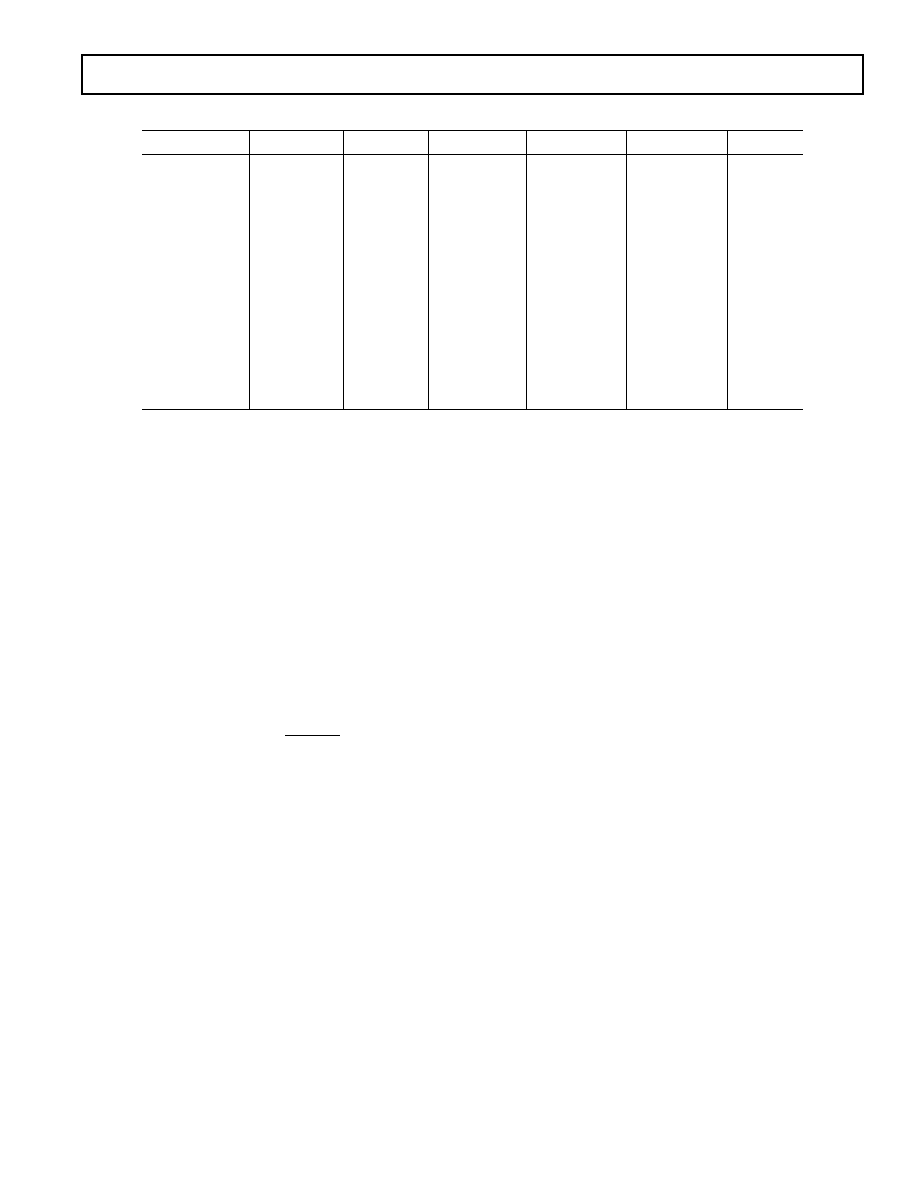
REV. 0
AD6634
25
where, IN is the value of IN[13:0], EXP is the value of EXP[2:0],
and rCIC2 is the value of the 0x92 (rCIC2_QUIET[4:0], and
rCIC2_LOUD[4:0]) scale register.
rCIC2 Rejection
Table III illustrates the amount of bandwidth in percent of the
data rate into the rCIC2 stage. The data in this table may be
scaled to any other allowable sample rate up to 80 MHz in
Single Channel Mode or 40 MHz in Diversity Channel Mode.
Table III can be used as a tool to decide how to distribute the
decimation between rCIC2, CIC5, and the RCF.
Example Calculations
Goal: Implement a filter with an Input Sample Rate of 10 MHz
requiring 100 dB of Alias Rejection for a
±7 kHz pass band.
Solution: First determine the percentage of the sample rate that
is represented by the pass band.
BW
kHz
MHz
FRACTION
=
×
=
100
7
10
0 07
.
Find the 100 dB column on the right of Table III and look down
this column for a value greater than or equal to the pass-band
percentage of the clock rate. Then look across to the extreme
left column and find the corresponding rate change factor
(M
rCIC2
/L
rCIC2
). Referring to the table, notice that for a
M
rCIC2
/L
rCIC2
of 4, the frequency having 100 dB of alias
rejection is 0.071 percent, which is slightly greater than the 0.07
percent calculated. Therefore, for this example, the maximum
bound on rCIC2 rate change is 4. A higher chosen M
rCIC2
/L
rCIC2
means less alias rejection than the 100 dB required.
An M
rCIC2
/L
rCIC2
of less than 4 would still yield the required
rejection; however, the power consumption can be minimized by
decimating as much as possible in this rCIC2 stage. Decimation in
rCIC2 lowers the data rate, and thus reduces power consumed in
subsequent stages. It should also be noted that there is more than
one way to get the decimation by 4. A decimation of 4 is the
same as an L/M ratio of 0.25. Thus any integer combination of
L/M that yields 0.25 will work (1/4, 2/8, or 4/16). However, for
the best dynamic range, the simplest ratio should be used. For
example, 1/4 gives better performance than 4/16.
Decimation and Interpolation Registers
rCIC2 decimation values are stored in register 0x90. This is a
12-bit register and contains the decimation portion less 1. The
interpolation portion is stored in register 0x91. This 9-bit value
holds the interpolation less one.
rCIC2 Scale
Register 0x92 contains the scaling information for this section of
the circuit. The primary function is to store the scale value
computed in the sections above.
Bits 40 (rCIC2_LOUD[4:0]) of this register are used to contain
the scaling factor for the rCIC2 during conditions of strong
signals. These five bits represent the rCIC2 scalar calculated
above plus any external signal scaling with an attenuator.
Bits 95 (rCIC2_QUIET[4:0]) of this register are used to contain
the scaling factor for the rCIC2 during conditions of weak signals.
In this register, an external attenuator would not be used and is not
included. Only the value computed above is stored in these bits.
Bit 10 of this register is used to indicate the value of the external
exponent. If this bit is set LOW, then each external exponent
represents 6 dB per step as in the AD6600. If this bit is set to
HIGH, each exponent represents a 12 dB step.
Bit 11 of this register is used to invert the external exponent before
internal calculation. This bit should be set HIGH for gain ranging
ADCs that use an increasing exponent to represent an increasing signal
level. This bit should be set LOW for gain ranging ADCs that use
a decreasing exponent for representing an increasing signal level.
In applications that do not require the features of the rCIC2, it
may be by setting the L/M ratio to 1/1. This effectively bypasses
all circuitry of the rCIC2 except the scaling that is still effectual.
FIFTH ORDER CIC FILTER
The third signal processing stage, CIC5, implements a sharper
fixed-coefficient, decimating filter than rCIC2. The input rate
to this filter is f
SAMP2
. The maximum input rate is given by the
equation below. N
CH
equals 2 for diversity channel real input
mode; otherwise N
CH
equals 1. In order to satisfy this equation,
M
rCIC2
can be increased, N
CH
can be reduced, or f
CLK
can be
increased (reference fractional rate input timing described in the
Input Timing section).
Table III. SSB rCIC2 Alias Rejection Table (f
SAMP
= 1) Bandwidth Shown in Percentage of f
SAMP
M
rCIC2
/L
rCIC2
50 dB
60 dB
70 dB
80 dB
90 dB
100 dB
2
1.79
1.007
0.566
0.318
0.179
0.101
3
1.508
0.858
0.486
0.274
0.155
0.087
4
1.217
0.696
0.395
0.223
0.126
0.071
5
1.006
0.577
0.328
0.186
0.105
0.059
6
0.853
0.49
0.279
0.158
0.089
0.05
7
0.739
0.425
0.242
0.137
0.077
0.044
8
0.651
0.374
0.213
0.121
0.068
0.038
9
0.581
0.334
0.19
0.108
0.061
0.034
10
0.525
0.302
0.172
0.097
0.055
0.031
11
0.478
0.275
0.157
0.089
0.05
0.028
12
0.439
0.253
0.144
0.082
0.046
0.026
13
0.406
0.234
0.133
0.075
0.043
0.024
14
0.378
0.217
0.124
0.07
0.04
0.022
15
0.353
0.203
0.116
0.066
0.037
0.021
16
0.331
0.19
0.109
0.061
0.035
0.02

REV. 0
26
AD6634
f
f
N
SAMP
CLK
CH
2
The decimation ratio, M
CIC5
, may be programmed from 2 to 32
(all integer values). The frequency response of the filter is given
by the following equations. The gain and pass-band droop of
CIC5 should be calculated by these equations. Both parameters
may be compensated for in the RCF stage.
H z
z
z
H f
M
f
f
f
f
S
M
S
CIC
SAMP
SAMP
CIC
CIC
CIC
( )
=
-
-
( )
=
×
+
-
-
+
1
2
1
1
1
2
5
5
5
5
1
5
5
5
2
2
5
sin
sin
The scale factor, S
CIC5
is a programmable unsigned integer between
0 and 20. It serves to control the attenuation of the data into the
CIC5 stage in 6 dB increments. For the best dynamic range, S
CIC5
should be set to the smallest value possible (lowest attenuation)
without creating an overflow condition. This can be safely accom-
plished using the following equation, where OL
rCIC2
is the largest
fraction of full scale possible at the input to this filter stage. This
value is output from the rCIC2 stage then pipelined into the CIC5.
S
ceil
M
OL
OL
M
OL
CIC
CIC
rCIC
rCIC
CIC
S
rCIC
CIC
5
2
5
5
2
2
5
5
5
2
5
2
5
=
×
(
)
=
(
)
×
+
log
The output rate of this stage is given by the equation below.
f
f
M
SAMP
SAMP
CIC
5
2
5
=
CIC5 Rejection
Table IV illustrates the amount of bandwidth in percentage of
the clock rate that can be protected with various decimation
rates and alias rejection specifications. The maximum input rate
into the CIC5 is 80 MHz when the rCIC2 decimates by 1. As in
the Table III, these are the one-half bandwidth characteristics of
the CIC5. Notice that the CIC5 stage can protect a much wider
band to any given rejection.
This table helps to calculate an upper bound on decimation,
M
CIC5
, given the desired filter characteristics.
Table IV. SSB CIC5 Alias Rejection Table (f
SAMP2
= 1)
MCIC5
50 dB
60 dB
70 dB
80 dB
90 dB
100 dB
2
10.227
8.078
6.393
5.066
4.008
3.183
3
7.924
6.367
5.11
4.107
3.297
2.642
4
6.213
5.022
4.057
3.271
2.636
2.121
5
5.068
4.107
3.326
2.687
2.17
1.748
6
4.267
3.463
2.808
2.27
1.836
1.48
7
3.68
2.989
2.425
1.962
1.588
1.281
8
3.233
2.627
2.133
1.726
1.397
1.128
9
2.881
2.342
1.902
1.54
1.247
1.007
10
2.598
2.113
1.716
1.39
1.125
0.909
11
2.365
1.924
1.563
1.266
1.025
0.828
12
2.17
1.765
1.435
1.162
0.941
0.76
13
2.005
1.631
1.326
1.074
0.87
0.703
14
1.863
1.516
1.232
0.998
0.809
0.653
15
1.74
1.416
1.151
0.932
0.755
0.61
16
1.632
1.328
1.079
0.874
0.708
0.572
17
1.536
1.25
1.016
0.823
0.667
0.539
18
1.451
1.181
0.96
0.778
0.63
0.509
19
1.375
1.119
0.91
0.737
0.597
0.483
20
1.307
1.064
0.865
0.701
0.568
0.459
21
1.245
1.013
0.824
0.667
0.541
0.437
22
1.188
0.967
0.786
0.637
0.516
0.417
23
1.137
0.925
0.752
0.61
0.494
0.399
24
1.09
0.887
0.721
0.584
0.474
0.383
25
1.046
0.852
0.692
0.561
0.455
0.367
26
1.006
0.819
0.666
0.54
0.437
0.353
27
0.969
0.789
0.641
0.52
0.421
0.34
28
0.934
0.761
0.618
0.501
0.406
0.328
29
0.902
0.734
0.597
0.484
0.392
0.317
30
0.872
0.71
0.577
0.468
0.379
0.306
31
0.844
0.687
0.559
0.453
0.367
0.297
32
0.818
0.666
0.541
0.439
0.355
0.287
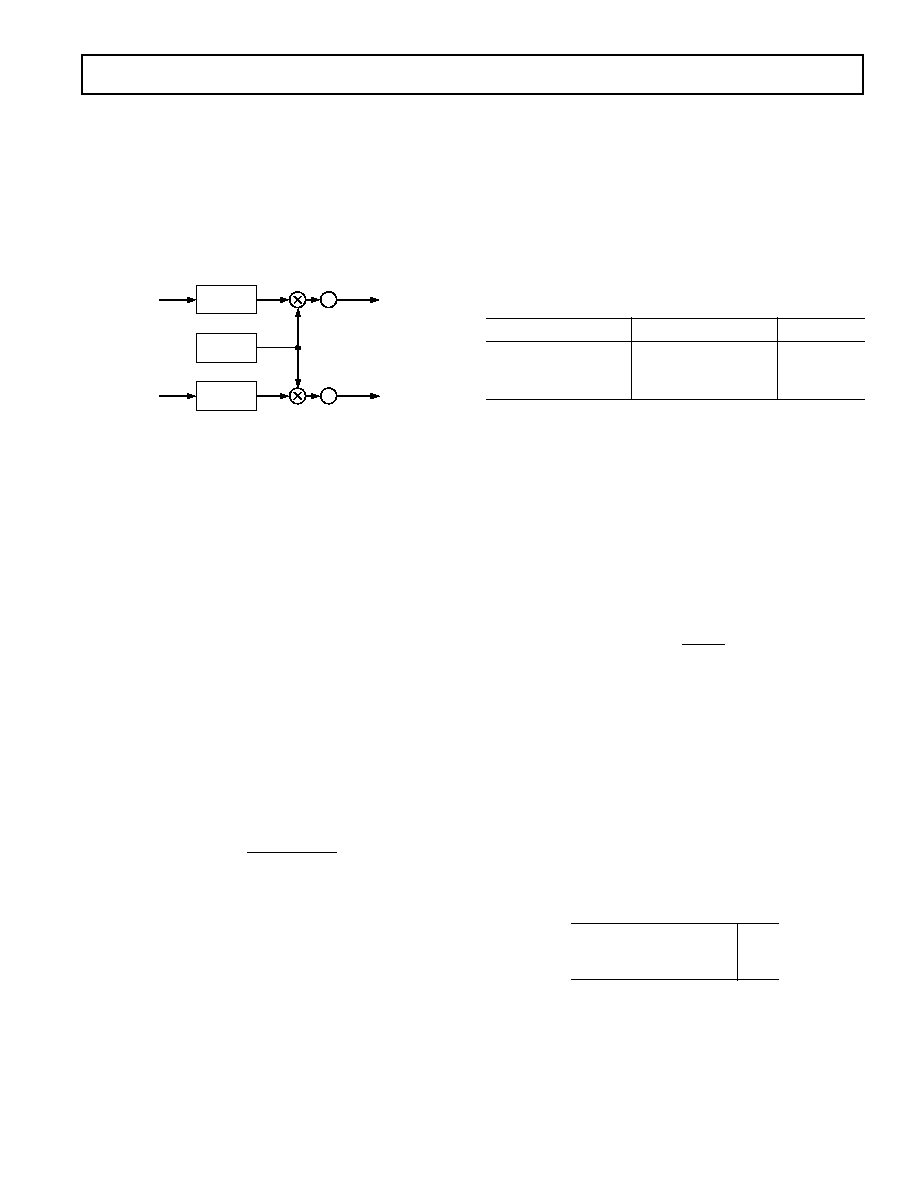
REV. 0
AD6634
27
RAM COEFFICIENT FILTER
The final signal processing stage is a sum-of-products decimat-
ing filter with programmable coefficients. A simplified block
diagram is shown in Figure 31. The data memories I-RAM and
Q-RAM store the 160 most recent complex samples from the
previous filter stage with 20-bit resolution. The coefficient
memory, CMEM, stores up to 256 coefficients with 20-bit
resolution. On every CLK cycle, one tap for I and one tap for Q
are calculated using the same coefficients. The RCF output
consists of 24-bit data bits.
160 20B
I-RAM
I IN
I OUT
256 20B
C-RAM
160 20B
Q-RAM
Q IN
Q OUT
Figure 31. RAM Coefficient Filter Block Diagram
RCF Decimation Register
Each RCF channel can be used to decimate the data rate. The
decimation register is an 8-bit register and can decimate from
1 to 256. The RCF decimation is stored in 0xA0 in the form of
M
RCF
1. The input rate to the RCF is f
SAMP5
.
RCF Decimation Phase
The RCF decimation phase can be used to synchronize multiple
filters within a chip. This is useful when using multiple channels
within the AD6634 to implement the polyphase filter, allowing the
resources of several filters to be paralleled. In such an application,
two RCF filters would be processing the same data from the CIC5.
However, each filter will be delayed by one-half the decimation
rate, thus creating a 180 degree phase difference between the two
halves. The AD6634 filter channel uses the value stored in this
register to preload the RCF counter. Therefore, instead of starting
from 0, the counter is loaded with this value, thus creating an
offset in the processing that should be equivalent to the required
processing delay. This data is stored in 0xA1 as an 8-bit number.
RCF Filter Length
The maximum number of taps this filter can calculate, N
taps
, is
given by the equation below. The value N
taps
1 is written to the
channel register within the AD6634 at address 0xA2.
N
f
M
f
taps
CLK
RCF
SAMP
×
min
5
160
,
The RCF coefficients are located in addresses 0x00 to 0x7F and
are interpreted as 20-bit two's complement numbers. When
writing the coefficient RAM, the lower addresses will be multi-
plied by relatively older data from the CIC5 and the higher
coefficient addresses will be multiplied by relatively newer data
from the CIC5. The coefficients need not be symmetric and the
coefficient length, N
taps
, may be even or odd. If the coefficients
are symmetric, then both sides of the impulse response must be
written into the coefficient RAM.
Although the base memory for coefficients is only 128 words long,
the actual length is 256 words long. There are two pages, each of
128 words long. The page is selected by Bit 8 of 0xA4. Although
this data must be written in pages, the internal core handles filters
that exceed the length of 128 taps. Therefore, the full length
of the data RAM may be used as the filter length (160 taps).
The RCF stores the data from the CIC5 into a 160
× 40 RAM.
160
× 20 is assigned to I data and 160 × 20 is assigned to Q data.
The RCF uses the RAM as a circular buffer, so it is difficult to know
in which address a particular data element is stored.
When the RCF is triggered to calculate a filter output, it starts by
multiplying the oldest value in the data RAM by the first coeffi-
cient, which is pointed to by the RCF Coefficient Offset Register
(0xA3). This value is accumulated with the products of newer
data-words multiplied by the subsequent locations in the coefficient
RAM until the coefficient address RCF
OFF
+ N
taps
1 is reached.
Table V. Three-Tap Filter
Coefficient Address
Impulse Response
Data
0
h(0)
N(0) oldest
1
h(1)
N(1)
2 = (N
taps
1)
h(2)
N(2) newest
The RCF Coefficient Offset register can be used for two purposes.
The main purpose of this register is to allow for multiple filters
to be loaded into memory and selected simply by changing the
offset as a pointer for rapid filter changes. The other use of this
register is to form part of the symbol timing adjustment. If the
desired filter length is padded with zeros on the ends, the starting
point can be adjusted to form slight delays in when the filter is
computed with reference to the high speed clock. This allows for
vernier adjustment of the symbol timing. Course adjustments can
be made with the RCF Decimation Phase.
The output rate of this filter is determined by the output rate of
the CIC5 stage and M
RCF
.
f
f
M
SAMPR
SAMP
RCF
=
5
RCF Output Scale Factor and Control Register
Register 0xA4 is a compound register and is used to configure
several aspects of the RCF register. Bits 30 are used to set the
scale of the fixed-point output mode. This scale value may also
be used to set the floating-point outputs in conjunction with
Bit 6 of this register.
Bits 4 and 5 determine the output mode. Mode 00 sets up the chip
in fixed-point mode. The number of bits is determined by the
parallel or link port configuration.
Mode 01 selects floating-point mode 8 + 4. In this mode, an 8-bit
mantissa is followed by a 4-bit exponent. In mode 1x (x is don't
care), the mode is 12 + 4, or 12-bit mantissa and 4-bit exponent.
Table VI. Output Mode Formats
Floating Point 12 + 4
1x
Floating Point 8 + 4
01
Fixed Point
00
Normally, the AD6634 will determine the exponent value that
optimizes numerical accuracy. However, if Bit 6 is set, the value
stored in Bits 30 is used to scale the output. This ensures
consistent scaling and accuracy during conditions that may warrant
predictable output ranges. If Bits 30 are represented by RCF
Scale, the scaling factor in dB is given by:
Scaling Factor
RCF Scale
dB
=
(
)
×
( )
3
20
2
log
10
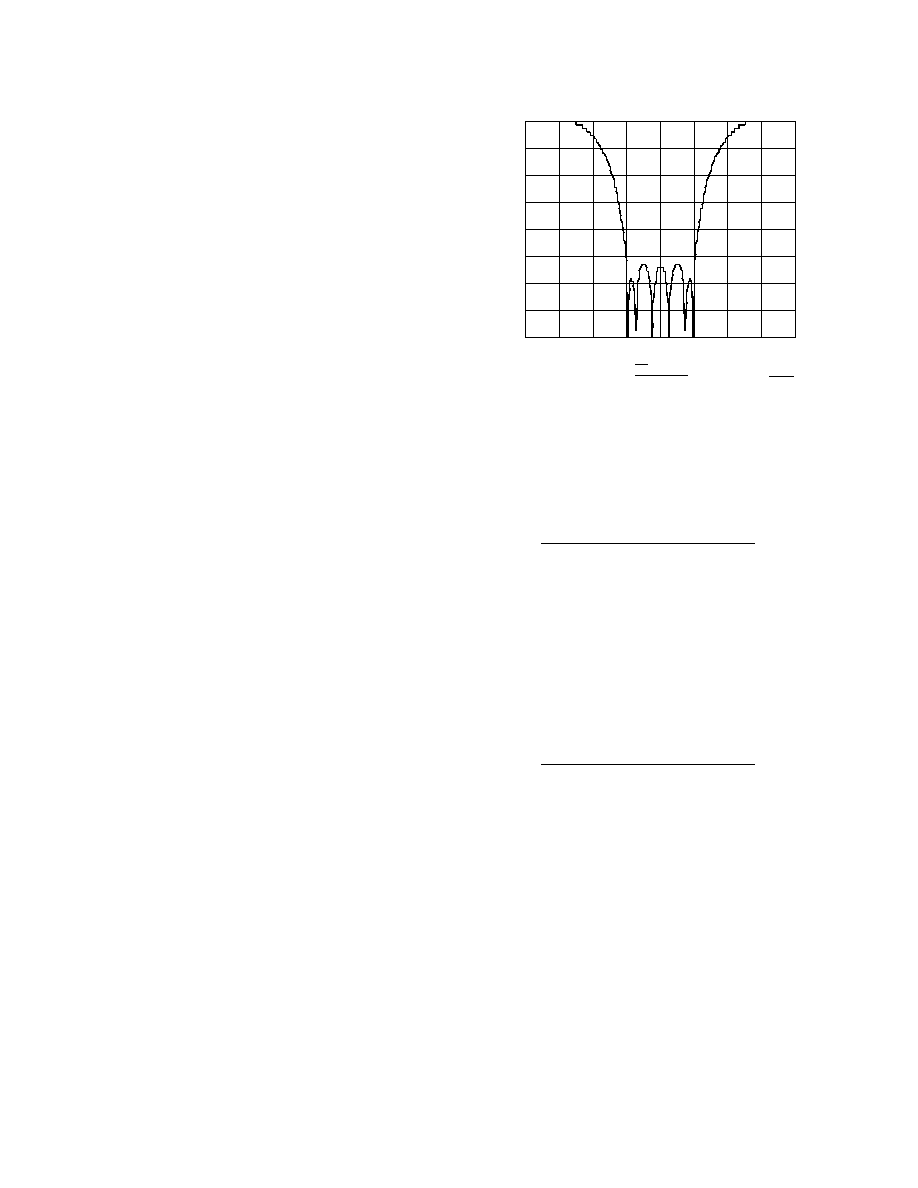
REV. 0
28
AD6634
For RCF Scale of 0, Scaling Factor is equal to 18.06 dB, and for
maximum RCF Scale of 15, Scaling Factor is equal to 72.25 dB.
If Bit 7 is set, the same exponent will be used for both the real
and imaginary (I and Q) outputs. The exponent used will be the
one that prevents numeric overflow at the expense of small
signal accuracy. However, this is seldom a problem as small
numbers would represent 0 regardless of the exponent used.
Bit 8 is the RCF bank select bit used to program the register. When
this bit is 0, the lowest block of 128 is selected (taps 0 through
127). When high, the highest block is selected (taps 128 through
255). It should be noted that while the chip is computing filters,
tap 127 is adjacent to 128 and there are no paging issues.
Bit 9 selects where the input to each RCF originates. If Bit 9 is clear,
the RCF input comes from the CIC5 normally associated with
the RCF. If, however, the bit is set, the input comes from CIC5
channel 1. The only exception is channel 1, which uses the output
of CIC5 channel 0 as its alternate. Using this feature, each RCF
can operate on its own channel data or be paired with the RCF
of channel 1. The RCF of channel 1 can also be paired with chan-
nel 0. This control bit is used with polyphase distributed filtering.
If Bit 10 is clear, the AD6634 channel operates in normal mode.
However, if Bit 10 is set, the RCF is bypassed to Channel BIST.
See the BIST (Built-In Self-Test) section for more details.
INTERPOLATING HALF-BAND FILTERS
The AD6634 has two interpolating half-band finite impulse
response filters that immediately precede the two digital AGCs
and follow the four RCF channel outputs. Each interpolating
half-band takes 16-bit I and 16-bit Q data from the preceding
RCF and outputs 16-bit I and 16-bit Q to the AGC. The half-band
and AGC operate independently of each other, so the AGC can
be bypassed, in which case the output of the half-band is sent
directly to the output data port. The half-bands also operate
independently of each other--either one can be enabled or
disabled. The control register for half-band A is at address 0x08
and for half-band B, address 0x09.
Half-band filters also perform the function of interleaving data
from various RCF channel outputs prior to the actual function
of interpolation. This interleaving of data is allowed even when
the actual function of Half-band filter is bypassed. This feature
allows for the usage of multiple channels (implementing a
polyphase filter) on the AD6634 to process a single carrier. Either
RCF phase decimation or start hold-off counter for the channels
is used to appropriately phase the channels. For example, if two
channels of AD6634 are used to process one CDMA2000 carrier,
RCF filters for both the channels should be 180
° out of phase.
This can be done using RCF phase decimation or an appropriate
start hold-off counter followed by appropriate NCO phase offsets.
Half-band A can listen to all four channels: 0, 1, 2, and 3; channel
0 and 1; or only channel 0. Half-band B can listen to channels 2
and 3, or only channel 2. Each half-band interleaves the channels
specified in its control register and interpolates by 2 on the
combined data from those channels. For one channel running at
twice the chip rate, the half-band can be used to output channel
data at 43 the chip rate.
With respect to the chip rate, the frequency response of the
interpolating half-band FIR is shown in Figure 32.
MULTIPLES OF CHIP RATE
0
0
1.0
2.0
3.0
3.5
4.0
dB(
SPECTR
UM_COEF
)
20
40
60
70
80
0.5
1.5
2.5
10
30
50
SPECTRUM OF HALF-BAND
i
N
f
SAMP
f
CHIP
f
SAMP
f
CHIP
Figure 32. Interpolating Half-Band Frequency Response
The SNR of the interpolating half-band is around 149.6 dB.
The highest error spurs due to fixed-point arithmetic are around
172.9 dB. The coefficients of the 13-tap interpolating half-band
FIR are given in the Table VII.
Table VII. Half-Band Coefficients
0
14
0
66
0
309
512
309
0
66
0
14
0
AUTOMATIC GAIN CONTROL
The AD6634 is equipped with two independent automatic gain
control (AGC) loops for direct interface with a RAKE receiver.
Each AGC circuit has 96 dB of range. It is important that the
decimating filters of the AD6634 preceding the AGC reject
undesired signals, so that each AGC loop is only operating on
the carrier of interest and carriers at other frequencies do not
affect the ranging of the loop.
The AGC compresses the 23-bit complex output from the inter-
polating half-band filter into a programmable word size of 48,
10, 12, or 16 bits. Since the small signals from the lower bits are
pushed into higher bits by adding gain, the clipping of the lower
bits does not compromise the SNR of the signal of interest. The
AGC maintains a constant mean power on the output despite the
level of the signal of interest, allowing operation in environments
where the dynamic range of the signal exceeds the dynamic range
of the output resolution.
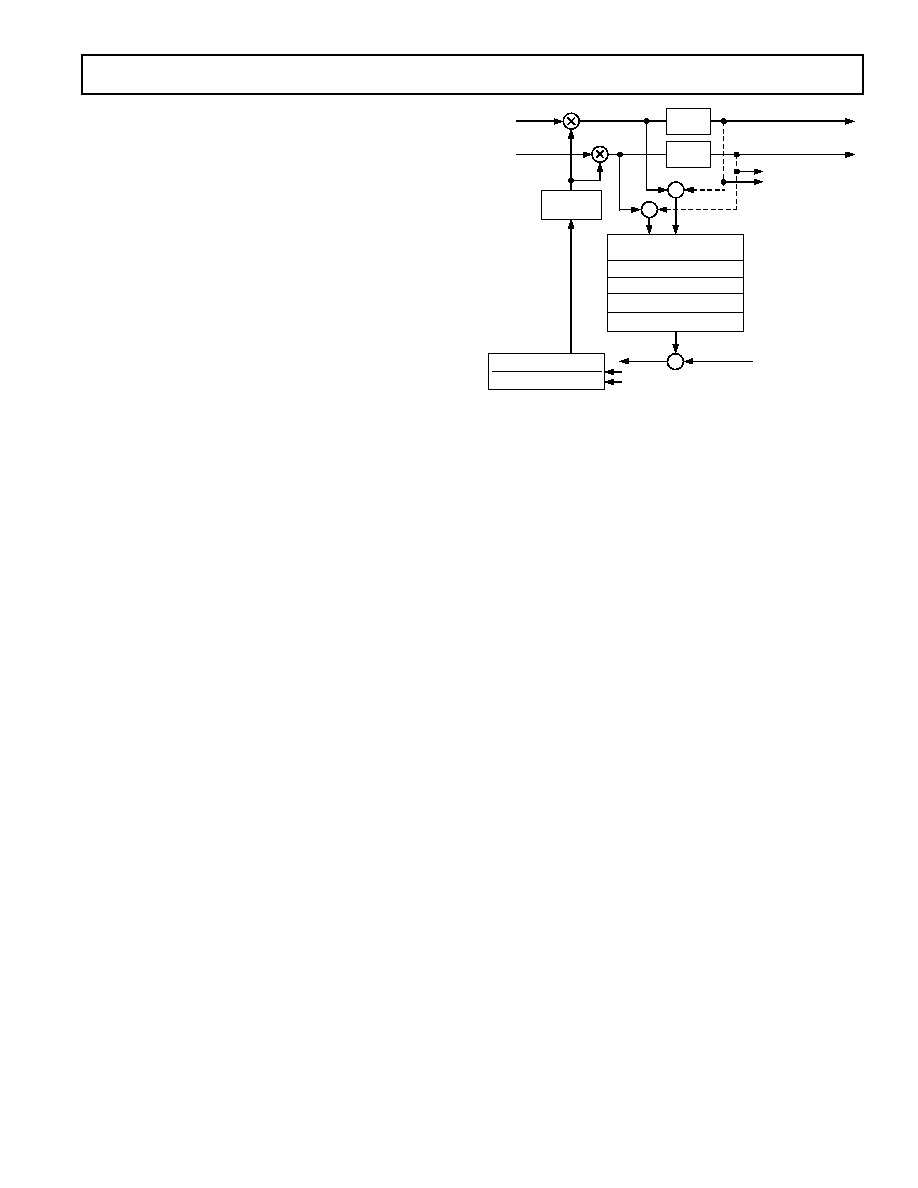
REV. 0
AD6634
29
The AGC and the interpolation filters are not tied together and
any one, or both of them, can be selected without the other. The
AGC section can be bypassed, if desired, by setting Bit 0 of the
AGC control word. When bypassed, the I/Q data is still clipped
to a desired number of bits and a constant gain can be provided
through the AGC Gain multiplier.
There are three sources of error introduced by the AGC function:
underflow, overflow, and modulation. Underflow is caused by
truncation of bits below the output range. Overflow is caused by
clipping errors when the output signal exceeds the output
range. Modulation error occurs when the output gain varies
during the reception of data.
The desired signal level should be set based on the probability
density function of the signal so that the errors due to underflow
and overflow are balanced. The gain and damping values of the
loop filter should be set so that the AGC is fast enough to track
long-term amplitude variations of the signal that might cause
excessive underflow or overflow, but slow enough to avoid
excessive loss of amplitude information due to the modulation
of the signal.
The AGC Loop
The AGC loop is implemented using a log-linear architecture.
It contains four basic operations: power calculation, error calcu-
lation, loop filtering, and gain multiplication.
The AGC can be configured to operate in one of two modes:
Desired Signal level mode or Desired Clipping level mode as set
by Bit 4 of AGC control word (0x0A, 0x12). The AGC adjusts
the gain of the incoming data according to how far it is from a
given desired signal level or desired clipping level, depending on
the mode of operation selected. Two data paths to the AGC
loop are provided: one before the clipping circuitry and one
after the clipping circuitry, as shown in Figure 33. For Desired
Signal level mode, only the I/Q path from before the clipping is
used. For Desired Clipping level mode, the difference of the
I/Q signals from before and after the clipping circuitry is used.
Desired Signal Level Mode
In this mode of operation, the AGC strives to maintain the output
signal at a programmable set level. This mode of operation is
selected by putting a value of zero in Bit 4 of AGC control word
(0x0A, 0x12). First, the loop finds the square (or power) of the
incoming complex data signal by squaring I and Q and adding
them. This operation is implemented in exponential domain
using 2
x
(power of 2).
The AGC loop has an average and decimate block. This average
and decimate operation takes place on power samples and before
the square root operation. This block can be programmed to
average 116384 power samples and the decimate section can
be programmed to update the AGC once every 14096 samples.
The limitation on the averaging operation is that the number of
averaged power samples should be a multiple of the decimation
value (1 , 2 , 3 , or 4 times).
The averaging and decimation effectively means the AGC can
operate over averaged power of 116384 output samples. The
choice of updating the AGC once every 14096 samples and
operating on average power facilitates the implementation of
loop filter with slow time constants, where the AGC error con-
verges slowly and makes infrequent gain adjustments. It would
also be useful in scenarios where the user wants to keep the gain
scaling constant over a frame of data (or a stream of symbols).
CLIP
I
23 BITS
Q
CLIP
MEAN SQUARE (I+jQ)
AVERAGE 116384 SAMPLES
DECIMATE 14096 SAMPLES
SQUARE ROOT
USED ONLY FOR
DESIRED
CLIPPING LEVEL
MODE
GAIN
MULTIPLIER
I
Q
2
X
POWER OF 2
Kz
1
1 (1 + P)z
1
+ Pz
2
ERROR
'K' GAIN
'P' POLE
+
'R' DESIRED
PROGRAMMABLE
BIT WIDTH
LOG
2
(X)
Figure 33. Block Diagram of the AGC
Due to the limitation on the number of average samples to be a
multiple of decimation value, only the multiple number 1, 2, 3,
or 4 is programmed. This number is programmed in Bits 1,0 of
0x10 and 0x18 registers. These averaged samples are then deci-
mated with decimation ratios programmable from 1 to 4096. This
decimation ratio is defined in 12-bit registers 0x11 and 0x19.
The average and decimate operations are tied together and
implemented using a first-order CIC filter and some FIFO
registers. There is a gain and bit growth associated with CIC
filters and these depend on the decimation ratio. To compen-
sate for the gain associated with these operations, attenuation
scaling is provided before the CIC filter.
This scaling operation accounts for the division associated with
averaging operation as well as the traditional bit growth in CIC
filters. Since this scaling is implemented as a bit shift operation,
only coarse scaling is possible. Fine scale is implemented as an
offset in the request level explained later. The attenuation scaling
S
CIC
is programmable from 0 to 14 using four bits of 0x10 and
0x18 registers and is given by:
S
ceil
M
N
CIC
CIC
AVG
=
×
(
)
[
]
log
2
where, M
CIC
is the decimation ratio (14096) and N
AVG
is the
number of averaged samples programmed as a multiple of deci-
mation ratio (1, 2, 3, or 4).
For example, if a decimation ratio M
CIC
is 1000 and N
AVG
is
selected to be 3 (decimation of 1000 and averaging of 3000
samples), the actual gain due to averaging and decimation is 3000
or 69.54 dB ( = log
2
(3000)). Since attenuation is implemented
as a bit shift operation, only multiples of 6.02 dB attenuations
are possible. S
CIC
in this case is 12, corresponding to 72.24 dB.
This way, S
CIC
scaling always attenuates more than sufficient to
compensate for the gain changes in average and decimate sections
and thus prevents overflows in the AGC loop. It is also evident
that the CIC scaling is inducing a gain error (difference between
gain due to CIC and attenuation provided) of up to 6.02 dB.
This error should be compensated for in the request signal level as
explained below.
Logarithm to the base 2 is applied to the output from the average
and decimate section. These decimated power samples (in logarith-
mic domain) are converted to rms signal samples by applying a
square root. This square root is implemented using a simple shift

REV. 0
30
AD6634
operation. The rms samples so obtained are subtracted from the
request signal level, R, specified in registers (0x0B, 0x14), leaving
an error term to be processed by the loop filter, G(z).
The user sets this programmable request signal level, R, according
to the output signal level desired. The request signal level, R,
is programmable from 0 dB to 23.99 dB in steps of 0.094 dB.
The request signal level should also compensate for error, if any,
due to the CIC scaling as explained previously. Therefore, the
request signal level is offset by the amount of error induced in
CIC, given by,
Offset
M
N
S
CIC
AVG
CIC
=
×
×
(
)
×
20
6 02
10
log
.
where the offset is in dB. Continuing with the previous example
this offset is given by, Offset = 72.24 69.54 = 2.7 dB. The
request signal level is given by,
R
ceil
DSL
offset
=
(
)
×
.
.
0 094
0 094
where R is the request signal level and DSL (Desired Signal Level)
is the output signal level that the user desires. In the previous
example if the desired signal level is 13.8 dB, the request level,
R, is programmed to be 16.54 dB.
The AGC provides a programmable second order loop filter. The
programmable parameters gain, K, and pole, P, completely define
the loop filter characteristics. The error term after subtracting
the request signal level is processed by the loop filter, G(z). The
open loop poles of the second order loop filter are `1' and, P,
respectively. The loop filter parameters, pole, P, and gain, K,
allow adjustment of the filter time constant that determines the
window for calculating the peak-to-average ratio.
The open loop transfer function for the filter including the gain
parameter is given below.
G z
Kz
P z
Pz
( )
=
+
(
)
+
1
1
2
1
1
If the AGC is properly configured (in terms of offset in request
level), there are no gains except the filter gain K. Under these
circumstances, a closed loop expression for the AGC loop is
possible and is given by,
G
z
G z
G z
Kz
K
P z
Pz
CLOSED
( )
=
( )
+
( )
=
+
(
)
+
1
1
1
1
1
2
The gain parameter K and pole P are programmable through regis-
ters (0x0E and 0x0F, respectively, for AGC channel A and B) from
0 to 0.996 in steps of 0.0039 using 8-bit representation. Though
the user defines the open loop pole P and gain K, they will directly
impact the placement of the closed loop poles and filter character-
istics. These closed loop poles P
1
, P
2
, are the roots of the denominator
of the above closed loop transfer function and are given by,
P P
P
K
P
K
P
1
2
2
1
1
4
2
,
=
+
(
)
+
+
(
)
Typically, the AGC loop performance is defined in terms of its time
constant or settling time. In such a case the closed loop poles
should be set to meet the time constants required by the AGC
loop. The following relation between time constant and closed loop
poles can be used for this purpose.
P
M
SAMPLE RATE
CIC
1 2
1 2
,
,
=
×
exp
where
1 2
,
are the time constants corresponding to the poles
P
1, 2
. The time constants can also be derived from settling times
as given below,
2
4
5
3
%
%
Setting Time
or
Setting Time
M
CIC
(CIC decimation is from 1 to 4096), and either the settling
time or time constant should be chosen by the user. The sample
rate is the combined sample rate of all the interleaved channels
coming into the AGC/half-band interpolated filters. If two chan-
nels are being used to process one carrier of UMTS at 2 chip
rate, each channel works at 3.84 MHz and the combined sample
rate coming into the half-band interpolated filters is 7.68 MSPS.
This rate should be used in the calculation of poles in the above
equation, if half-band interpolating filters are bypassed.
The loop filter output corresponds to the signal gain that is
updated by the AGC. Since all computation in the loop filter is
done in logarithmic domain (to the base 2) of the samples, the
signal gain is generated using the exponent (power of 2) of the
loop filter output.
The gain multiplier gives the product of the signal gain with
both the I and Q data entering the AGC section. This signal
gain is applied as a coarse 4-bit scaling and then a fine scale
8-bit multiplier. Thus the applied signal gain is between
0 dB and 96.296 dB in steps of 0.024 dB. Initial value for signal
gain is programmable using the registers 0x0D and 0x15 for
AGC A and AGC B, respectively.
The products of the gain multiplier, the AGC scaled outputs,
have 19-bit representation. These are in turn used as I and Q
for calculating the power and AGC error and loop filtered to
produce signal gain for next set of samples. These AGC scaled
outputs can be programmed to have 4, 5, 6, 7, 8, 10, 12, or
16-bit widths using the AGC control word (0x0A, 0x12). The
AGC scaled outputs are truncated to required bit widths using
the clipping circuitry as shown in the block diagram.
Open Loop Gain Setting
If filter gain K occupies only one LSB, or 0.0039, during the
multiplication with error term, errors of up to 6.02 dB could be
truncated. This truncation is due to the lower bit widths avail-
able in the AGC loop. If filter gain K were the maximum value,
truncated errors would be a less than 0.094 dB (equivalent to
1 LSB of error term representation). Generally, a small filter
gain is used to achieve a large time constant loop (or slow loops),
but in this case it would cause large errors to go undetected.
Due to this peculiarity, the designers recommend that if a user
wants slow AGC loops that they use fairly high values for filter
gain K and then use CIC decimation to achieve a slow loop. In
this way, the AGC loop will make large infrequent gain changes
compared to small and frequent gain changes as in the case of
normal small gain loop filter. However, though the AGC loop
makes large infrequent gain changes, a slow time constant is still
achieved and there is lesser truncation of errors.
Average Samples Setting
Though it is complicated to express the exact effect of the num-
ber of averaging samples, thinking intuitively it has a smoothing
effect on the way the AGC loop attacks a sudden increase or a

REV. 0
AD6634
31
spike in the signal level. If averaging of four samples is used, the
AGC will attack a sudden increase in signal level more slowly
compared to no averaging. The same would apply to the manner in
which the AGC would attack a sudden decrease in the signal level.
Desired Clipping Level Mode
As noted previously, each AGC can be configured so that the
loop locks on to a desired clipping level or a desired signal level.
The Desired Clipping Level mode can be selected by setting
Bit 4 of individual AGC control words (0x0A, 0x12). For sig-
nals that tend to exceed the bounds of the peak-to-average ratio,
the desired clipping level option allows a way to keep from truncat-
ing those signals and still provide an AGC that attacks quickly
and settles to the desired output level. The signal path for this
mode of operation is shown with broken arrows in the Func-
tional Block Diagram and the operation is similar to the desired
signal level mode.
First, the data from the gain multiplier is truncated to a lower
resolution (4, 5, 6, 7, 8, 10, 12, or 16 bits) as set by the AGC
control word. An error term (both I and Q) is generated that is
the difference between the signals before and after truncation.
This term is passed to the complex squared magnitude block,
for averaging and decimating the update samples and taking
their square root to find rms samples as in desired signal level
mode. In place of the request desired signal level, a desired
clipping level is subtracted, leaving an error term to be
processed by the second order loop filter. The rest of the loop
operates the same way as the desired signal level mode. This way
the truncation error is calculated and the AGC loop operates to
maintain a constant truncation error level.
Apart from Bit 4 of the AGC control words, the only register
setting changes compared to the Desired Signal level mode is
that the Desired Clipping level is stored in the AGC Desired
Level registers (0x0C, 0x15) instead of the Request Signal level
(as in Desired Signal Level mode).
Synchronization
In scenarios where AGC output is connected to a RAKE receiver,
the RAKE receiver can synchronize the average and update
section to update the average power for AGC error calculation
and loop filtering. This external sync signal synchronizes the
AGC changes to RAKE receiver and makes sure that the AGC
gain word does not change over a symbol period and thus more
accurate estimation. Such synchronization can be accomplished
by setting the appropriate bits of the AGC control register.
When the channel comes out of sleep, it loads the AGC hold-off
counter value and starts counting down, clocked by the Master
clock. When this counter reaches zero, the CIC filter of the
AGC starts decimation and updates the AGC loop filter based
on the CIC decimation value set.
Further, whenever the user wants to synchronize the start of
decimation for a new update sample, an appropriate hold-off
value can be set in AGC hold-off counter (0x0B, 0x13) and the
Sync now bit (Bit 3) in the AGC control word is set. Upon
setting this bit, the hold-off counter value is counted down and
a CIC decimated value is updated on the count of zero.
Along with updating a new value, the CIC filter accumulator
can be reset if Init on Sync bit (Bit 2) of the AGC control word
is set. Each sync will initiate a new sync signal unless first sync
only bit (Bit 1) of the AGC control word is set. If this bit is not
set, again the hold-off counter is loaded with the value in the
hold-off register to count down and repeat the same process.
These additional features make the AGC synchronization more
flexible and applicable to varied circumstances.
Addresses 0x0A0x11 have been reserved for configuring AGC
A and addresses 0x120x19 have been reserved for configuring
AGC B. The register specifications are detailed in the Memory
Map for Output Port Control Registers section.
USER CONFIGURABLE BUILT-IN SELF-TEST (BIST)
The AD6634 includes two built-in test features to test the integrity
of each channel. The first is a RAM BIST (Built-In Self-Test)
and is intended to test the integrity of the high speed random
access memory within the AD6634. The second is Channel BIST,
which is designed to test the integrity of the main signal paths of
the AD6634. Each BIST function is independent of the other,
meaning that each channel can be tested independently at the
same time.
RAM BIST
The RAM BIST can be used to validate functionality of the
on-chip RAM. This feature provides a simple pass/fail test,
which will give confidence that the channel RAM is operational.
The following steps should be followed to perform this test.
1. The channels to be tested should be put into Sleep mode via
the external address register 0x011.
2. The RAM BIST Enable bit in the RCF register 0xA8 should
be set high.
3. Wait 1600 clock cycles.
4. Register 0xA8 should be read back. If Bit 0 is high, the test is
not yet complete. If Bit 0 is low, the test is complete and
Bits 1 and 2 indicate the condition of the internal RAM. If
Bit 1 is high, CMEM is bad. If Bit 2 is high, DMEM is bad.
Table VIII. BIST Register 0xA8
XA8
Coefficient MEM
Data MEM
XX1
Test Incomplete
Test Incomplete
000
Pass
Pass
010
Fail
Pass
100
Pass
Fail
110
Fail
Fail
Channel BIST
The Channel BIST is a thorough test of the selected AD6634
signal path. With this test mode, it is possible to use externally
supplied vectors or an internal pseudo-random generator. An
error signature register in the RCF monitors the output data of
the channel and is used to determine if the proper data exits the
RCF. If errors are detected, each internal block may be bypassed
and another test can be run to debug the fault. The I and Q paths
are tested independently. The following steps should be taken
to perform this test.
1. The channels to be tested should be configured as required
for the application setting the decimation rates, scalars, and
RCF coefficients.
2. The channels should remain in the Sleep mode.
3. The Start Hold-Off counter of the channels to be tested
should be set to 1.
4. Memory location 0xA5 and 0xA6 should be set to 0.
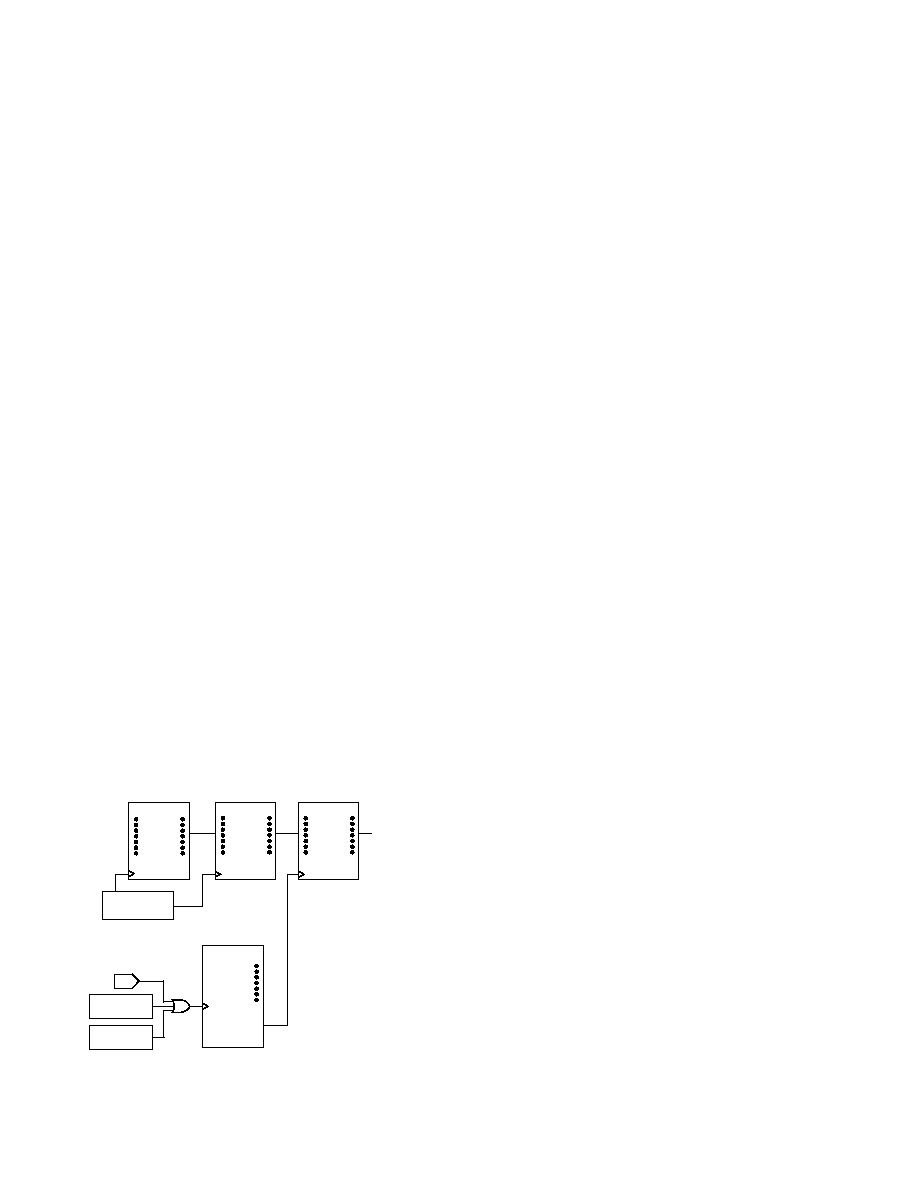
REV. 0
32
AD6634
5. The Channel BIST located at 0xA7 should be enabled by
setting Bits 190 to the number of RCF outputs to observe.
6. Bit 4 of external address register 5 should be set high to
start the soft sync.
7. Set the SYNC bits high for the channels to be tested.
8. Bit 6 must be set to 0 to allow the user to provide test vectors.
The internal pseudo-random number generator may also be
used to generate an input sequence by setting Bit 7 high.
9. An internal full scale sine wave can be inserted when Bit 6
is set to 1 and Bit 7 is cleared.
10. When the SOFT_SYNC is addressed, the selected channels
will come out of the sleep mode and processing will occur.
11. If the user is providing external vectors, the chip may be
brought out of Sleep mode by one of the other methods
provided that either of the IEN inputs is inactive until the
Channel is ready to accept data.
12. After a sufficient amount of time, the Channel BIST Signature
registers 0xA5 and 0xA6 will contain a numeric value that
can be compared to the expected value for a known good
AD6634 with the exact same configuration. If the values
are the same, then there is a very low probability that there
is an error in the channel.
CHIP SYNCHRONIZATION
Two types of synchronization can be achieved with the AD6634.
These are Start and Hop. Each is described in detail below. The
synchronization is accomplished with the use of a shadow register
and a hold-off counter. See Figure 34 for a simplistic schematic of
the NCO Shadow Register and NCO Freq Hold-Off Counter to
understand basic operation. Enabling the clock (AD6634 CLK)
for the hold-off counter can occur with either a Soft_Sync (via the
microport), or a Pin Sync (via any of the four AD6634 SYNC
pins A, B, C, and D). The functions that include shadow registers
to allow synchronization include:
1. Start
2. Hop (NCO Frequency)
I0
I31
Q0
Q31
MICRO
REGISTER
I0
I31
Q0
Q31
SHADOW
REGISTER
I0
I31
Q0
Q31
NCO
FREQUENCY
REGISTER
FROM
MICROPORT
B0
B15
NCO FREQUENCY
UPDATE HOLD OFF
COUNTER
TC
ENB
TO
NCO
SOFT SYNC
ENABLE
AD6634
CLK
PIN SYNC
ENABLE
Figure 34. NCO Shadow Register and Hold-Off Counter
Start
Start refers to the start-up of an individual channel, chip, or
multiple chips. If a channel is not used, it should be put in the
Sleep Mode to reduce power dissipation. Following a hard reset
(low pulse on the AD6634
RESET pin), all channels are placed
in the Sleep Mode. Channels may also be manually put to sleep
by writing to the mode register controlling the sleep function.
Start with No Sync
If no synchronization is needed to start multiple channels or
multiple AD6634s, the following method should be used to
initialize the device.
1. To program a channel, it must first be set to Sleep Mode (bit
high) (Ext Address 3). All appropriate control and memory
registers (filter) are then loaded. The Start Update Hold-Off
Counter (0x83) should be set to 1.
2. Set the Sleep bits low (Ext Address 3). This enables the channel.
The channel must the Sleep Mode low to activate a channel.
Start with Soft Sync
The AD6634 includes the ability to synchronize channels or
chips under microprocessor control. One action to synchronize
is the start of channels or chips. The Start Update Hold-Off
Counter (0x83) in conjunction with the Start bit and Sync bit
(Ext Address 5) allow this synchronization. Basically, the Start
Update Hold-Off Counter delays the Start of a channel(s) by its
value (number of AD6634 CLKs). The following method is
used to synchronize the start of multiple channels via micropro-
cessor control.
1. Set the appropriate channels to sleep mode (a hard reset to the
AD6634 RESET pin brings all four channels up in sleep mode).
2. Note that the time from when DTACK (Pin 57) goes high
to when the NCO begins processing data is the content of
the Start Update Hold-Off Counter(s) (0x83) + 6 master
clock cycles.
3. Write the Start Update Hold-Off Counter(s) (0x83) to the
appropriate value (greater than 1 and less than 2^161). If
the chip(s) is not initialized, all other registers should be
loaded at this step.
4. Write the Start bit and the SYNC bit high (Ext Address 5).
5. This starts the Start Update Hold-Off Counter counting down.
The counter is clocked with the AD6634 CLK signal. When it
reaches a count of 1, the Sleep bit of the appropriate channel(s)
is set low to activate the channel(s).
Start With Pin Sync
The AD6634 has four Sync pins, A, B, C, and D, that can be used
to provide for very accurate synchronization channels. Each
channel can be programmed to look at any of the four sync pins.
Additionally, any or all channels can monitor a single Sync pin or
each can monitor a separate pin, providing complete flexibility of
synchronization. Synchronization of Start with one of the external
signals is accomplished with the following method.
1. Set the appropriate channels to Sleep mode (a hard reset to the
AD6634
RESET pin brings all four channels up in Sleep mode).
2. Note that the time from when the SYNC pin goes high to when
the NCO begins processing data is the content of the Start
Update Hold-Off Counter(s) (0x83) + 3 master clock cycles.
3. Write the Start Update Hold-Off Counter(s) (0x83) to the
appropriate value (greater than 1 and less than 2
16
1). If the
chip(s) is not initialized, all other registers should be loaded
at this step.
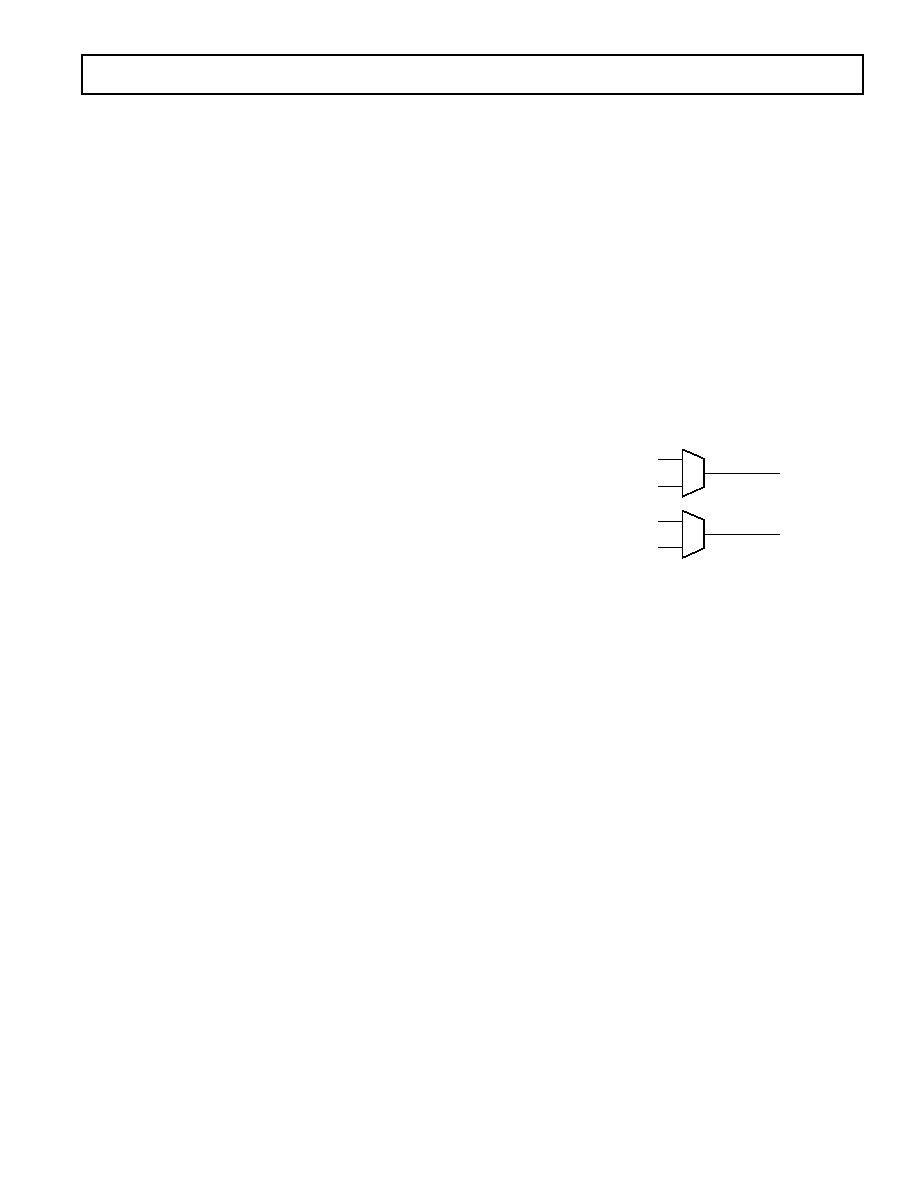
REV. 0
AD6634
33
4. Set the Start on Pin Sync bit and the appropriate Sync Pin
Enable high (Ext Address 4 ) (A, B, C, or D).
5. When the Sync pin is sampled high by the AD6634 CLK, this
enables the count down of the Start Update Hold-Off Counter.
The counter is clocked with the AD6634 CLK signal. When it
reaches a count of 1, the Sleep bit of the appropriate channel(s)
is set low to activate the channel(s).
Hop
Hop is a jump from one NCO frequency to a new NCO
frequency. This change in frequency can be synchronized via
microprocessor control (Soft Sync) or an external Sync signal
(PIN Sync) as described below.
To set the NCO frequency without synchronization the following
method should be used.
Set Freq No Hop
1. Set the NCO Freq Hold-Off counter to 0.
2. Load the appropriate NCO frequency. The new frequency
will be immediately loaded to the NCO.
Hop with Soft Sync
The AD6634 includes the ability to synchronize a change in NCO
frequency of multiple channels or chips under microprocessor
control. The NCO Freq Hold-Off counter (0x84) in conjunction
with the Hop bit and the Sync bit (Ext Address 4) allow this
synchronization. Basically the NCO Freq Hold-Off counter
delays the new frequency from being loaded into the NCO by
its value (number of AD6634 CLKs). The following method is
used to synchronize a hop in frequency of multiple channels via
microprocessor control.
1. Note that the time from when DTACK (Pin 57) goes high to
when the NCO begins processing data is the contents of the
NCO Freq Hold-Off counter (0x84) + 7 master clock cycles.
2. Write the NCO Freq Hold-Off (0x84) counter to the appro-
priate value (greater than 1 and less then 2
16
1).
3. Write the NCO Frequency register(s) to the new desired
frequency.
4. Write the Hop bit and the Sync(s) bit high (Ext Address 4).
5. This starts the NCO Freq Hold-Off counter counting down.
The counter is clocked with the AD6634 CLK signal. When
it reaches a count of 1, the new frequency is loaded into
the NCO.
Hop with Pin Sync
The AD6634 include four Sync pins to provide the most accu-
rate synchronization, especially between multiple AD6634s.
Synchronization of hopping to a new NCO frequency with an
external signal is accomplished with the following method.
1. Note that the time from when the SYNC pin goes high to
when the NCO begins processing data is the contents of the
NCO Freq Hold-Off counter (0x84) + 5 master clock cycles.
2. Write the NCO Freq Hold-Off counter(s) (0x84) to the
appropriate value (greater than 1 and less than 2
16
1).
3. Write the NCO Frequency register(s) to the new desired
frequency.
4. Set the Hop on Pin Sync bit and the appropriate Sync Pin
Enable high.
5. When the selected Sync pin is sampled high by the AD6634
CLK, this enables the countdown of the NCO Freq Hold-Off
counter. The counter is clocked with the AD6634 CLK signal.
When it reaches a count of 1, the new frequency is loaded
into the NCO.
PARALLEL OUTPUT PORTS
The AD6634 incorporates two independent 16-bit parallel ports
for output data transfer. Both parallel ports share pins and internal
mux circuitry. A single parallel port and a single Link Port can
be used simultaneously, but only if they do not share the same
data path; the two possible choices are Parallel Port A with
Link Port B, or Parallel Port B with Link Port A. Figure 35
presents a simplified block diagram showing the AD6634's output
data routing configuration.
OUTPUT PORT A
PARALLEL PORT A
LINK PORT A
OUTPUT PORT B
PARALLEL PORT B
LINK PORT B
Figure 35. Output Port Data Routing
Parallel port configuration is specified by accessing Port Control
Register addresses 0x1A and 0x1C for parallel ports A and B,
respectively. Port clock Master/Slave mode (described later) is
configured using the Port Clock Control register at address
0x1E. Note that to access these registers, Bit 5 (Access Port
Control Registers) of external address 3 (SLEEP register) must
be set. The address is then selected by programming the CAR
register at external address 6.
The parallel ports are enabled by setting Bit 7 of the Link Control
registers at addresses 0x1B and 0x1D for ports A and B,
respectively.
Each parallel port is capable of operating in either Channel mode
or AGC mode. Each mode is described in detail below.
Channel Mode
Parallel port Channel mode is selected by setting Bit 0 of addresses
0x1B and 0x1D for parallel ports A and B, respectively. In
Channel mode, I and Q words from each channel is directed to
the parallel port, bypassing the AGC. The specific channels
output by the port are selected by setting Bits 1 through 4 of
Parallel Port Control Register 0x1A (port A) and 0x1C (port B).
Channel mode provides two data formats. Each format requires a
different number of parallel port clock (PCLK) cycles to complete
the transfer of data. In each case, each data element is trans-
ferred during one PCLK cycle. See Figures 36 and 37, which
present Channel mode parallel port timing.
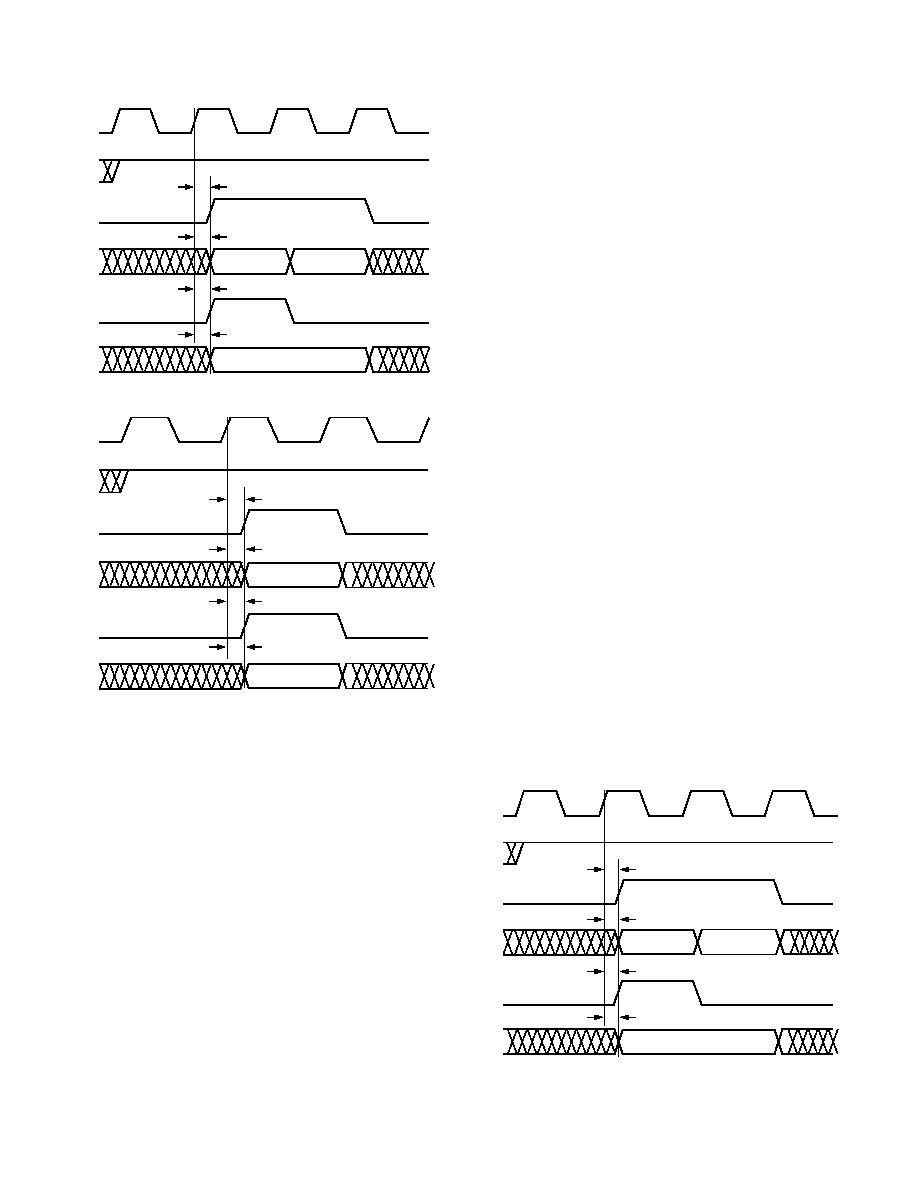
REV. 0
34
AD6634
PCLK
PxREQ
Px[15:0]
PxACK
PxlQ
PxCH[1:0]
PxCH[1:0] = CHANNEL #
I[15:0]
Q[15:0]
t
DPREQ
t
DPCH
t
DPIQ
t
DPP
Figure 36. Channel Mode Interleaved Format
PCLK
PxREQ
Px[15:0]
PxACK
PxlQ
PxCH[1:0]
PxCH[1:0] =
CHANNEL #
I[15:8]; Q[7:0]
t
DPREQ
t
DPCH
t
DPIQ
t
DPP
Figure 37. Channel Mode 8I/8Q Parallel Format
The 16-bit interleaved format provides I and Q data for each
output sample on back-to-back PCLK cycles. Both I and Q
words consist of the full port width of 16 bits. Data output is
triggered on the rising edge of PCLK when both REQ and ACK
are asserted. I data is output during the first PCLK cycle; and the
PAIQ and PBIQ output indicator pins are set high to indicate
that I data is on the bus. Q data is output during the subsequent
PCLK cycle; and the PAIQ and PBIQ output indicator pins are
low during this cycle.
The 8-bit concurrent format provides eight bits of I data and
eight bits of Q data simultaneously during one PCLK cycle, also
triggered on the rising edge of PCLK. The I byte occupies the
most significant byte of the port, while the Q byte occupies the
least significant byte. The PAIQ and PBIQ output indicator
pins are set high during the PCLK cycle. Note that if data from
multiple channels are output consecutively, the PAIQ and PBIQ
output indicator pins will remain high until data from all channels
has been output.
The PACH[1:0] and PBCH[1:0] pins provide a 2-bit binary value
indicating the source channel of the data currently being output.
Care should be taken to read data from the port as soon as possible.
If not, the sample will be overwritten when the next new data
sample arrives. This occurs on a per-channel basis; i.e., a
channel 0 sample will only be overwritten by a new channel 0
sample, and so on.
The order of data output is dependent on when data arrived at
the port, which is a function of total decimation rate, Start-Hold-Off
values, and so on. Priority order is, from highest to lowest,
channels 0, 1, 2, 3.
AGC Mode
Parallel port channel mode is selected by clearing Bit 0 of
addresses 0x1A and 0x1C for parallel ports A and B, respectively.
I and Q data output in AGC mode are output from the AGC, not
the individual channels. Each AGC receives data from only two
AD6634 channels; AGC A accepts data from channels 0 and 1,
while AGC B accepts data from channels 2 and 3. Each pair of
channels is required to be configured such that the generation of
output samples from the channels is out of phase (by typically
180 degrees). Each parallel port can provide data from either one
or both AGCs. Bits 1 and 2 of register addresses 0x1A (port A)
and 0x1C (port B) control the inclusion of data from AGCs
A and B, respectively.
AGC mode provides only one I and Q format, which is similar
to the 16-bit interleaved format of Channel mode. When both
REQ and ACK are asserted, the next rising edge of PCLK
triggers the output of a 16-bit AGC I word for one PCLK cycle.
The PAIQ and PBIQ output indicator pins are high during this
cycle, and low otherwise. A 16-bit AGC Q word is provided
during the subsequent PCLK cycle. If the AGC gain word has
been updated since the last sample, a 12-bit RSSI (Receive Signal
Strength Indicator) word is provided during the PCLK cycle
following the Q word on 12 MSBs of the parallel port data pins.
The RSSI word is the bit-inverse of the Signal Gain word used
in the Gain multiplier of the AGC.
The data provided by the PACH[1:0] and PBCH[1:0] pins in
AGC mode is different than that provided in Channel mode. In
AGC mode, PACH[0] and PBCH[0] indicate the AGC source of
the data currently being output (0 = AGC A, 1 = AGC B). PACH[1]
and PBCH[1] indicate whether the current data is an I/Q word or
an AGC RSSI word (0 = I/Q word, 1 = AGC RSSI word). The
two different AGC outputs are shown in Figures 38 and 39.
PCLK
PxREQ
Px[15:0]
PxACK
PxlQ
PxCH[1:0]
I[15:0]
Q[15:0]
PxCH[0] = AGC #
PxCH[1] = 0
t
DPREQ
t
DPCH
t
DPIQ
t
DPP
Figure 38. AGC Output with No RSSI Word

REV. 0
AD6634
35
PCLK
PxREQ
Px[15:0]
PxACK
PxlQ
PxCH[1:0]
I[15:0]
PxCH[0] = AGC#
PxCH[1] = 0
t
DPREQ
t
DPCH
t
DPIQ
t
DPP
Q[15:0]
RSSI[11:0]
PxCH[0] = AGC#
PxCH[1] = 1
Figure 39. AGC Output with RSSI Word
Master/Slave PCLK Modes
The parallel ports may operate in either Master or Slave mode.
The mode is set via the Port Clock Control register (address
0x1E). The parallel ports power up in Slave mode to avoid
possible contentions on the PCLK pin.
In Master mode, PCLK is an output whose frequency is the
AD6634 clock frequency divided by the PCLK divisor. Since
values for PCLK_divisor[2:1] can range from 0 to 3, integer
divisors of 1, 2, 4, or 8, respectively, can be obtained. Since the
maximum clock rate of the AD6634 is 80 MHz, the highest PLCK
rate in Master mode is also 80 MHz. Master mode is selected
by setting Bit 0 of address 0x1E.
In Slave mode, external circuitry provides the PCLK signal. Slave
mode PCLK signals may be either synchronous or asynchronous.
The maximum Slave mode PCLK frequency is 100 MHz.
Parallel Port Pin Functionality
The following describes the functionality of the pins used by the
parallel ports.
PCLK--Input/Output. As an output (Master mode), the maximum
frequency is CLK/N, where CLK is AD6634 clock and N is an
integer divisor from 1, 2, 4, or 8. As an input (Slave mode),
it may be asynchronous relative to the AD6634 CLK. This pin
powers up as an input to avoid possible contentions. Other port
outputs change on the rising edge of PCLK.
REQ--Active HIGH output, synchronous to PCLK. A logic
HIGH on this pin indicates that data is available to be shifted out
of the port. A logic HIGH value remains high until all pending
data has been shifted out.
ACK--Active HIGH asynchronous input. Applying a logic LOW
on this pin inhibits parallel port data shifting. Applying a logic
HIGH to this pin when REQ is high causes the parallel port to
shift out data according the programmed data mode. ACK is
sampled on the rising edge of PCLK. Assuming REQ is asserted,
the latency from the assertion of ACK to data appearing at the
parallel port output is no more than 1.5 PCLK cycles (see
Figure 12). ACK may be held high continuously; in this case,
when data becomes available, shifting begins 1 PCLK cycle after
the assertion of REQ (see Figure 36).
PAIQ, PBIQ--High whenever I data is present on the port output,
low otherwise.
PACH[1:0], PBCH[1:0]--These pins serve to identify data in
both of the data modes. In Channel mode, these pins form a 2-bit
binary number identifying the source channel of the current
data-word. In AGC mode, [0] indicates the AGC source (0 = AGC
A, 1 = AGC B), and [1] indicates whether the current data-word
is I/Q data (0) or an RSSI word (1).
PA[15:0], PB[15:0]--Parallel Output Data Ports. Contents and
format are mode-dependent.
LINK PORT
The AD6634 has two configurable link ports that provide a
seamless data interface with the TigerSHARC DSP. Each link
port allows the AD6634 to write output data to the receive
DMA channel in the TigerSHARC for transfer to memory.
Since they operate independently of each other, each link port can
be connected to a different TigerSHARC or different link ports
on the same TigerSHARC. Figure 40 shows how to connect one of
the two AD6634 link ports to one of the four TigerSHARC link
ports. Link Port A is configured through register 0x1B and Link
Port B is configured through register 0x1D.
AD6634
LCLKIN
LCLKOUT
LDAT
PCLK
TigerSHARC
LCLKIN
LCLKOUT
LDAT
PCLK
8
Figure 40. Link Port Connection between AD6634
and TigerSHARC
Link Port Data Format
Each link port can output data to the TigerSHARC in five different
formats: 2-channel, 4-channel, dedicated AGC, redundant AGC
with RSSI word, and redundant AGC without RSSI word. Each
format outputs two bytes of I data and two bytes of Q data to form a
4-byte IQ pair. Since the TigerSHARC link port transfers data in
quad-word (16-byte) blocks, four IQ pairs can make up one quad-
word. If the channel data is selected (Bit 0 = 0 of 0x1B/0x1D),
4-byte IQ words of the four channels can be output in succession or
alternating channel pair IQ words can be output. Figures 41
and 42 show the quad-word transmitted for each scenario with
corresponding register values for configuring each link port.
LINK PORT
A OR B
CH 0 I, Q
(4 BYTES)
CH 1 I, Q
(4 BYTES)
CH 2 I, Q
(4 BYTES)
CH 3 I, Q
(4 BYTES)
ADDR 0x1B OR 0x1D BIT 0 = 0, BIT 1 = 0
LINK PORT A
CH 0 I, Q
(4 BYTES)
CH 1 I, Q
(4 BYTES)
CH 0 I, Q
(4 BYTES)
CH 1 I, Q
(4 BYTES)
LINK PORT B
CH 2 I, Q
(4 BYTES)
CH 3 I, Q
(4 BYTES)
CH 2 I, Q
(4 BYTES)
CH 3 I, Q
(4 BYTES)
ADDR 0x1B OR 0x1D BIT 0 = 0, BIT 1 = 1
Figure 41. Link Port Data from RCF
If AGC output is selected (Bit 0 = 1), RSSI information can be
sent with the IQ pair from each AGC. Each link port can be
configured to output data from one AGC or both link ports can
output data from the same AGC. If both link ports are transmitting
the same data, RSSI information must be sent with the IQ
words (Bit 2 = 0). Note that the actual RSSI word is only two
bytes (12 bits appended with four zeros), so the link port sends
two bytes of 0s immediately after each RSSI word to make a full
16-byte quad-word.
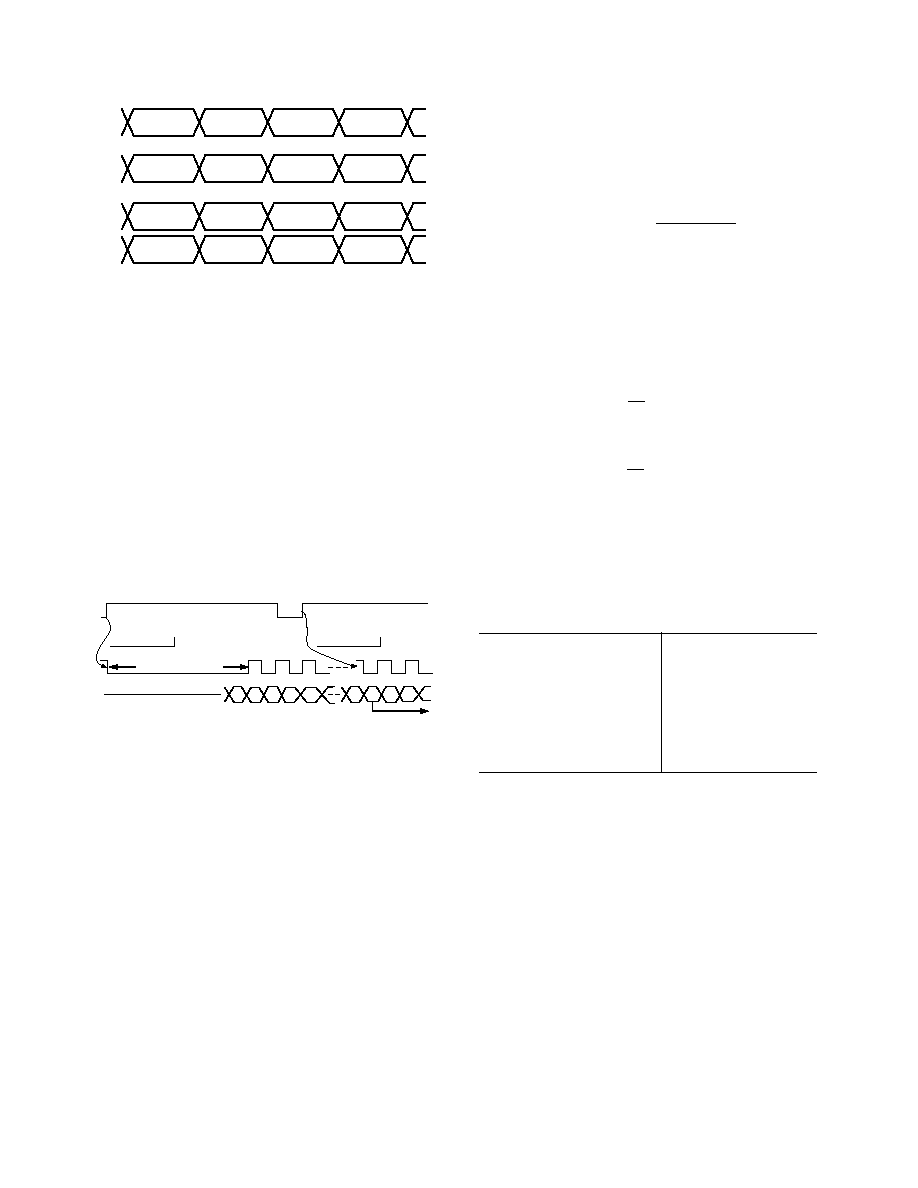
REV. 0
36
AD6634
LINK PORT
A OR B
AGC A I, Q
(4 BYTES)
AGC B I, Q
(4 BYTES)
AGC A I, Q
(4 BYTES)
AGC B I, Q
(4 BYTES)
ADDR 0x1B OR 0x1D BIT 0 = 1, BIT 1 = 0, BIT 2 = 0
LINK PORT
A OR B
AGC A I, Q
(4 BYTES)
AGC A RSSI
(4 BYTES)
AGC B I, Q
(4 BYTES)
AGC B RSSI
(4 BYTES)
ADDR 0x1B OR 0x1D BIT 0 = 1, BIT 1 = 0, BIT 2 = 1
LINK PORT A
AGC A I, Q
(4 BYTES)
AGC A RSSI
(4 BYTES)
AGC A I, Q
(4 BYTES)
AGC A RSSI
(4 BYTES)
AGC B I, Q
(4 BYTES)
AGC B RSSI
(4 BYTES)
AGC B I, Q
(4 BYTES)
AGC B RSSI
(4 BYTES)
LINK PORT B
ADDR 0x1B OR 0x1D BIT 0 = 1, BIT 1 = 1, BIT 2 = 0
Figure 42. Link Port Data from AGC
Note that Bit 0 = 1 Bit 1 = 0, and Bit 2 = 1 is not a valid
configuration. Bit 2 must be set to 0 to output AGC A IQ and
RSSI words on link port A, and AGC B IQ and RSSI words
on link port B.
Link Port Timing
Both link ports run off of PCLK, which can be externally provided
to the chip (Addr 0x1E Bit 0 = 0) or generated from the master
clock of the AD6634 (Addr 0x1E Bit 0 = 1). This register boots
to 0 (Slave mode) and allows the user to control the data rate
coming from the AD6634. PCLK can be run as fast as 100 MHz.
The link port provides a 1-byte data-word (LA[7:0], LB[7:0]
pins) and output clocks (LACLKOUT, LBCLKOUT pins) in
response to a ready signals (LACLKIN, LBCLKIN pins) from
the receiver. Each link port transmits eight bits on each edge of
LCLKOUT, requiring eight LCLKOUT cycles to complete
transmission of the full 16 bytes of a TigerSHARC quad-word.
D0 D1 D2 D3
D4
D15
D0 D1 D2
NEXT QUAD-WORD
TigerSHARC READY TO
RECEIVE QUAD-WORD
WAIT >= 6 CYCLES
TigerSHARC READY TO
RECEIVE NEXT QUAD-WORD
LCLKIN
LCLKOUT
LDAT[7:0]
Figure 43. Link Port Data Transfer
Due to the TigerSHARC link port protocol, the AD6634 must
wait at least six PCLK cycles after the TigerSHARC is ready to
receive data, as indicated by the TigerSHARC setting the respective
AD6634 LCLKIN pin high. Once the AD6634 link port has
waited the appropriate number of PCLK cycles and has begun
transmitting data, the TigerSHARC does a connectivity check
by sending the AD6634 LCLKIN low and then high while the
data is being transmitted. This tells the AD6634 link port that the
TigerSHARC's DMA is ready to receive the next quad-word after
completion of the current quad-word. Because the connectivity
check is done in parallel to the data transmission, the AD6634
is able to stream uninterrupted data to the TigerSHARC.
The length of the wait before data transmission is a 4-bit
programmable value in the link port control registers (0x1B and
0x1D Bits 63). This value allows the AD6634 PCLK and
the TigerSHARC PCLK to be run at different rates and
out of phase.
WAIT
ceil
f
f
LCLK
LCLK TSHARC
×
6
34
_
_
WAIT ensures that the amount of time the AD6634 needs to wait
to begin data transmission is at least equal to the minimum amount
of time the TigerSHARC is expecting it to wait. If the PCLK of
the AD6634 is out of phase with the PCLK of the TigerSHARC
and the argument to the ceil() function is an integer, WAIT must
be strictly greater than the value given in the above formula.
If the LCLKs are in phase, the maximum output data rate is:
f
f
LCLK
LCLK TSHARC
_
_
34
15
6
×
otherwise it is:
f
f
LCLK
LCLK TSHARC
_
_
34
14
6
×
TigerSHARC Configuration
Since the AD6634 is always the transmitter in this link and the
TigerSHARC is always the receiver, the values in Table IX can
be programmed into the LCTL register for the link port used to
receive AD6634 output data. User means that the actual register
value depends on the user's application.
Table IX. TigerSHARC LCTLx Register Configuration
VERE
0
SPD
User
LTEN
0
PSIZE
1
TTOE
0
CERE
0
LREN
1
RTOE
1
MEMORY MAPS
0x000x7F: Coefficient Memory(CMEM)
This is the Coefficient Memory(C-MEM) used by the RCF
(See Table X). It is memory mapped as 128 words by 20 bits.
A second 128 words of RAM may be accessed via this same
location by writing Bit 8 of the RCF control register high at
channel address 0xA4. The filter calculated will always use the
same coefficients for I and Q. By using memory from both of these
128 blocks, a filter up to 160 taps can be calculated. Multiple
filters can be loaded and selected with a single internal access
to the Coefficient Offset register at channel address 0xA3.
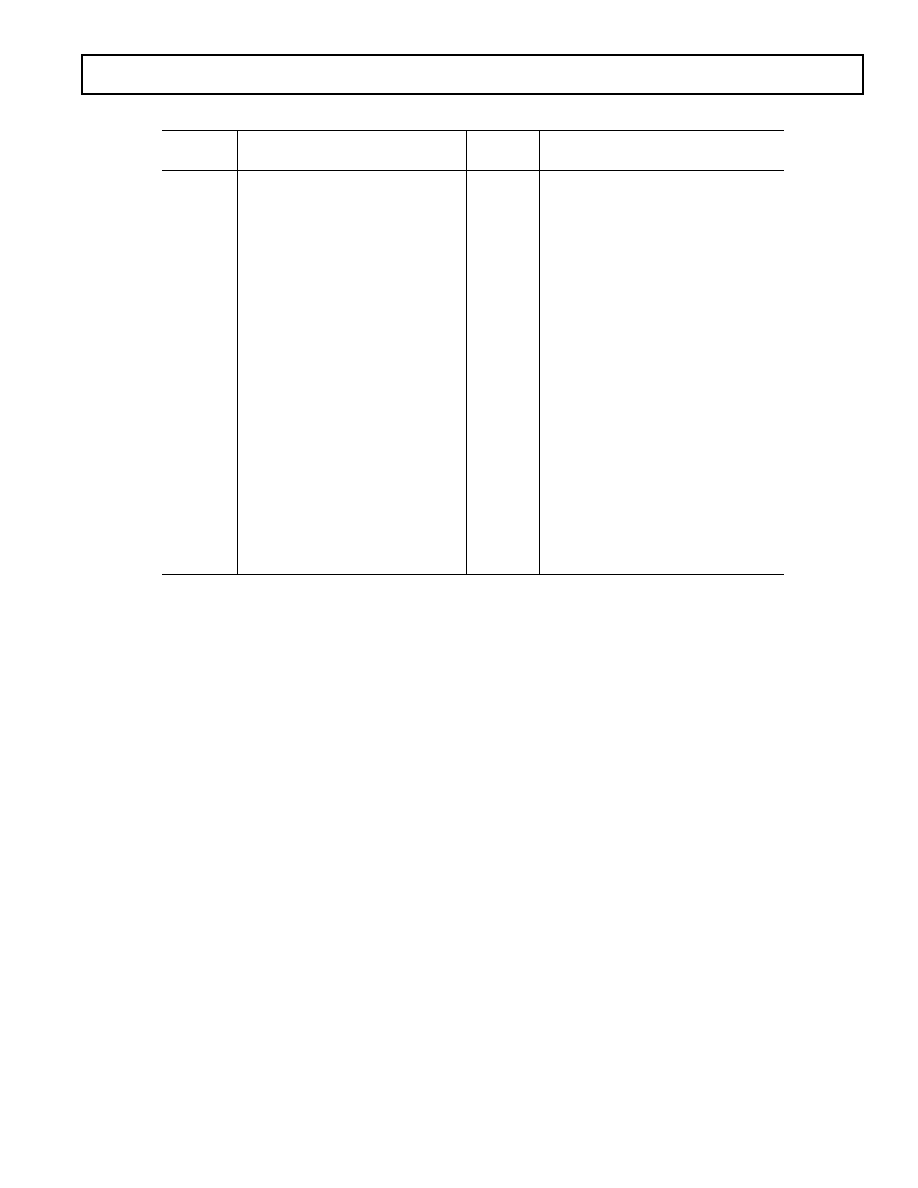
REV. 0
AD6634
37
0x80: Channel Sleep Register
This register contains the SLEEP bit for the channel. When this
bit is high, the channel is placed in a low power state. When this
bit is low, the channel processes data. This bit can also be set by
accessing the SLEEP register at external address 3. When the
External SLEEP register is accessed, all four channels are
accessed simultaneously and the SLEEP bits of the channels
are set appropriately.
0x81: Soft_SYNC Register
This register is used to initiate SYNC events through the
microport. If the Hop bit is written high, the Hop Hold-Off
Counter at address 0x84 is loaded and begins to count down.
When this value reaches 1, the NCO Frequency register used by
the NCO accumulator is loaded with the data from channel
addresses 0x85 and 0x86. When the Start bit is set high, the
Start Hold-Off Counter is loaded with the value at address
0x83 and begins to count down. When this value hits 1, the Sleep
bit in address 0x80 is dropped low and the channel is started.
0x82: Pin_SYNC Register
This register is used to control the functionality of the SYNC
pins. Any of the four SYNC pins can be chosen and monitored
by the channel. The channel can be configured to initiate either
a Start or Hop SYNC event by setting the Hop or Start bit high.
These bits function as enables so that when a SYNC pulse
occurs, either the Start or Hop Hold-Off Counters are activated
in the same manner as with a Soft_SYNC.
0x83: Start Hold-Off Counter
The Start Hold-Off Counter is loaded with the value written to
this address when a Start_Sync is initiated. It can be initiated
by either a Soft_SYNC or Pin_SYNC. The counter begins
decrementing and when it reaches a value of 1, the channel is
brought out of SLEEP and begins processing data. If the channel
is already running, the phase of the filters is adjusted such that
multiple AD6634s can be synchronized. A periodic pulse on the
SYNC pin can be used in this way to adjust the timing of the filters with
the resolution of the ADC sample clock. If this register is written
to a 1, the Start will occur immediately when the SYNC comes
into the channel. If it is written to a 0, no SYNC will occur.
0x84: NCO Frequency Hold-Off Counter
The NCO Frequency Hold-Off Counter is loaded with the value
written to this address when either a Soft_SYNC or Pin_SYNC
comes into the channel. The counter begins counting down so
that when it reaches 1, the NCO frequency word is updated
with the values of addresses 0x85 and 0x86. This is known as a
Hop or Hop_SYNC. If this register is written to a 1, the NCO
Frequency will be updated immediately when the SYNC
comes into the channel. If it is written to a 0, no HOP will
occur. NCO HOPs can be either phase continuous or nonphase
continuous, depending upon the state of Bit 3 of the NCO
control register at channel address 0x88. When this bit is low,
the phase accumulator of the NCO is not cleared but starts to
add the new NCO frequency word to the accumulator as soon as
the SYNC occurs. If this bit is high, the phase accumulator of
the NCO is cleared to 0 and the new word is then accumulated.
0x85: NCO Frequency Register 0
This register represents the 16 LSBs of the NCO Frequency
word. These bits are shadowed and are not updated to the regis-
ter used for the processing until the channel is either brought
out of SLEEP or a Soft_SYNC or Pin_SYNC has been issued.
In the latter two cases, the register is updated when the Frequency
Table X. Channel Address Memory Map
Channel
Bit
Address
Register
Width
Comments
007F
Coefficient Memory (CMEM)
20
128
× 20-Bit Memory
80
CHANNEL SLEEP
1
0: SLEEP Bit from EXT_ADDRESS 3
81
Soft_Sync Control Register
2
1: Hop
0: Start
82
Pin_SYNC Control Register
3
2: First SYNC Only
1: Hop_En
0: Start_En
83
Start Hold-Off Counter
16
Start Hold-Off Value
84
NCO Frequency Hold-Off Counter
16
NCO_FREQ Hold-Off Value
85
NCO Frequency Register 0
16
NCO_FREQ[15:0]
86
NCO Frequency Register 1
16
NCO_FREQ[31:16]
87
NCO Phase Offset Register
16
NCO_PHASE[15:0]
88
NCO Control Register
9
87: SYNC Input Select[1:0]
6: WB Input Select B/A
54: Input Enable Control
11: Clock on IEN Transition to Low
10: Clock on IENTransition to High
01: Clock on IEN High
00: Mask on IEN Low
3: Clear Phase Accumulator on HOP
2: Amplitude Dither
1: Phase Dither
0: Bypass (A-Input
I-Path, B Q)
898F
Unused

REV. 0
38
AD6634
Hold-Off Counter hits a value of 1. If the Frequency Hold-Off
Counter is set to 1, the register will be updated as soon as the
shadow is written.
0x86: NCO Frequency Register 1
This register represents the 16 MSBs of the NCO Frequency
word. These bits are shadowed and are not updated to the regis-
ter used for the processing until the channel is either brought
out of SLEEP or a Soft_SYNC or Pin_SYNC has been issued.
In the latter two cases the register is updated only when the
Frequency Hold-Off Counter hits a value of 1. If the Frequency
Hold-Off Counter is set to 1, the register will be updated as
soon as the shadow is written.
0x87: NCO Phase Offset Register
This register represents a 16-bit phase offset to the NCO. It can
be interpreted as values ranging from 0 to just under 2 .
0x88: NCO Control Register
This 9-bit register controls features of the NCO and the channel.
The bits are defined below. For more details, the NCO section
should be consulted.
Bits 87 of this register choose which of the four SYNC pins are
used by the channel. The SYNC pin selected can be used to
initiate a START, HOP, or timing adjustment to the channel.
The Synchronization section provides more details on this.
Bit 6 of this register defines whether the A or B input port is
used by the channel. If this bit is low, the A Input Port is
selected; and if this bit is high, the B Input Port is selected.
Each input port consists of a 14-bit input mantissa(INx[13:0]),
a 3-bit exponent(EXPx[2:0]), and an input enable pin IENx.
The x represents either A or B.
Bits 54 determine how the sample clock for the channel is
derived from the high speed CLK signal. There are four pos-
sible choices. Each is defined below but for further details, the
NCO section of the data sheet should be consulted.
When these bits are 00, the input sample rate (f
SAMP
) of the
channel is equal to the rate of the high speed CLK signal. When
IEN is low, the data going into the channel is masked to 0. This
is an appropriate mode for TDD systems where the receiver
may wish to mask off the transmitted data yet still remain in the
proper phase for the next receive burst.
When these bits are 01, the input sample rate is determined by
the fraction of the rising edges of CLK on which the IEN input
is high. For example, if IEN toggles on every rising edge of
CLK, the IEN signal will only be sampled high on one out of
every two rising edges of CLK, which means that the input
sample rate f
SAMP
will be one-half the CLK rate.
When these bits are 10, the input sample rate is determined by
the rate at which the IEN pin toggles. The data that is captured
on the rising edge of CLK after IEN transitions from low to
high is processed. When these bits are 11, the accumulator and
sample CLK are determined by the rate at which the IEN pin
toggles. The data that is captured on the rising edge of CLK
after IEN transitions from high to low is processed. For example,
control modes 10 and 11 can be used to allow interleaved data
from either the A or B input ports and then assigned to the
respective channel. The IEN pin selects the data such that a
channel could be configured in mode 10 and another could be
configured in mode 11.
Bit 3 determines whether or not the phase accumulator of the
NCO is cleared when a Hop occurs. The Hop can originate
from either the Pin_SYNC or Soft_SYNC. When this bit is set
to 0, the Hop is phase continuous and the accumulator is not
cleared. When this bit is set to 1, the accumulator is cleared to 0
before it begins accumulating the new frequency word. This is
appropriate when multiple channels are hopping from different
frequencies to a common frequency.
Bits 21 control whether or not the dithers of the NCO are
activated. The use of these features is heavily determined by the
system constraints. Consult the NCO section of the data sheet
for more detailed information on the use of dither.
Bit 0 of this register allows the NCO Frequency translation stage
to be bypassed. When this occurs the data from the A Input Port is
passed down the I path of the channel and the data from the B
Input Port is passed down the Q path of the channel. This
allows a real filter to be performed on baseband I and Q data.
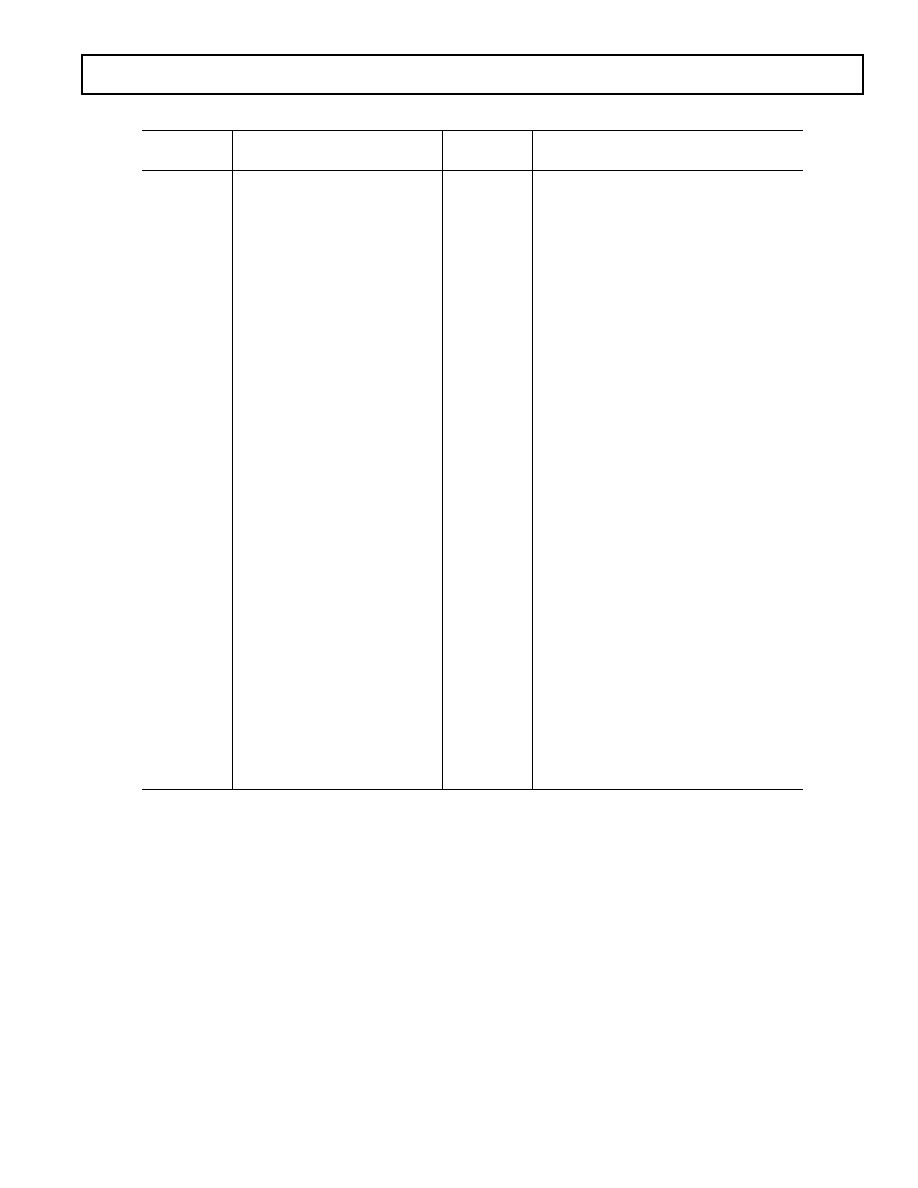
REV. 0
AD6634
39
0x90: rCIC2 Decimation 1 (M
rCIC2
1)
This register is used to set the decimation in the rCIC2 filter.
The value written to this register is the decimation minus one.
The rCIC2 decimation can range from 1 to 4096, depending
upon the interpolation of the channel. The decimation must
always be greater than the interpolation. M
rCIC2
must be chosen
larger than L
rCIC2
and both must be chosen such that a suitable
rCIC2 scalar can be chosen. For more details, the rCIC2 section
should be consulted.
0x91: rCIC2 Interpolation 1 (L
rCIC2
1)
This register is used to set the interpolation in the rCIC2 filter.
The value written to this register is the interpolation minus one.
The rCIC2 interpolation can range from 1 to 512, depending
upon the decimation of the rCIC2. There is no timing error
associated with this interpolation. See the rCIC2 section for
further details.
0x92: rCIC2 Scale
The rCIC2 scale register is used to provide attenuation to com-
pensate for the gain of the rCIC2 and to adjust the linearization
of the data from the floating-point input. The use of this scale
register is influenced both by the rCIC2 growth and floating-
point input port considerations. The rCIC2 section should be
consulted for details. The rCIC2 scalar has been combined with
the exponent offset and will need to be handled appropriately in
both the input port and rCIC2 sections.
Bit 11 determines the polarity of the exponent. Normally, this
bit will be cleared unless an ADC such as the AD6600 is used,
in which case this bit will be set.
Bit 10 determines the weight of the exponent word associated
with the input port. When this bit is Low, each exponent step is
considered to be worth 6.02 dB. When this bit is High, each
exponent step is considered to be worth 12.02 dB.
Table XI. Channel Address Memory Map
Channel
Bit
Address
Register
Width
Comments
90
rCIC2 Decimation 1
12
M
rCIC2
1
91
rCIC2 Decimation 1
9
L
rCIC2
1
92
rCIC2 Scale
12
11: Exponent Invert
10: Exponent Weight
95: rCIC2_QUIET[4:0]
40: rCIC2_LOUD[4:0]
93
Reserved
8
Reserved (Must Be Written Low)
94
CIC5 Decimation 1
8
M
CIC5
1
95
CIC5 Scale
5
40: CIC5_SCALE[4:0]
96
Reserved
8
Reserved (Must Be Written Low)
979F
Unused
A0
RCF Decimation 1
8
M
RCF
1
A1
RCF Decimation Phase
8
P
RCF
A2
RCF Number of Taps 1
8
N
TAPS
1
A3
RCF Coefficient Offset
8
CO
RCF
A4
RCF Control Register
11
10: RCF Bypass BIST
9: RCF Input Select
(Own 0, Other 1)
8: Program RAM Bank 1/0
7: Use Common Exponent
6: Force Output Scale
54: Output Format
1x: Floating Point 12 + 4
01: Floating Point 8 + 4
00: Fixed Point
30:1Output Scale
A5
BIST Signature for I Path
16
BIST-I
A6
BIST Signature for Q Path
16
BIST-Q
A7
No. of BIST Outputs to
Accumulate
20
190: No. of Outputs(Counter Value Read)
A8
RAM BIST Control Register
3
2: D-RAM Fail/Pass
1: NC-RAM Fail/Pass
0: RAM BIST Enable
A9
Output Control Register
9: Map RCF Data to BIST Registers
5: Output Format
1:16-Bit I and 16-Bit Q
0:12-Bit I and 12-Bit Q
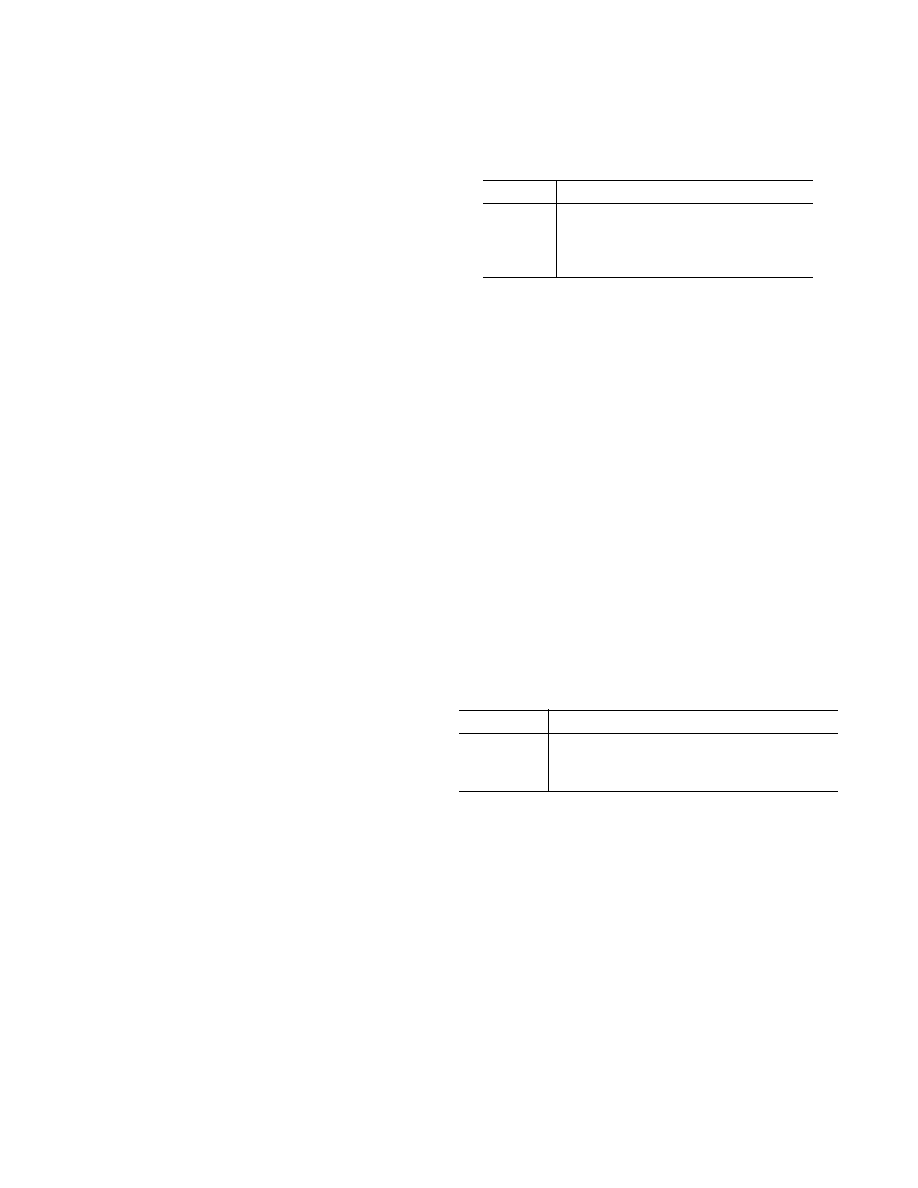
REV. 0
40
AD6634
Bits 95 are the actual scale value used when the Level Indicator,
LI pin associated with this channel is active.
Bits 40 are the actual scale value used when the Level Indicator,
LI pin associated with this channel is active.
0x93:
Reserved (must be written Low).
0x94: CIC5 Decimation 1 (M
CIC5
1)
This register is used to set the decimation in the CIC5 filter.
The value written to this register is the decimation minus one.
Although this is an 8-bit register, the decimation is usually lim-
ited to between 1 and 32. Decimations higher than 32 would
require more scaling than the CIC5 is capable of.
0x95: CIC5 Scale
The CIC5 scale factor is used to compensate for the growth of
the CIC5 filter. Consult the CIC5 section for details.
0x96:
Reserved (must be written low).
0xA0: RCF Decimation 1 (M
RCF
1)
This register is used to set the decimation of the RCF stage. The
value written is the decimation minus one. Although this is an
8-bit register that allows decimation up to 256, for most filtering
scenarios the decimation should be limited between 1 and 32.
Higher decimations are allowed but the alias protection of the
RCF may not be acceptable for some applications.
0xA1: RCF Decimation Phase (P
RCF
)
This register allows any one of the M
RCF
phases of the filter to
be used and can be adjusted dynamically. This phase is updated
each time a filter is started. When a channel is synchronized, it
will retain the phase setting chosen here. This can be used as
part of a timing recovery loop with an external processor or can
allow multiple RCFs to work together while using a single RCF
pair. The RCF section should be consulted for further details.
0xA2: RCF Number of Taps 1 (N
TAPS
1)
The number of taps for the RCF filter minus one is written here.
0xA3: RCF Coefficient Offset (CO
RCF
)
This register is used to specify which section of the 256-word
coefficient memory is used for a filter. It can be used to select
between multiple filters that are loaded into memory and refer-
enced by this pointer. This register is shadowed and the filter
pointer is updated every time a new filter is started. This allows
the coefficient offset to be written even while a filter is being
computed with disturbing operation. The next sample that
comes out of the RCF will be with the new filter.
0xA4: RCF Control Register
The RCF control register is an 11-bit register that controls the
general features of the RCF as well as the output formatting.
The bits of this register and their functions are described below.
Bit 10 bypasses the RCF filter and sends the CIC5 output data
to the BIST-I and BIST-Q registers. The 16 MSBs of the CIC5
data can be accessed from this register if Bit 9 of the RCF Control
Register 2 at Channel Address 0xA9 is set.
Bit 9 of this register controls the source of the input data to the
RCF. If this bit is 0, the RCF processes the output data of its
own channel. If this bit is 1, it processes the data from the CIC5
of another channel. The CIC5 that the RCF is connected to
when this bit is 1 is shown in the Table XII. These can be
used to allow multiple RCFs to be used together to process
wider bandwidth channels. See the Multiprocessing section for
further details.
Table XII. RCF Input Configurations
Channel
RCF Input Source When Bit 9 is 1
0
1
1
0
2
1
3
1
Bit 8 is used as an extra address to allow a second block of 128
words of CMEM to be addressed by the channel addresses at
0x000x7F. If this bit is 0, the first 128 words are written; and if
this bit is 1, a second 128 words is written. This bit is only used
to program the coefficient memory. It is not used in any way by
the processing and filters longer than 128 taps can be performed.
Bit 7 is used to help control the output formatting of the AD6634s
RCF data. This bit is only used when the 8 + 4 or 12 + 4 floating-
point modes are chosen. These modes are enabled by Bits 5 and
4 of this register below. When this bit is 0, the I and Q output
exponents are determined separately based on their individual
magnitudes. When this bit is 1, the I and Q data is a complex
floating-point number where I and Q use a single exponent
that is determined based on the maximum magnitude of I or Q.
Bit 6 is used to force the Output Scale Factor in Bits 30 of this
register to be used to scale the data even when one of the floating-
point output modes is used. If the number was too large to
represent with the output scale chosen, the mantissas of the
I and Q data clip and do not overflow.
Bits 5 and 4 choose the output formatting option used by the
RCF data. The options are defined in the Table XIII and are
discussed further in the Output Format section.
Table XIII. Output Formats
Bit Values
Output Option
1x
12-Bit Mantissa and 4-Bit Exponent (12 + 4)
01
8-Bit Mantissa and 4-Bit Exponent (8 + 4)
00
Fixed-Point Mode
Bits 30 of this register represent the Output Scale Factor of the
RCF. It is used to scale the data when the output format is in
fixed-point mode or when the Force Exponent bit is high.
0xA5: BIST Register for I
This register serves two purposes. The first is to allow the complete
functionality of the I data path in the channel to be tested in the
system. The BIST section of the data sheet should be consulted
for further details. The second function is to provide access to the
I output data through the microport. To accomplish this, the
Map RCF data to BIST bit in the RCF Control register 2, 0xA9,
should be set high. Sixteen bits of I data can then be read through
the microport in either the 8 + 4, 12 + 4, 12-bit linear, or 16-bit
linear output modes. This data may come from either the formatted
RCF output or the CIC5 output.
0xA6: BIST Register for Q
This register serves two purposes. The first is to allow the complete
functionality of Q data path in the channel to be tested in the
system. The BIST section of the data sheet should be consulted
for further details. The second function is to provide access to
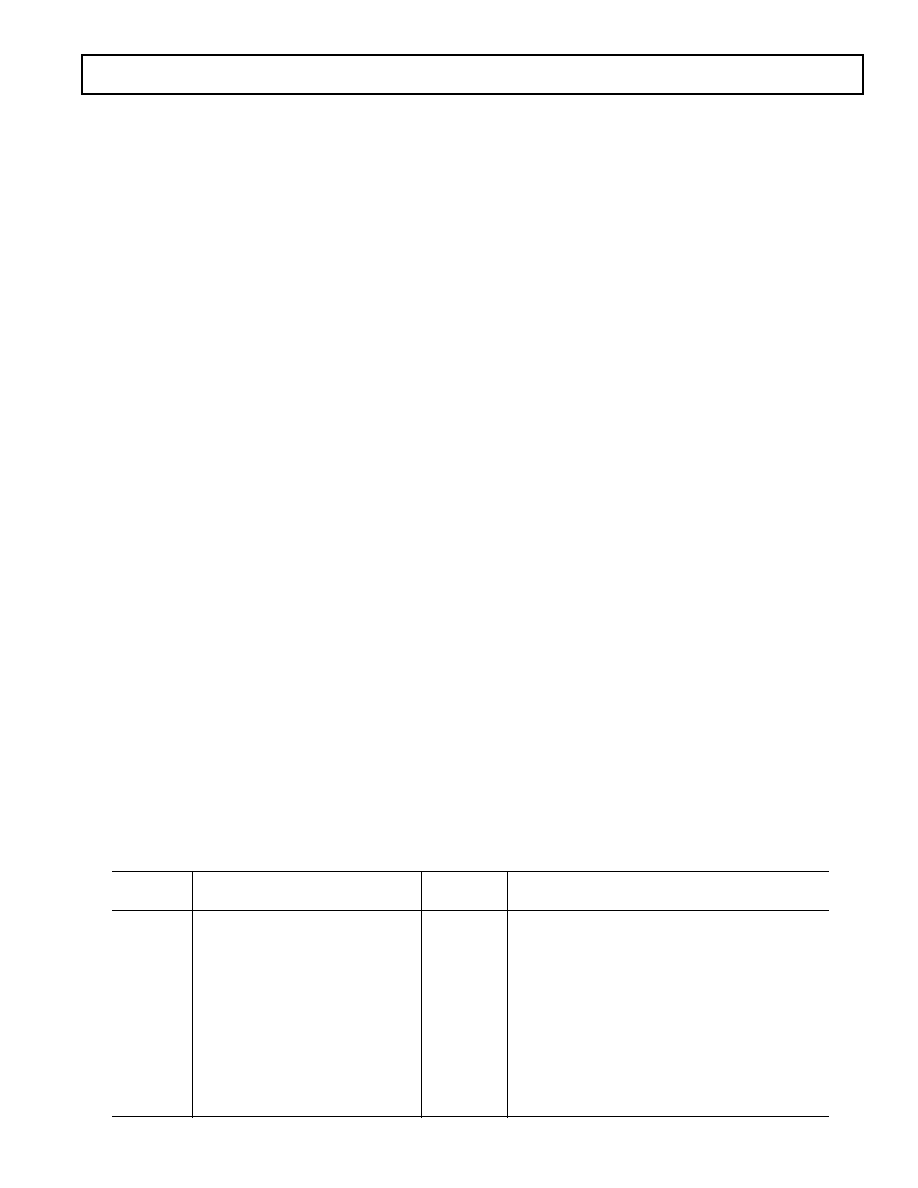
REV. 0
AD6634
41
the Q output data through the microport. To accomplish this,
the Map RCF data to BIST bit in the RCF Control register 2,
0xA9, should be set high. Sixteen bits of Q data can then be read
through the microport in either the 8 + 4, 12 + 4, 12-bit linear,
or 16-bit linear output modes. This data may come from either
the formatted RCF output or the CIC5 output.
0xA7: BIST Control Register
This register controls the number of outputs of the RCF or CIC
filter that are observed when a BIST test is performed. The BIST
signature registers at addresses 0xA5 and 0xA6 will observe this
number of outputs and then terminate. The loading of this
register also starts the BIST engine running. Details of how to
utilize the BIST circuitry are defined in the BIST section.
0xA8: RAM BIST Control Register
This register is used to test the memories of the AD6634 should
they ever be suspected of a failure. Bit 0 of this register is written
with a 1 when the channel is in SLEEP and the user waits for
1600 CLKs and then polls the bits. If Bit 1 is high, the CMEM
failed the test; and if Bit 2 is high, the data memory used by the
RCF failed the test.
0xA9: Output Control Register
Bit 9 of this register allows the RCF or CIC5 data to be mapped
to the BIST registers at addresses 0xA5 and 0xA6. When this bit
is 0, the BIST register is in signature mode and ready for a self-test
to be run. When this bit is 1, the output data from the RCF after
formatting or the CIC5 data is mapped to these registers and
can be read through the microport.
Bits 5 determines the word length used by the parallel port. If this
bit is 0, the parallel port uses 12-bit words for I and Q. If this
bit is 1, the parallel port uses 16-bit words for I and Q. When the
fixed-point output option is chosen from the RCF control
register, these bits also set the rounding correctly in the output
formatter of the RCF.
Remaining bits in this register are reserved and should be written
low when programming.
In order to access the Input/Output Port Registers, Bit 5 of
SLEEP
register (on external memory map) should be written high. The CAR
is then written with the address to the correct Input Port Register.
Input Port Control Registers
The Input Port control register enables various input related
features used primarily for input detection and level control.
Depending on the mode of operation, up to four different signal
paths can be monitored with these registers. These features are
accessed by setting Bit 5 of external address 3 (Sleep Register)
and then using the CAR (external address 6) to address the
eight locations available.
Response to these settings is directed to the LIA-A, LIA-B,
LIB-A, and LIB-B Pins.
0x00 Lower Threshold A
This word is 10 bits wide and maps to the 10 most significant
bits of the mantissa. If the upper 10 bits of input port A are less
than or equal to this value, the lower threshold has been met. In
normal chip operation, this starts the dwell time counter. If the
input signal increases above this value, the counter is reloaded
and awaits the input to drop back to this level.
0x01 Upper Threshold A
This word is 10 bits wide and maps to the 10 most significant
bits of the mantissa. If the upper 10 bits of input port A are
greater than or equal to this value, the upper threshold has been
met. In normal chip operation, this will cause the appropriate LI
pin (LIA-A or LIA-B) to become active.
0x02 Dwell Time A
This sets the time that the input signal must be at or below the
lower threshold before the LI pin is deactivated. For the input
level detector to work, the dwell time must be set to at least 1.
If set to 0, the LI functions are disabled.
This is a 20-bit register. When the lower threshold is met following
an excursion into the upper threshold, the dwell time counter is
loaded and begins to count high speed clock cycles as long as
the input is at or below the lower threshold. If the signal increases
above the lower threshold, the counter is reloaded and waits for
the signal to fall below the lower threshold again.
0x03 Gain Range A Control Register
Bit 4 determines the polarity of LIA-A and LIA-B. If this bit is
clear, the LI signal is high when the upper threshold has been
exceeded. However, if this bit is set, the LI pin is low when active.
This allows maximum flexibility when using this function.
Bit 3 determines if the input consists of a single channel or
TDM channels such as when using the AD6600. If this bit is
cleared, a single ADC is assumed. In this mode, LIA-A functions
as the active output indicator. LIA-B provides the complement
of LIA-A. However, if this bit is set, the input is determined to
Table XIV. Memory Map for Input Port Control Registers
Channel
Bit
Address
Register
Width
Comments
00
Lower Threshold A
10
90:
Lower Threshold for Input A
01
Upper Threshold A
10
90:
Upper Threshold for Input A
02
Dwell Time A
20
190: Minimum Time Below Lower Threshold A
03
Gain Range A Control Register
5
4:
Output Polarity LIA-A and LIA-B
3:
Interleaved Channels
20:
Linearization Hold-Off Register
04
Lower Threshold B
10
90:
Lower Threshold for Input B
05
Upper Threshold B
10
90:
Upper Threshold for Input B
06
Dwell Time B
20
190: Minimum Time Below Lower Threshold B
07
Gain Range B Control Register
5
4:
Output Polarity LIB-A and LIB-B
3:
Interleaved Channels
20:
Linearization Hold-Off Register

REV. 0
42
AD6634
be dual-channel and determined by the state of the IENA pin. If the
IENA pin is low, the input detection is directed to LIA-A. If the
IENA pin is high, the input is directed to LIA-B. In either case,
Bit 4 determines the actual polarity of these signals.
Bits 20 determine the internal latency of the gain detect function.
When the LIA-A,B pins are made active, they are typically used
to change an attenuator or gain stage. Since this is prior to the
ADC, there is a latency associated with the ADC and with the
settling of the gain change. This register allows the internal delay
of the LIA-A,B signal to be programmed.
0x04 Lower Threshold B
This word is 10 bits wide and maps to the 10 most significant
bits of the mantissa. If the upper 10 bits of input port B are less
than or equal to this value, the lower threshold has been met. In
normal chip operation, this starts the dwell time counter. If the
input signal increases above this value, the counter is reloaded
and awaits the input to drop back to this level.
0x05 Upper Threshold B
This word is 10 bits wide and maps to the 10 most significant
bits of the mantissa. If the upper 10 bits of input port B are greater
than or equal to this value, the upper threshold has been met.
In normal chip operation, this will cause the appropriate LI pin
(LIB-A or LIB-B) to become active.
0x06 Dwell Time B
This sets the time that the input signal must be at or below the
lower threshold before the LI pin is deactivated. For the input
level detector to work, the dwell time must be set to at least 1.
If set to 0, the LI functions are disabled.
This is a 20-bit register. When the lower threshold is met following
an excursion into the upper threshold, the dwell time counter is
loaded and begins to count high speed clock cycles as long as the
input is at or below the lower threshold. If the signal increases above
the lower threshold, the counter is reloaded and waits for the signal
to fall below the lower threshold again.
0x07 Gain Range B Control Register
Bit 4 determines the polarity of LIB-A and LIB-B. If this bit is
clear then the LI signal is high when the upper threshold has
been exceeded. However, if this bit is set, the LI pin is low when
active. This allows maximum flexibility when using this function.
Bit 3 determines if the input consists of a single channel or TDM
channels such as when using the AD6600. If this bit is cleared,
a single ADC is assumed. In this mode, LIB-A functions as the
active output indicator. LIB-B provides the complement of LIB-A.
However if this bit is set, the input is determined to be dual
channel and determined by the state of the IENB pin. If the
IENB pin is low, the input detection is directed to LIB-A. If the
IENB pin is high, the input is directed to LIB-B. In either case,
Bit 4 determines the actual polarity of these signals.
Bits 20 determine the internal latency of the gain detect function.
When the LIB-A,B pins are made active, they are typically used
to change an attenuator or gain stage. Since this is prior to the
ADC, there is a latency associated with the ADC and with the
settling of the gain change. This register allows the internal delay
of the LIB-A,B signal to be programmed.
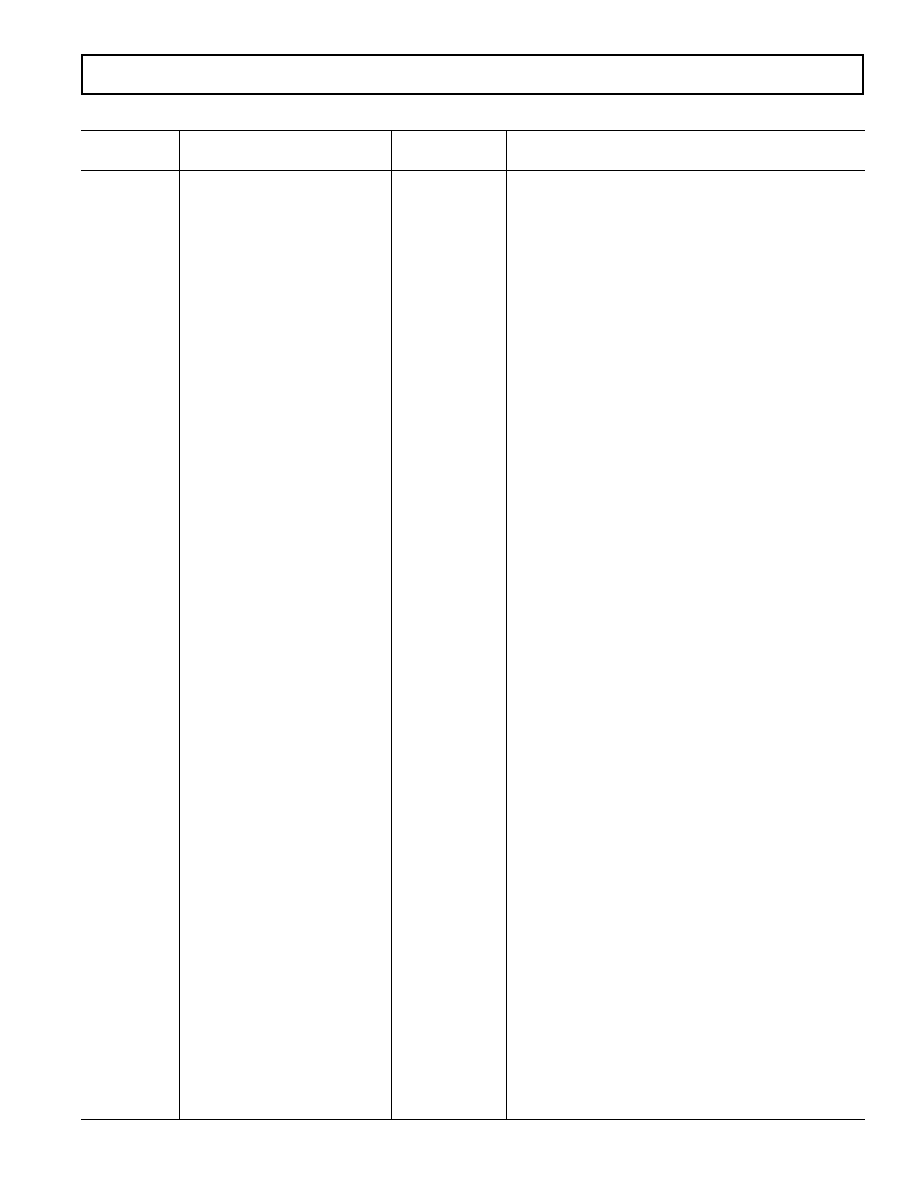
REV. 0
AD6634
43
Table XV. Memory Map for Output Port Control Registers
Channel
Bit
Address
Register
Width
Comments
08
Port A Control Register
4
3:
Port A Enable
21:
HB A Signal Interleaving
11
All 4 Channels
10
Chs 0, 1, 2
01
Chs 0,1
00
Ch 0
0:
Bypass
09
Port B Control Register
3
2:
Port B Enable
1:
HB A Signal Interleaving
1
Chs 2, 3
0
Ch 2
0:
Bypass
0A
AGC A Control Register
8
75:
Output Word Length
111
4 Bits
110
5 Bits
101
6 Bits
100
7 Bits
011
8 Bits
010
10 Bits
001
12 Bits
000
16 Bits
4:
Clipping Error
1:
Maintain Level of Clipping Error
0:
Maintain Output Signal Level
3:
Sync Now
2:
Init on Sync
1:
First Sync Only
0:
Bypass
0B
AGC A Hold-Off Counter
16
150: Hold Off Value
0C
AGC A Desired Level
8
70:
Desired Output Power Level or Clipping Energy
(R Parameter)
0D
AGC A Signal Gain
12
110: G
S
Parameter
0E
AGC A Loop Gain
8
70:
K Parameter
0F
AGC A Pole Location
8
70:
P Parameter
10
AGC A Average Samples
6
52:
Scale for CIC Decimator
1-0:
Number of Averaging Samples
11
AGC A Update Decimation
12
110: CIC Decimation Ratio
12
AGC B Control Register
8
75:
Output Word Length
112
4 Bits
110
5 Bits
102
6 Bits
101
7 Bits
011
8 Bits
010
10 Bits
001
12 Bits
000
16 Bits
4:
Clipping Error
1:
Maintain Level of Clipping Error
0:
Maintain Output Signal Level
3:
Sync Now
2:
Init on Sync
1:
First Sync Only
0:
Bypass
13
AGC B Hold-Off Counter
16
150: Hold Off Value
14
AGC B Desired Level
8
70:
Desired Output Power Level or Clipping Energy
(R Parameter)
15
AGC B Signal Gain
12
110: G
S
Parameter
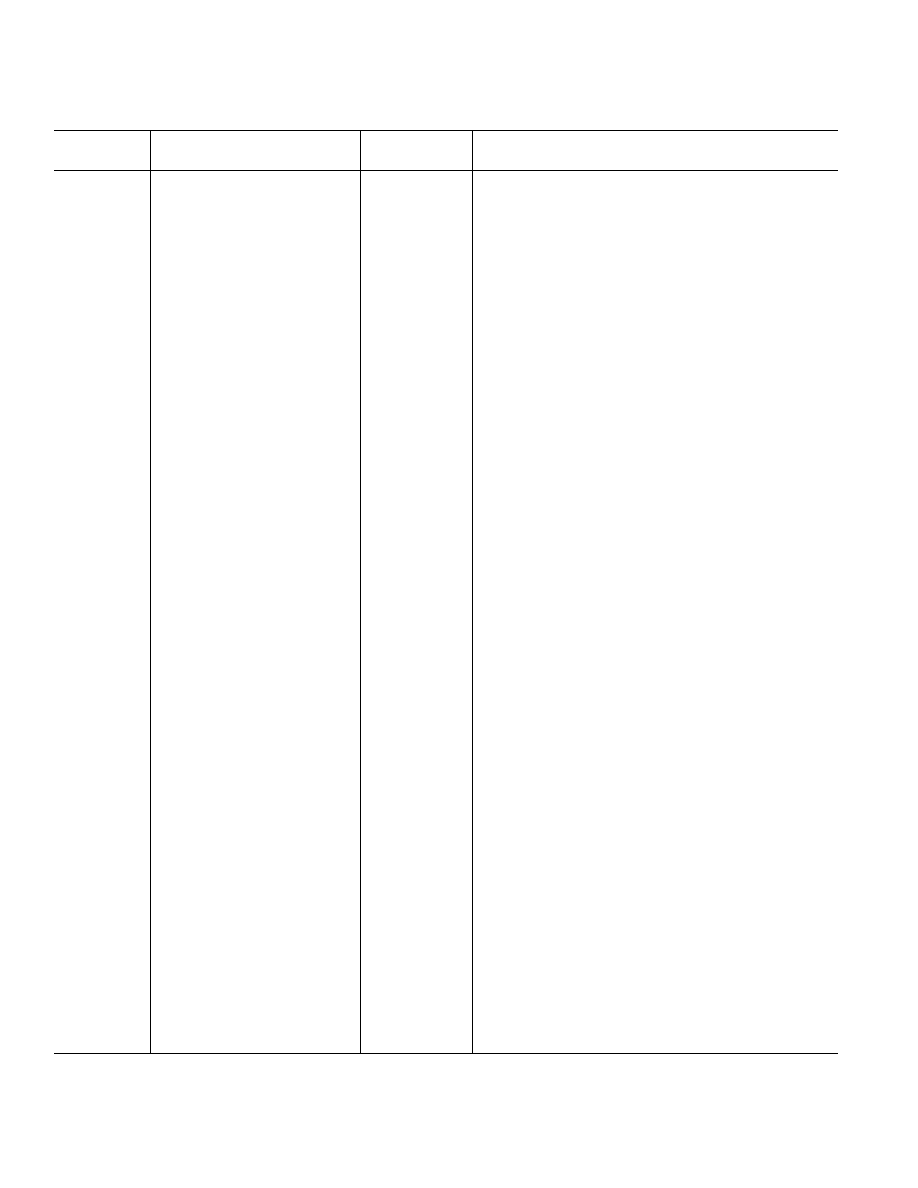
REV. 0
44
AD6634
Table XV. Memory Map for Output Port Control Registers (continued)
Channel
Bit
Address
Register
Width
Comments
16
AGC B Loop Gain
8
70:
K Parameter
17
AGC B Pole Location
8
70:
P Parameter
18
AGC B Average Samples
6
52:
Scale for CIC Decimator
10:
Number of Averaging Samples
19
AGC B Update Decimation
12
110: CIC Decimation
1A
Parallel A Control
8
76:
Reserved
5:
Parallel Port Data Format
1:
8-Bit Parallel I, Q
0:
16-Bit Interleaved I, Q
4:
Channel 3
3:
Channel 2
2:
Channel 1/AGC B Enable
1:
Channel 0/AGC A Enable
0:
AGC_CH Select
1:
Data Comes from AGCs
0:
Data Comes from Channels
1B
Link A Control
8
7:
Link Port A Enable
63:
Wait
2:
No RSSI Word
1:
Don't Output RSSI Word
0:
Output RSSI Word
1:
Channel Data Interleaved
1:
2-Channel Mode/Separate AB
0:
4-Channel Mode/AB Same Port
0:
AGC_CH Select
1:
Data Comes from AGCs
0:
Data Comes from Channels
1C
Parallel B Control
8
76: Reserved
5:
Parallel Port Data Format
1:
8-Bit Parallel I, Q
0:
16-Bit Interleaved I, Q
4:
Channel 3
3:
Channel 2
2:
Channel 1/AGC B Enable
1:
Channel 0/AGC A Enable
0:
AGC_CH Select
1:
Data Comes from AGCs
0:
Data Comes from Channels
1D
Link B Control
8
7:
Link Port B Enable
63:
Wait
2:
No RSSI Word
1:
Don't Output RSSI Word
0:
Output RSSI Word
1:
Channel Data Interleaved
1:
2-Channel Mode/Separate AB
0:
4-Channel Mode/AB Same Port
0:
AGC_CH Select
1:
Data Comes from AGCs
0:
Data Comes from Channels
1E
Port Clock Control
3
21:
PCLK Divisor
0:
PCLK Master/Slave
*
0:
Slave
1:
Master
*PCLK boots as slave.

REV. 0
AD6634
45
In order to access the Input/Output Port Registers, Bit 5 of
SLEEP register (on external memory map) should be written
high. The CAR is then written with the address to the correct
Output Port Register.
0x08 Port A Control Register
Bit 0 enables the use of interpolating half-band filter corresponding
to Port A. Half-band A can be used to interleave the data streams
of multiple channels and interpolate by two providing a maximum
output data rate of 4 the chip rate. It can be configured to
listen to all four channels; channels 0, 1, 2, 3; channels 0, 1, 2;
channels 0, 1; or only channel 0. Half-band A is bypassed when bit
0 = 1, in which case the outputs of the RCFs are directly sent to
the AGC. The channel data streams are still interleaved with the
half-band bypassed, but they are not filtered and interpolated. The
maximum data rate from this configuration would be 2 the
chip rate.
0x09 Port B Control Register
Bit 0 enables the use of interpolating half-band filter corresponding
to Port B. Half-band B can be used to interleave the data streams
of multiple channels and interpolate by 2 providing a maximum
output data rate of 4 the chip rate. It can be configured to
listen to channels 2 and 3; or only channel two. Half-band B is
bypassed when bit 0 = 1, in which case the outputs of the RCFs
are directly sent to the AGC. The channel data streams are still
interleaved with the half-band bypassed, but they are not filtered
and interpolated. The maximum data rate from this configura-
tion would be 2 the chip rate.
0x0A AGC A Control Register
This 8-bit register controls features of the AGC A. The bits are
defined below:
Bits 75 define the output word length of the AGC. The output
word can be 48, 10, 12, or 16 bits wide. The control register
bit representation to obtain different output word lengths is
given in the Memory Map Table.
Bit 4 of this register sets the mode of operation for the AGC.
When this bit is 0, the AGC tracks to maintain the output signal
level and when this bit is 1, the AGC tracks to maintain a con-
stant clipping error. Consult the AGC section for more details
about these modes.
Bits 31 are used to configure the synchronization of the AGC.
The CIC decimator filter in the AGC can be synchronized to an
external sync signal to output an update sample for the AGC error
calculation and filtering. This way the AGC gain changes can be
synchronized to an external block like a Rake receiver. Whenever
an external sync signal is received, the hold-off counter at 0x0B
is loaded and begins to count down. When the counter reaches
one, the CIC filter dumps an update sample and starts working
towards a new update sample. The AGC can be initialized on
each SYNC or only on the first SYNC.
Bit 3 is used to issue a command to the AGC to SYNC immedi-
ately. If this bit is set, the CIC filter will update the AGC with a
new sample immediately and start operating towards the next
update sample. The AGC can be synchronized by the microport
control interface using this method.
Bit 2 is used to determine whether the AGC should initialize on
a SYNC or not. When this bit is set, the CIC filter is cleared and
new values for CIC decimation, number of averaging samples,
CIC scale, Signal gain G
S
, gain K, and pole parameter P are
loaded. When Bit 2 = 0, the above-mentioned parameters are
not updated and the CIC filter is not cleared. In both cases, an
AGC update sample is output from the CIC filter and the
decimator starts operating towards the next output sample
whenever a SYNC occurs.
Bit 1 is used to ignore repetitive synchronization signals. In
some applications, the synchronization signal may occur peri-
odically. If this bit is clear, each synchronization request will
resynchronize the AGC. If this bit is set, only the first occur-
rence will cause the AGC to synchronize and will update AGC
gain values periodically depending on the decimation factor of
the AGC CIC filter.
Bit 0 is used to bypass the AGC section, when it is set. The
23-bit representation from interpolating half-band filters is still
reduced to a lower bit width representation as set by Bits 75 of
the AGC A Control Register. A truncation at the output of the
AGC accomplishes this task.
0x0B AGC A Hold-Off Counter
The AGC A Hold-Off counter is loaded with the value written
to this address when either a Soft_SYNC or Pin_SYNC comes
into the channel. The counter begins counting down so when it
reaches one, a SYNC is given to AGC A. This SYNC may or
may not initialize the AGC, as defined by the control word. The
AGC loop is updated with a new sample from the CIC filter
whenever a SYNC occurs. If this register is written to 1, the
AGC will be updated immediately when the SYNC occurs. If
this register is written to a 0, the AGC cannot be synchronized.
0x0C AGC A Desired Level
This 8-bit register contains the desired output power level or
desired clipping level depending on the mode of operation. This
desired Request R level can be set in dB from 0 to 23.99 in
steps of 0.094 dB. 8-bit binary floating-point representation is
used with 2-bit exponent followed by 6-bit mantissa. Mantissa is
in steps of 0.094 dB and exponent in 6.02 dB steps. For example,
10'100101 represents 2
6.02 + 37 0.094 = 15.518 dB.
0x0D AGC A Signal Gain
This register is used to set the initial value for a signal gain used in
the gain multiplier. This 12-bit value sets the initial signal gain
between 0 and 96.296 dB in steps of 0.024 dB. 12-bit binary
floating-point representation is used with 4-bit exponent fol-
lowed by 8-bit mantissa. For example, 0111'10001001 is
equivalent to 7
6.02 + 137 0.024 = 45.428 dB.
0x0E AGC A Loop Gain
This 8-bit register is used to define the open loop gain, K. Its
value can be set from 0 to 0.996 in steps of 0.0039. This value of K
is updated in the AGC loop each time the AGC is initialized.
0x0F AGC A Pole Location
This 8-bit register is used to define the open loop filter pole loca-
tion P. Its value can be set from 0 to 0.996 in steps of 0.0039.
This value of P is updated in the AGC loop each time the AGC is
initialized. This open loop pole location will directly impact the
closed loop pole locations as explained in the AGC section.
0x10 AGC A Average Samples
This 6-bit register contains the scale used for the CIC filter and
the number of power samples to be averaged before being fed to
the CIC filter.
Bits 52 define the scale used for the CIC filter.
Bits 10 define the number of samples to be averaged before
they are sent to the CIC decimating filter. This number can be

REV. 0
46
AD6634
set between 1 and 4 with bit representation 00 meaning one
sample and bit representation 11 meaning four samples.
0x11 AGC A Update Decimation
This 12-bit register sets the AGC decimation ratio from 1 to 4096.
An appropriate scaling factor should be set to avoid loss of bits.
0x12 AGC B Control Register
This 8-bit register controls features of the AGC A. The bits are
defined below:
Bits 75 define the output word length of the AGC. The output
word can be 48, 10, 12, or 16 bits wide. The control register
bit representation to obtain different output word lengths is
given in the Memory Map table.
Bit 4 of this register sets the mode of operation for the AGC.
When this bit is 0, the AGC tracks to maintain the output signal
level and when this bit is 1, the AGC tracks to maintain a con-
stant clipping error. Consult the AGC section for more details
about these modes.
Bits 31 are used to configure the synchronization of the AGC.
The CIC decimator filter in the AGC can be synchronized to an
external sync signal to output an update sample for the AGC
error calculation and filtering. This way the AGC gain changes
can be synchronized to an external block like a Rake receiver.
Whenever an external sync signal is received, the hold-off counter
at 0x0B is loaded and begins to count down. When the counter
reaches one, the CIC filter dumps an update sample and starts
working towards a new update sample. The AGC can be initial-
ized on each SYNC or only on the first SYNC.
Bit 3 is used to issue a command to the AGC to SYNC immedi-
ately. If this bit is set, the CIC filter will update the AGC with a
new sample immediately and start operating towards the next
update sample. The AGC can be synchronized by the microport
control interface using this method.
Bit 2 is used to determine whether the AGC should initialize on
a SYNC or not. When this bit is set, the CIC filter is cleared and
new values for CIC decimation, number of averaging samples,
CIC scale, Signal gain G
S
, gain K and pole parameter P are
loaded. When Bit 2 = 0, the above-mentioned parameters are
not updated and the CIC filter is not cleared. In both cases, an
AGC update sample is output from the CIC filter and the
decimator starts operating towards the next output sample
whenever a SYNC occurs.
Bit 1 is used to ignore repetitive synchronization signals. In some
applications, the synchronization signal may occur periodically.
If this bit is clear, each synchronization request will resynchronize
the AGC. If this bit is set, only the first occurrence will cause the
AGC to synchronize and will update AGC gain values periodi-
cally depending on the decimation factor of the AGC CIC filter.
Bit 0 is used to bypass the AGC section, when it is set. The
23-bit representation from interpolating half-band filters is still
reduced to a lower bit width representation as set by Bits 75 of
the AGC A Control Register. A truncation at the output of the
AGC accomplishes this task.
0x13 AGC B Hold-Off Counter
The AGC A Hold-Off counter is loaded with the value written
to this address when either a Soft_SYNC or Pin_SYNC comes
into the channel. The counter begins counting down so when it
reaches one, a SYNC is given to AGC A. This SYNC may or may
not initialize the AGC, as defined by the control word. The AGC
loop is updated with a new sample from the CIC filter whenever a
SYNC occurs. If this register is written to one, the AGC will be
updated immediately when the SYNC occurs. If this register
is written to a zero the AGC cannot be synchronized.
0x14 AGC B Desired Level
This 8-bit register contains the desired output power level or
desired clipping level, depending on the mode of operation.
This desired Request R level can be set in dB from 0 to 23.99 in
steps of 0.094 dB. 8-bit binary floating-point representation is
used with 2-bit exponent followed by 6-bit mantissa. Mantissa is
in steps of 0.094 dB and exponent in 6.02 dB steps. For example,
10'100101 represents 2
6.02 + 37 0.094 = 15.518 dB.
0x15 AGC B Signal Gain
This register is used to set the initial value for a Signal Gain used
in the gain multiplier. This 12-bit value sets the initial signal
gain between 0 and 96.296 dB in steps of 0.024 dB. 12-bit
binary floating-point representation is used with 4-bit exponent
followed by 8-bit mantissa. For example, 0111'10001001 is
equivalent to 7
6.02 + 137 0.024 = 45.428 dB.
0x16 AGC B Loop Gain
This 8-bit register is used to define the open loop gain, K. Its
value can be set from 0 to 0.996 in steps of 0.0039. This value of K
is updated in the AGC loop each time the AGC is initialized.
0x17 AGC B Pole Location
This 8-bit register is used to define the open loop filter pole
location P. Its value can be set from 0 to 0.996 in steps of 0.0039.
This value of P is updated in the AGC loop each time the AGC is
initialized. This open loop pole location will directly impact the
closed loop pole locations as explained in the AGC section.
0x18 AGC B Average Samples
This 6-bit register contains the scale used for the CIC filter and
the number of power samples to be averaged before being fed to
the CIC filter.
Bits 52 define the scale used for the CIC filter.
Bits 10 define the number of samples to be averaged before
they are sent to the CIC decimating filter. This number can be
set between 1 and 4 with bit representation 00 meaning one
sample and bit representation 11 meaning four samples.
0x19 AGC B Update Decimation
This 12-bit register sets the AGC decimation ratio from 1 to 4096.
An appropriate scaling factor should be set to avoid loss of bits.
0x1A Parallel Port Control A
Data is output through either a parallel port interface or a link port
interface. When 0x1B Bit 7 = 0, the use of link port A is disabled
and the use of parallel port A is enabled. The parallel port pro-
vides different data modes for interfacing with DSPs or FPGAs.
Bit 0 selects which data is output on parallel port A. When
Bit 0 = 0, parallel port A outputs data from the RCF according
to the format specified by Bits 1 through 4. When Bit 0 = 1,
parallel port A outputs the data from the AGCs according to the
format specified by Bits 1 and 2.
In AGC mode, Bit 0 = 1, Bit 1 determines if parallel port A is
able to output data from AGC A, and Bit 2 determines if parallel
port A is able to output data from AGC B. The order of output
depends on the rate of triggers from each AGC, which in turn is
determined by the decimation rate of the channels feeding it. In
channel mode, Bit 0 = 0 and Bits 1 through 4 determine which
combination of the four processing channels is output. The
output order depends on the rate of triggers received from each

REV. 0
AD6634
47
channel, which is determined by the decimation rate of each
channel. The channel output indicator pins can be used to
determine which data came from which channel.
Bit 5 determines the format of the output data-words. When Bit 5 = 0,
parallel port A outputs 16-bit words on its 16-bit bus. This means
that I and Q data are interleaved and the IQ indicator pin determines
whether data on the port is I data or Q data. When Bit 5 = 1, parallel
port A is outputting an 8-bit I word and an 8-bit Q word at the
same time, and the IQ indicator pins will be HIGH.
0x1B Link Port Control A
Data is output through either a parallel port interface or a link
port interface. The link port provides an efficient data link
between the AD6634 and a TigerSHARC DSP and can be
enabled by setting Bit 7 = 1.
Bit 0 selects which data is output on link port A. When Bit 0 = 0,
link port A outputs data from the RCF according to the format
specified by Bit 1. When Bit 0 = 1, link port A outputs the data
from the AGCs according to the format specified by Bits 1 and 2.
Bit 1 has two different meanings that depend on whether data is
coming from the AGCs or from the RCFs. When data is coming
from the RCFs (Bit 0 = 0), Bit 1 selects between 2- and 4-channel
data mode. Bit 1 = 1 indicates link port A transmits RCF IQ words
alternately from channels 0 and 1. When Bit 1 = 1, link port A
outputs RCF IQ words from each of the four channels in succes-
sion: 0, 1, 2, then 3. However, when AGC data is selected (Bit
0 = 1), Bit 1 selects the AGC data output mode. In this mode,
when Bit 1 = 1, link port A outputs AGC A IQ and gain words.
With this mode, gain words must be included by setting Bit
2 = 0. However, if Bit 0 = Bit 1 = 0, then AGC A and B are
alternately output on link port A and the inclusion or exclusion of
the gain words is determined by Bit 2.
Bit 2 selects if RSSI words are included or not in the data output.
If Bit 1 = 1, Bit 2 = 0. Since the RSSI words are only two bytes
long and the IQ words are four bytes long, the RSSI words are
padded with zeros to give a full 16-byte TigerSHARC quad-word.
If AGC output is not selected (Bit 0 = 0), this bit can be any value.
Bits 6 through 3 specify the programmable delay value for link
port A between the time the link port receives a data ready from
the receiver and the time it transmits the first data-word. The
link port must wait at least six cycles of the receiver's clock, so
this value allows the user to use clocks of differing frequency
and phase for the AD6634 link port and the TigerSHARC link
port. There is more information on the limitations and relationship
of these clocks in the section on Link Ports.
0x1C Parallel Port Control B
Data is output through either a parallel port interface or a link port
interface. When 0x1D Bit 7 = 0, the use of link port B is disabled
and the use of parallel port B is enabled. The parallel port pro-
vides different data modes for interfacing with DSPs or FPGAs.
Bit 0 selects which data is output on parallel port B. When
Bit 0 = 0, parallel port B outputs data from the RCF according
to the format specified by Bits 1 through 4. When Bit 0 = 1,
parallel port B outputs the data from the AGCs according to the
format specified by Bits 1 and 2.
In AGC mode, Bit 0 = 1 and Bit 1 determines if parallel port B
is able to output data from AGC A and Bit 2 determines if parallel
port B is able to output data from AGC B. The order of output
depends on the rate of triggers from each AGC, which in turn is
determined by the decimation rate of the channels feeding it. In
channel mode, Bit 0 = 0 and Bits 1 through 4 determine which
combination of the four processing channels is output. The
output order depends on the rate of triggers received from each
channel, which is determined by the decimation rate of each
channel. The channel output indicator pins can be used to
determine which data came from which channel.
Bit 5 determines the format of the output data words. When Bit
5 = 0, parallel port B outputs 16-bit words on its 16-bit bus. This
means that I and Q data are interleaved and the IQ indicator pin
determines whether data on the port is I data or Q data. When Bit
5 = 1, parallel port B is outputting an 8-bit I word and an 8-bit Q
word at the same time, and the IQ indicator pins will be HIGH.
0x1D Link Port Control B
Data is output through either a parallel port interface or a link port
interface. The link port provides an efficient data link between
the AD6634 and a TigerSHARC DSP and can be enabled by
setting Bit 7 = 1.
Bit 0 selects which data is output on link port B. When Bit 0 = 0,
link port B outputs data from the RCF according to the format
specified by bit 1. When Bit 0 = 1, link port B outputs the data
from the AGCs according to the format specified by Bits 1 and 2.
Bit 1 has two different meanings that depend on whether data is
coming from the AGCs or from the RCFs. When data is coming
from the RCFs (Bit 0 = 0), Bit 1 selects between 2- and 4- channel
data mode. Bit 1 = 1 indicates link port A transmits RCF IQ words
alternately from channels 0 and 1. When Bit 1 = 1, link port B out-
puts RCF IQ words from each of the four channels in succession:
0, 1, 2, then 3. However, when AGC data is selected (Bit 0 = 1),
Bit 1 selects the AGC data output mode. In this mode, when
Bit 1 = 1, link port B outputs AGC B IQ and gain words. With
this mode, gain words must be included by setting Bit 2 = 0.
However, if Bit 0 = Bit 1 = 0, then AGC A and B are alternately
output on link port B and the inclusion or exclusion of the gain
words is determined by Bit 2.
Bit 2 selects if RSSI words are included or not in the data output.
If Bit 1 = 1, Bit 2 = 0. Since the RSSI words are only two bytes long
and the IQ words are four bytes long, the RSSI words are padded
with zeros to give a full 16-byte TigerSHARC quad-word. If AGC
output is not selected (Bit 0 = 0) then this bit can be any value.
Bits 6 through 3 specify the programmable delay value for link
port B between the time the link port receives a data ready from
the receiver and the time it transmits the first data-word. The link
port must wait at least six cycles of the receiver's clock, so this
value allows the user to use clocks of differing frequency and phase
for the AD6634 link port and the TigerSHARC link port. There
is more information on the limitations and relationship of these
clocks in the section on Link Ports.
0x1E Port Clock Control
Bit 0 determines whether PCLK is supplied externally by the user
or derived internally in the AD6634. If PCLK is derived internally
from CLK (Bit 0 = 1), it is output through the PCLK pin as a
master clock. For most applications, PCLK will be provided by
the user as an input to the AD6634 via the PCLK pin.
Bits 2 and 1 allow the user to divide CLK by an integer value to
generate PCLK (00 = 1, 01 = 2, 10 = 4, 11 = 8).

REV. 0
48
AD6634
MICROPORT CONTROL
The AD6634 has an 8-bit microprocessor port and a serial control
port. The use of each of these ports is described separately below.
The interaction of the ports is then described. The microport
interface is a multimode interface that is designed to give flexibility
when dealing with the host processor. There are two modes
of bus operation: Intel Nonmultiplexed mode (INM), and
Motorola Nonmultiplexed mode (MNM). The mode is selected
based on host processor and which mode is best suited to that
processor. The microport has an 8-bit databus(D[7:0]), 3-bit
address bus(A[2:0]), three control pins lines (
CS, DS, or RD, RW
or
WR), and one status pin (DTACK or RDY). The functionality
of the control signals and status line changes slightly depending
upon the mode that is chosen. Refer to the timing diagrams and the
following descriptions for details on the operation of both modes.
External Memory Map
The External Memory Map is used to gain access to the channel
address space described previously. The 8-bit data and address
buses are used to this set of eight registers that can be seen in
Table XVI. These registers are collectively referred to as the
External Interface registers since they control all accesses to the
Channel Address space as well as input/output control registers.
The use of each of these individual registers is described in
detail. It should be noted that the Serial Control interface has
the same memory map as the microport interface and can carry
out the exact same functions, although at a slower rate.
Access Control Register (ACR)
The Access Control register serves to define the channel or
channels that receive an access from the microport or serial
port control.
Bit 7 of this register is the Auto-Increment bit. If this bit is a 1,
the CAR register described below will increment its value after
every access to the channel. This allows blocks of address space
such as coefficient memory to be initialized more efficiently.
Bit 6 of the register is the Broadcast bit and determines how
Bits 52 are interpreted. If Broadcast is 0, then Bits 52, which are
referred to as Instruction bits (Instruction[3:0]), are compared
with the CHIP_ID[3:0] pins. The instruction that matches the
CHIP_ID[3:0] pins will determine the access. This allows up to
16 chips to be connected to the same port and memory mapped
without external logic. This also allows the same serial port of a
host processor to configure up to 16 chips. If the Broadcast bit is
high, the Instruction[3:0] word allows multiple AD6634 channels
and/or chips to be simultaneously configured independent of the
CHIP_ID[3:0] pins. There are 10 possible instructions defined
in Table XVI. This is useful for smart antenna systems, where
multiple channels listing to a single antenna or carrier can be
configured simultaneously. The x(s) in the table represent don't
cares in the digital decoding.
Table XVI. External Memory Map
A[2:0]
Name
Comment
111
Access Control Register (ACR)
7:
Auto Increment
6:
Broadcast
52:
Instruction[3:0]
10:
A[9:8]
110
Channel Address Register (CAR)
70:
A[7:0]
101
SOFT_SYNC Control Register (Write Only)
7:
PN_EN
6:
Test_MUX_Select
5:
Hop
4:
Start
3:
SYNC D
2:
SYNC C
1:
SYNC B
0:
SYNC A
100
PIN_SYNC Control Register (Write Only)
7:
Toggle IEN for BIST
6:
First SYNC Only
5:
Hop_En
4:
Start_En
3:
SYNC_EN D
2:
SYNC_EN C
1:
SYNC_EN B
0:
SYNC_EN A
011
SLEEP (Write Only)
76:
Reserved
5:
Access Input/Output Control Registers
4:
Reserved low
3:
SLEEP 3
2:
SLEEP 2
1:
SLEEP 1
0:
SLEEP 0
010
Data Register 2 (DR2)
74:
Reserved
30:
D[19:16]
001
Data Register 1 (DR1)
158: D[15:8]
000
Data Register 0 (DR0)
70:
D[7:0]

REV. 0
AD6634
49
Table XVII. Microport Instructions
Instruction
Comment
0000
All chips and all channels will get the access.
0001
Channel 0, 1, 2 of all chips will get the access.
0010
Channel 1, 2, 3 of all chips will get the access.
0100
All chips will get the access.
*
1000
All chips with Chip_ID[3:0] = xxx0 will get the
access.
*
1001
All chips with Chip_ID[3:0] = xxx1 will get the
access.
*
1100
All chips with Chip_ID[3:0] = xx00 will get the
access.
*
1101
All chips with Chip_ID[3:0] = xx01 will get the
access.
*
1110
All chips with Chip_ID[3:0] = xx10 will get the
access.
*
1111
All chips with Chip_ID[3:0] = xx11 will get the
access.
*
*A[9:8] bits control which channel is decoded for the access.
When broadcast is enabled (Bit 6 set high), readback is not valid
because of the potential for internal bus contention. Therefore,
if readback is subsequently desired, the broadcast bit should be
set low.
Bits 10 of this register are address bits that decode which of the
four channels are being accessed. If the Instruction bits decode
an access to multiple channels then these bits are ignored. If the
instruction decodes an access to a subset of chips, then the A[9:8]
bits will otherwise determine the channel being accessed.
Channel Address Register (CAR)
This register represents the 8-bit internal address of each channel.
If the Auto-Increment bit of the ACR is 1, this value will be incre-
mented after every access to the DR0 register, which will in turn
access the location pointed to by this address. The Channel Address
register cannot be read back while the Broadcast bit is set high.
SOFT_SYNC Control Register
External Address [5] is the SOFT_SYNC control register and is
write only.
Bits 03 of this register are the SOFT_SYNC control bits. These pins
may be written to by the controller to initiate the synchronization
of a selected channel. Although there are four inputs, these do not
necessarily go to the channel of the same number. This is fully
configurable at the channel level as to which bit to look at. All
four channels may be configured to synchronize from a single
position, or they may be paired or all independent.
Bit 4 determines if the synchronization is to apply to a chip start.
If this bit is set, a chip start will be initiated.
Bit 5 determines if the synchronization is to apply to a chip hop.
If this bit is set, the NCO frequency will be updated when the
SOFT_SYNC occurs.
Bit 6 configures how the internal databus is configured. If this bit
is set low, the internal ADC databuses are configured normally.
If this bit is set, the internal test signals are selected. The internal
test signals are configured in Bit 7 of this register.
Bit 7 if set clear, a negative full scale signal is generated and made
available to the internal databus. If this bit is high, internal
pseudo-random sequence generator is enabled and this data is
available to the internal databus. The combined functions of
Bits 6 and 7 facilitate verification of a given filter design. Also, in
conjunction with the MISR registers allows for detailed in-system
chip testing. In conjunction with the JTAG test board, very high
levels of chip verification can be done during system test, both
in the factory and field.
PIN_SYNC Control Register
External Address [4] is the PIN_SYNC control register and is
write only.
Bits 03 of this register are the SYNC_EN control bits. These pins
may be written to by the controller to allow pin synchronization
of a selected sync channel. Although there are four inputs, these
do not necessarily go to the channel of the same number. This is
fully configurable at the channel level as to which bit to look at.
All four channels may be configured to synchronize from a
single position, or they may be paired or all independent.
Bit 4 determines if the synchronization is to apply to a chip
start. If this bit is set, a chip start will be initiated when the
PIN_SYNC occurs.
Bit 5 determines if the synchronization is to apply to a chip hop.
If this bit is set, the NCO frequency will be updated when the
when the PIN_SYNC occurs.
Bit 6 is used to ignore repetitive synchronization signals. In
some applications, this signal may occur periodically. If this bit
is clear, each PIN_SYNC will restart/hop the channel. If this bit
is set, only the first occurrence will cause the chip to take action.
Bit 7 is used with Bits 6 and 7 of external address 5. When this
bit is cleared, the data supplied to the internal databus simulates
a normal ADC. When this bit is set, the data supplied is in the
form of a time multiplexed ADC such as the AD6600 (this
allows the equivalent of testing in the 4-channel input mode).
Internally, when set, this bit forces the IEN pin to toggle as if it
were driven by the A/B signal of the AD6600.
SLEEP Control Register
External Address [3] is the Sleep register.
Bits 30 control the state of each of the channels. Each bit corre-
sponds to one of the possible RSP channels within the device. If this
bit is cleared, the channel operates normally. However, when this
bit is set, the indicated channel enters a low power Sleep mode.
Bit 4 is reserved and should always be set to 0.
Bit 5 allows access to the Input/Output Control Port Registers.
When this bit is set low, the channel memory map is accessed.
However, when this bit is set high, it allows access to the
Input/Output Port Control Registers. When this bit is set high,
the value in external address 6 (CAR) points to the memory map
for the Input/Output Port Control Registers instead of the
normal channel memory map. See Input and Output Port Control
Registers in the respective Input and Output memory map sections.
Bits 67 are reserved and should be set low.
Data Address Registers
External Address [20] forms the data registers DR2, DR1, and
DR0, respectively. All internal data-words have widths that are
less than or equal to 20 bits. Accesses to External Address [0]
DR0 trigger an internal access to the AD6634 based on the
address indicated in the ACR and CAR. Thus during writes to the
internal registers, External Address [0] DR0 must be written last.
At this point data is transferred to the internal memory indicated
in A[9:0]. Reads are performed in the opposite direction. Once the
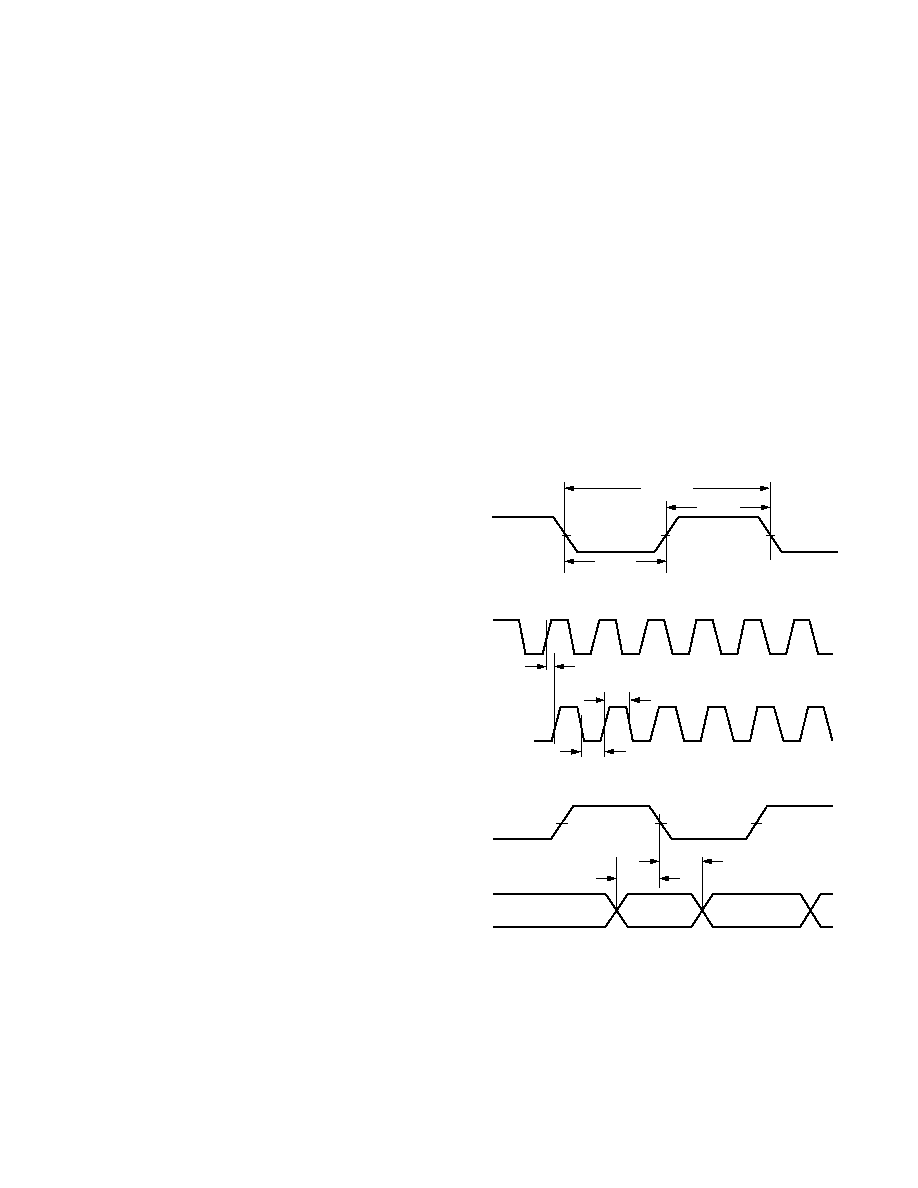
REV. 0
50
AD6634
address is set, External Address [0] DR0 must be the first data register
read to initiate an internal access. DR2 is only four bits wide.
Data written to the upper four bits of this register will be ignored.
Likewise reading from this register will produce only 4 LSBs.
Write Sequencing
Writing to an internal location is achieved by first writing the upper
two bits of the address to Bits 1 through 0 of the ACR. Bits 7:2 may
be set to select the channel as indicated above. The CAR is then
written with the lower eight bits of the internal address (it doesn't
matter if the CAR is written before the ACR as long as both are
written before the internal access). Data Register 2 (DR2) and
Register 1 (DR1) must be written first because the write to data
register DR0 triggers the internal access. Data register DR0 must
always be the last register written to initiate the internal write.
Read Sequencing
Reading from the microport is accomplished in the same manner.
The internal address is set up the same way as the write. A read
from data register DR0 activates the internal read, thus register DR0
must always be read first to initiate an internal read followed
by DR1 and DR2. This provides the 8 LSBs of the internal read
through the microport (D[7:0]). Additional data registers can be
read to read the balance of the internal memory.
Read/Write Chaining
The microport of the AD6634 allows for multiple accesses while
CS is held low (CS can be tied permanently low if the microport is
not shared with additional devices). The user can access multiple
locations by pulsing the
WR or RD line and changing the contents
of the external 3-bit address bus. External access to the external
registers of Table XIII is accomplished in one of two modes
using the
CS, RD, WR, and MODE inputs. The access modes
are Intel nonmultiplexed mode and Motorola nonmultiplexed
mode. These modes are controlled by the MODE input
(MODE = 0 for INM, MODE = 1 for MNM).
CS, RD, and WR
control the access type for each mode.
Intel Nonmultiplexed Mode (INM)
MODE must be tied Low to operate the AD6634 microprocessor
in INM mode. The access type is controlled by the user with the
CS, RD (DS), and WR (RW) inputs. The RDY (DTACK) signal
is produced by the microport to communicate to the user that an
access has been completed. RDY (
DTACK) goes Low at the
start of the access and is released when the internal cycle is
complete. See the timing diagrams for both the read and write
modes in the Specifications.
Motorola Nonmultiplexed Mode (MNM)
MODE must be tied High to operate the AD6634 microproces-
sor in MNM mode. The access type is controlled by the user
with the
CS, DS (RD), and RW (WR) inputs. The DTACK
(RDY) signal is produced by the microport to communicate to
the user that an access has been completed.
DTACK (RDY) goes
Low when an internal access is complete and then will return High
after
DS (RD) is deasserted. See the timing diagrams for both the
read and write modes in the Specifications.
SERIAL PORT CONTROL
The AD6634 has a serial port serving as a control interface apart
from the microport control interface. Serial port input pin (SDI)
can access all of the internal registers for all of the channels and
has pre-emptive access over the microport. In this manner, a single
DSP could be used to control the AD6634 over the serial port
control interface.
The serial control port uses the serial clock (SCLK). The
serial input port is self-framing as described below and allows
more efficient use of the serial input bandwidth for programming.
The beginning of a serial input frame is signaled by a Frame bit
that appears on the SDI pin. This is the MSB of the Serial Input
frame. After the frame bit has been sampled high on the falling
edge of SCLK, a state counter will start and enable an 11-bit
serial shifter four serial clock cycles later. These four SCLK cycles
represent the Don't Care bits of the serial frame that are ignored.
After all of the bits are shifted, the serial input port will pass
along the 8-bit data and 3-bit address to the arbitration block.
The serial word structure for the SDI input is illustrated in
Figure 47. Only 15 bits are listed so that the second bit in a
standard 16-bit serial word is considered the frame bit. This is
done for compatibility with the AD6620 serial input port. The
shifting order begins with frame and shifts the address MSB first
and then the data MSB first.
Serial Port Timing Specifications
The AD6634 serial control channel can operate only in the slave
mode. Figures 4446 indicate the required timing for each
specification.
SCLK
t
SCLK
t
SCLKH
t
SCLKL
Figure 44. SCLK Timing Requirements
t
SCLKH
t
SCLKL
t
DSCLKH
CLK
SCLK
Figure 45. SCLK Switching Characteristics (Divide by 1)
t
SSI
SCLK
SDI
DATA
t
HSI
Figure 46. Serial Input Data Timing Requirements
SDI
SDI is the Serial Data Input. Serial Data is sampled on the
falling edge of SCLK. This pin is used in the serial control
mode to write the internal control registers of the AD6634.
SCLK
SCLK is a clock input and the SDI input is sampled on the
falling edge of SCLK and all outputs are switched on the rising
edge of SCLK. The maximum speed of this port is 80 MHz.

REV. 0
AD6634
51
t
SSI
CLKn
X
FRAME
SCLK
SDI
FRAME
X
X
X
X
A2
A1
A0
D7
D6
D5
D4
D3
D2
D1
D0
Figure 47. Serial Word Structure and Serial Port Control Timing
JTAG BOUNDARY SCAN
The AD6634 supports a subset of IEEE Standard 1149.1 speci-
fication. For additional details of the standard, please see "IEEE
Standard Test Access Port and Boundary-Scan Architecture,"
IEEE-1149 publication from IEEE.
The AD6634 has five pins associated with the JTAG interface.
These pins are used to access the on-chip Test Access Port and
are listed in Table XVIII. All input JTAG pins are pull-up
except for TCLK, which is a pull-down.
Table XVIII. Boundary Scan Test Pins
Name
Pin Number
Description
TRST
67
Test Access Port Reset
TCLK
68
Test Clock
TMS
69
Test Access Port Mode Select
TDI
72
Test Data Input
TDO
70
Test Data Output
The AD6634 supports six op codes as shown in Table XIX.
These instructions set the mode of the JTAG interface.
Table XIX. Boundary Scan Op Codes
Instruction
Op Code
IDCODE
001
BYPASS
111
SAMPLE/PRELOAD
010
EXTEST
000
HIGHZ
011
CLAMP
100
The Vendor Identification Code can be accessed through the
IDCODE instruction and has the format shown in Table XX.
Table XX. Vendor ID Code
MSB
Part
Manufacturing
LSB
Version
Number
ID #
Mandatory
0000
0010
000 1110 0101
1
0111
1000
1100
A BSDL file for this device is available. Please contact Analog
Devices for more information.
EXTEST (3'b000)--Places the IC into an external boundary-test
mode and selects the boundary-scan register to be connected
between TDI and TDO. During this, the boundary-scan register
is accessed to drive test data off-chip via boundary outputs and
receive test data off-chip from boundary inputs.
IDCODE (3'b001)--Allows the IC to remain in its functional
mode and selects device ID register to be connected between TDI
and TDO. Accessing the ID register does not interfere with the
operation of the IC.
SAMPLE/PRELOAD (3'b010)--Allows the IC to remain in
normal functional mode and selects the boundary-scan register
to be connected between TDI and TDO. The boundary-scan
register can be accessed by a scan operation to take a sample of
the functional data entering and leaving the IC. Also, test data
can be preloaded into the boundary scan register before an
EXTEST instruction.
HIGHZ (3'b011)--Sets all outputs to high impedance state. Selects
1-bit bypass register to be connected between TDI and TDO.
CLAMP (3'b100)--Sets the outputs of the IC to logic levels
determined by the boundary-scan register and selects 1-bit bypass
register to be connected between TDI and TDO. Before this
instruction, boundary-scan data can be preloaded with the
SAMPLE/PRELOAD instruction.
BYPASS (3'b111)--Allows the IC to remain in normal functional
mode and selects 1-bit bypass register between TDI and TDO.
During this instruction, serial data is transferred from TDI to TDO
without affecting operation of the IC.
INTERNAL WRITE ACCESS
Up to 20 bits of data (as needed) can be written by the process
described below. Any high order bytes that are needed are written
to the corresponding data registers defined in the external 3-bit
address space. The least significant byte is then written to DR0
at address (000). When a write to DR0 is detected, the internal
microprocessor port state machine then moves the data in
DR2DR0 to the internal address pointed to by the address in
the LAR and AMR.
Write Pseudocode
void write_micro(ext_address, int data);
main();
{
/
* This code shows the programming of the NCO phase offset
register using the write_micro function as defined above. The
variable address is the External Address A[2:0] and data is the
value to be placed in the external interface register.
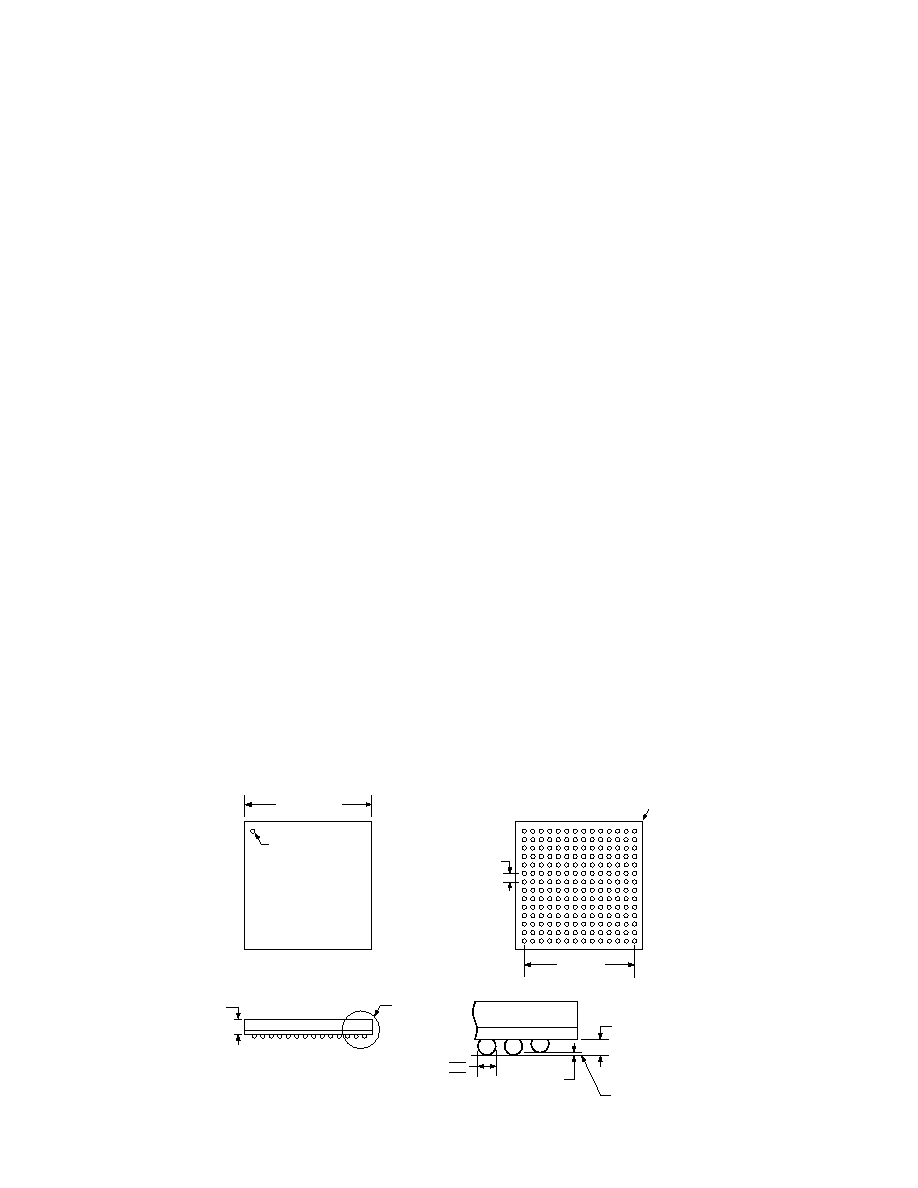
REV. 0
C0303208/02(0)
PRINTED IN U.S.A.
52
AD6634
Internal Address = 0x087
*/
// holding registers for NCO phase byte wide access data
int d1, d0;
// NCO frequency word (16-bits wide)
NCO_PHASE = 0xCBEF;
// write ACR
write_micro(7, 0x03 );
// write CAR
write_micro(6, 0x87);
// write DR1 with D[15:8]
d1 = (NCO_PHASE & 0xFF00) >> 8;
write_micro(1, d1);
// write DR0 with D[7:0]
// On this write all data is transferred to the internal address
d0 = NCO_FREQ & 0xFF;
write_micro(0, d0);
} // end of main
INTERNAL READ ACCESS
A read is performed by first writing the CAR and AMR as with
a write. The data registers (DR2DR0) are then read in the
reverse order that they were written. First, the Least Significant
Byte of the data (D[7:0]) is read from DR0. On this transaction
the high bytes of the data are moved from the internal address
pointed to by the CAR and AMR into the remaining data registers
(DR2DR1). This data can then be read from the data registers
using the appropriate 3-bit addresses. The number of data registers
used depends solely on the amount of data to be read or written.
Any unused bit in a data register should be masked out for a read.
Read Pseudocode
int read_micro(ext_address);
main();
{
/
* This code shows the reading of the first RCF coefficient
using the read_micro function as defined above. The variable
address is the External Address A[2..0].
Internal Address = 0x000
*/
// holding registers for the coefficient
int d2, d1, d0;
// coefficient (20-bits wide)
long coefficient;
// write AMR
write_micro(7, 0x00 );
// write LAR
write_micro(6, 0x00);
/
* read D[7:0] from DR0. All data is moved from the Internal
Registers to the interface registers on this access.
*/
d0 = read_micro(0) & 0xFF;
// read D[15:8] from DR1
d1 = read_micro(1) & 0xFF;
// read D[23:16] from DR2
d2 = read_micro(2) & 0x0F;
coefficient = d0 + (d1 << 8) + (d2 << 16);
} // end of main
OUTLINE DIMENSIONS
196-Lead Chip Scale Ball Grid Array [CSPBGA]
(BC-196)
Dimensions shown in millimeters
DETAIL A
1.70
MAX
SEATING PLANE
0.30 MIN
DETAIL A
0.70
0.60
0.50
BALL
DIAMETER
0.20
COPLANARITY
13.00 BSC
SQ
A
B
C
D
E
F
G
H
J
K
L
M
N
P
14 13 12 11 10 9 8 7 6 5 4 3 2 1
1.00 BSC
BALL PITCH
15.00 BSC SQ
TOP VIEW
BOTTOM VIEW
A1 CORNER
COMPLIANT TO JEDEC STANDARDS MO-192AAE-1
Document Outline
- FEATURES
- APPLICATIONS
- FUNCTIONAL BLOCK DIAGRAM
- TABLE OF CONTENTS
- GENERAL DESCRIPTION
- ARCHITECTURE
- ABSOLUTE MAXIMUM RATINGS
- THERMAL CHARACTERISTICS
- EXPLANATION OF TEST LEVELS
- ORDERING GUIDE
- SPECIFICATIONS
- RECOMMENDED OPERATING CONDITIONS
- ELECTRICAL CHARACTERISTICS
- GENERAL TIMING CHARACTERISTICS
- MICROPROCESSOR PORT TIMING CHARACTERISTICS
- TIMING DIAGRAMS
- TIMING DIAGRAMSINM MICROPORT MODE
- TIMING DIAGRAMSMNM MICROPORT MODE
- PIN CONFIGURATION
- PIN FUNCTION DESCRIPTIONS
- EXAMPLE FILTER RESPONSE
- INPUT DATA PORTS
- Input Data Format
- Input Timing
- Input Enable Control
- Gain Switching
- Input Data Scaling
- Scaling with Fixed-Point ADCs
- Scaling with Floating-Point or Gain-Ranging ADCs
- NUMERICALLY CONTROLLED OSCILLATOR
- Frequency Translation
- NCO Frequency Hold-Off Register
- Phase Offset
- NCO Control Register
- Bypass
- Phase Dither
- Amplitude Dither
- Clear Phase Accumulator on HOP
- Input Enable Control
- Mode 00: Blank on IEN Low
- Mode 01: Clock on IEN High
- Mode 10: Clock on IEN Transition to High
- Mode 11: Clock on IEN Transition to Low
- WB Input Select
- Sync Select
- SECOND ORDER rCIC FILTER
- rCIC2 Rejection
- Example Calculations
- Decimation and Interpolation Registers
- rCIC2 Scale
- FIFTH ORDER CIC FILTER
- RAM COEFFICIENT FILTER
- RCF Decimation Register
- RCF Decimation Phase
- RCF Filter Length
- RCF Output Scale Factor and Control Register
- INTERPOLATING HALF-BAND FILTERS
- AUTOMATIC GAIN CONTROL
- The AGC Loop
- Desired Signal Level Mode
- Desired Clipping Level Mode
- Synchronization
- USER CONFIGURABLE BUILT-IN SELF-TEST (BIST)
- CHIP SYNCHRONIZATION
- Start
- Start with No Sync
- Start with Soft Sync
- Start With Pin Sync
- Hop
- Set Freq No Hop
- Hop with Soft Sync
- Hop with Pin Sync
- PARALLEL OUTPUT PORTS
- Channel Mode
- AGC Mode
- Master/Slave PCLK Modes
- Parallel Port Pin Functionality
- LINK PORT
- Link Port Data Format
- Link Port Timing
- TigerSHARC Configuration
- MEMORY MAPS
- 0x00
0x7F: Coefficient Memory(CMEM)
- 0x80: Channel Sleep Register
- 0x81: Soft_SYNC Register
- 0x82: Pin_SYNC Register
- 0x83: Start Hold-Off Counter
- 0x84: NCO Frequency Hold-Off Counter
- 0x85: NCO Frequency Register 0
- 0x86: NCO Frequency Register 1
- 0x87: NCO Phase Offset Register
- 0x88: NCO Control Register
- 0x90: rCIC2 Decimation
1 (MrCIC2
1)
- 0x91: rCIC2 Interpolation
1 (LrCIC2
1)
- 0x92: rCIC2 Scale
- 0x93:
- 0x94: CIC5 Decimation
1 (MCIC5
1)
- 0x95: CIC5 Scale
- 0x96:
- 0xA0: RCF Decimation
1 (MRCF
1)
- 0xA1: RCF Decimation Phase (PRCF)
- 0xA2: RCF Number of Taps
1 (NTAPS
1)
- 0xA3: RCF Coefficient Offset (CORCF)
- 0xA4: RCF Control Register
- 0xA5: BIST Register for I
- 0xA6: BIST Register for Q
- 0xA7: BIST Control Register
- 0xA8: RAM BIST Control Register
- 0xA9: Output Control Register
- Input Port Control Registers
- 0x00 Lower Threshold A
- 0x01 Upper Threshold A
- 0x02 Dwell Time A
- 0x03 Gain Range A Control Register
- 0x04 Lower Threshold B
- 0x05 Upper Threshold B
- 0x06 Dwell Time B
- 0x07 Gain Range B Control Register
- 0x08 Port A Control Register
- 0x09 Port B Control Register
- 0x0A AGC A Control Register
- 0x0B AGC A Hold-Off Counter
- 0x0C AGC A Desired Level
- 0x0D AGC A Signal Gain
- 0x0E AGC A Loop Gain
- 0x0F AGC A Pole Location
- 0x10 AGC A Average Samples
- 0x11 AGC A Update Decimation
- 0x12 AGC B Control Register
- 0x13 AGC B Hold-Off Counter
- 0x14 AGC B Desired Level
- 0x15 AGC B Signal Gain
- 0x16 AGC B Loop Gain
- 0x17 AGC B Pole Location
- 0x18 AGC B Average Samples
- 0x19 AGC B Update Decimation
- 0x1A Parallel Port Control A
- 0x1B Link Port Control A
- 0x1C Parallel Port Control B
- 0x1D Link Port Control B
- 0x1E Port Clock Control
- MICROPORT CONTROL
- External Memory Map
- Access Control Register (ACR)
- Channel Address Register (CAR)
- SOFT_SYNC Control Register
- PIN_SYNC Control Register
- SLEEP Control Register
- Data Address Registers
- Write Sequencing
- Read Sequencing
- Read/Write Chaining
- Intel Nonmultiplexed Mode (INM)
- Motorola Nonmultiplexed Mode (MNM)
- SERIAL PORT CONTROL
- Serial Port Timing Specifications
- SDI
- SCLK
- JTAG BOUNDARY SCAN
- INTERNAL WRITE ACCESS
- INTERNAL READ ACCESS
- OUTLINE DIMENSIONS



















































